Indigenous peoples of the Americas are the first people who lived in North America or South America, and their descendants. Indigenous means original or native. Indigenous people had been living in the Americas for thousands of years before any Europeans arrived.
When Europeans first came to the Americas, almost every group of Indigenous Americans had its own name. Many of these names reflected each group’s pride in itself and its way of life. For example, the Delaware people of eastern North America called themselves Lenape, which means genuine people. Today, most Indigenous people refer to themselves primarily by the name of their own group, tribe, or nation. When referring to such groups together as a whole, many Indigenous people in the United States use the term Native Americans. Many descendants of the first peoples of Canada prefer the term First Nations. Other Indigenous peoples of Canada include the Inuit of the Arctic, and the Métis—people of mixed European and First Nations heritage.
The Vikings of northern Europe are believed to have explored the east coast of North America about A.D. 1000 and to have had some contact there with Indigenous people. But lasting contact between the first Americans and Europeans began with Christopher Columbus’s voyages to the Americas. In 1492, Columbus sailed across the Atlantic Ocean from Spain. He was seeking a short sea route to the Indies, which then included India, China, the East Indies, and Japan. Europeans did not then know that North and South America existed. When Columbus landed on an island in the Caribbean Sea, he did not realize he had come to a New World. He thought he had reached the Indies, and so he called the people he met Indians. For this reason, Indigenous Americans are sometimes called American Indians.
Most scientists think people first came to the Americas from Asia at least 15,000 years ago. Other scientists believe people may have arrived as early as 35,000 years ago. At the time these people came, huge ice sheets covered much of the northern half of Earth. As a result, much of Earth that is now underwater was dry land. One such area that was dry then but is submerged now is the Bering Strait, which today separates the region of Siberia in Russia and the state of Alaska in the United States. The migrants, following the animals that they hunted, wandered across this land, a distance of about 50 miles (80 kilometers). By 12,500 years ago, the first Americans and their descendants had spread throughout the New World and were living from the Arctic in the north to southern South America.

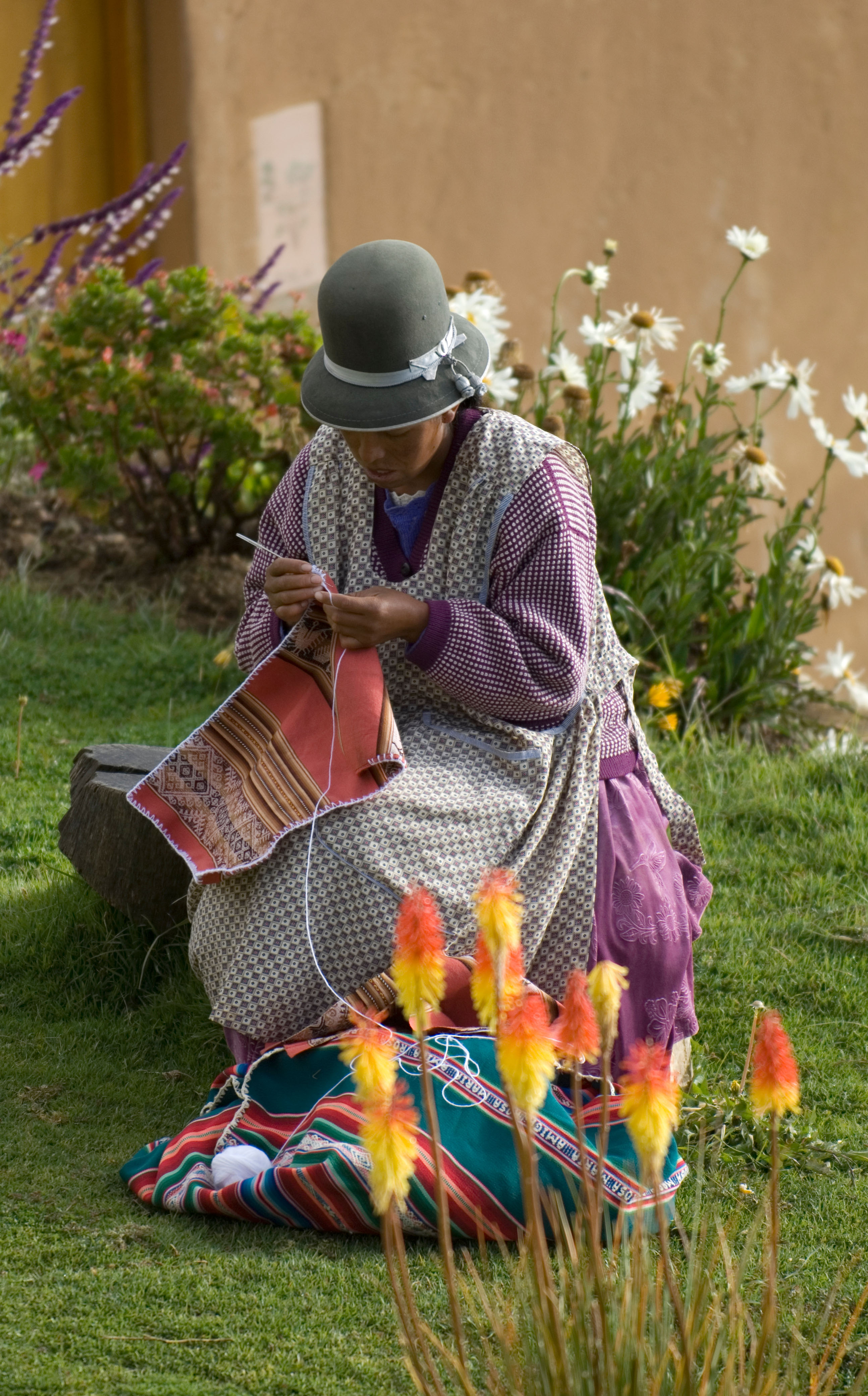
The Indigenous peoples of the Americas spoke hundreds of different languages and had many different ways of life. Some groups lived in great cities and others in small villages. Still others kept moving all year long, hunting animals and gathering wild plants.
The Aztec and the Maya of Central America built large cities. Some of the Aztec cities had as many as 100,000 people. The Maya built special buildings in which they studied the moon, the stars, and the sun. They also developed a calendar and a system of writing. 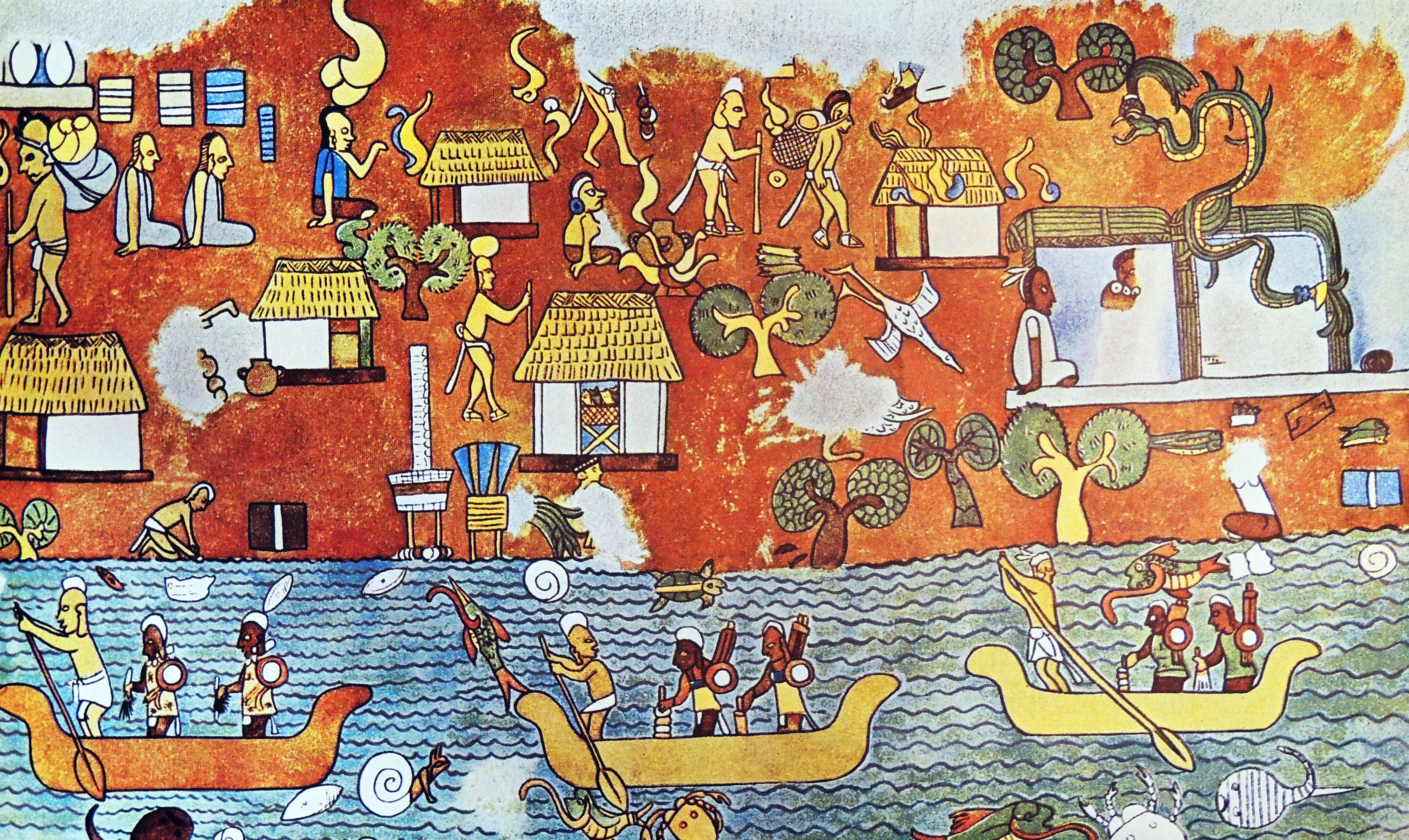
Many of the people of eastern North America lived in villages. They hunted and farmed, growing such crops as maize (corn), beans, and squash. At the southern tip of South America, people lived in small bands that moved from place to place in search of food. They ate mainly fish and berries. The peoples of this region spent so much time searching for food that they seldom built permanent shelters, made clothes, or developed tools.
The history of the New World includes the story of relations between Indigenous groups and European explorers, trappers, and settlers. Most of the encounters between Indigenous and European people were friendly at first. Indigenous people taught the newcomers many things. European explorers followed trails forged by Indigenous Americans to sources of water and deposits of copper, gold, silver, turquoise, and other minerals. Indigenous people taught Europeans to make snowshoes and toboggans and to travel by canoe. Food was another of the important gifts provided to the Europeans. Indigenous people grew many foods that the newcomers had never heard of, such as avocados, corn, peanuts, peppers, pineapples, potatoes, squash, and tomatoes. They also introduced the Europeans to tobacco.
The Indigenous peoples of the Americas, in turn, learned much from white people. The Europeans brought many goods that were new to the Americas. These goods included metal tools, guns, and liquor. The Europeans also brought cattle and horses, which were unknown to the Indigenous people of the Americas.
The Europeans and the Indigenous people had widely different ways of life. Some Europeans tried to understand the ways of Indigenous people and treated them fairly. But others cheated them and took their land. When Indigenous people fought back, thousands of them were killed in battle. At first, they had only bows and arrows and spears, while the Europeans had guns. Even more Indigenous people died from measles, smallpox, and other new diseases introduced by Europeans.
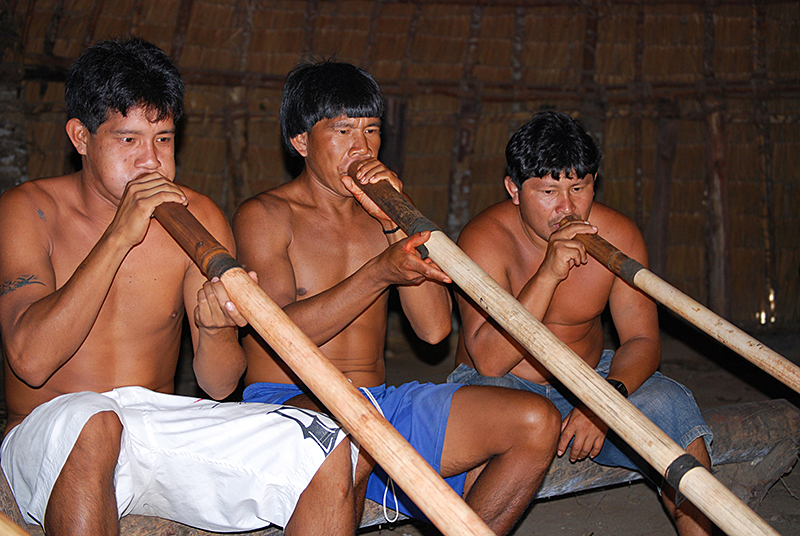
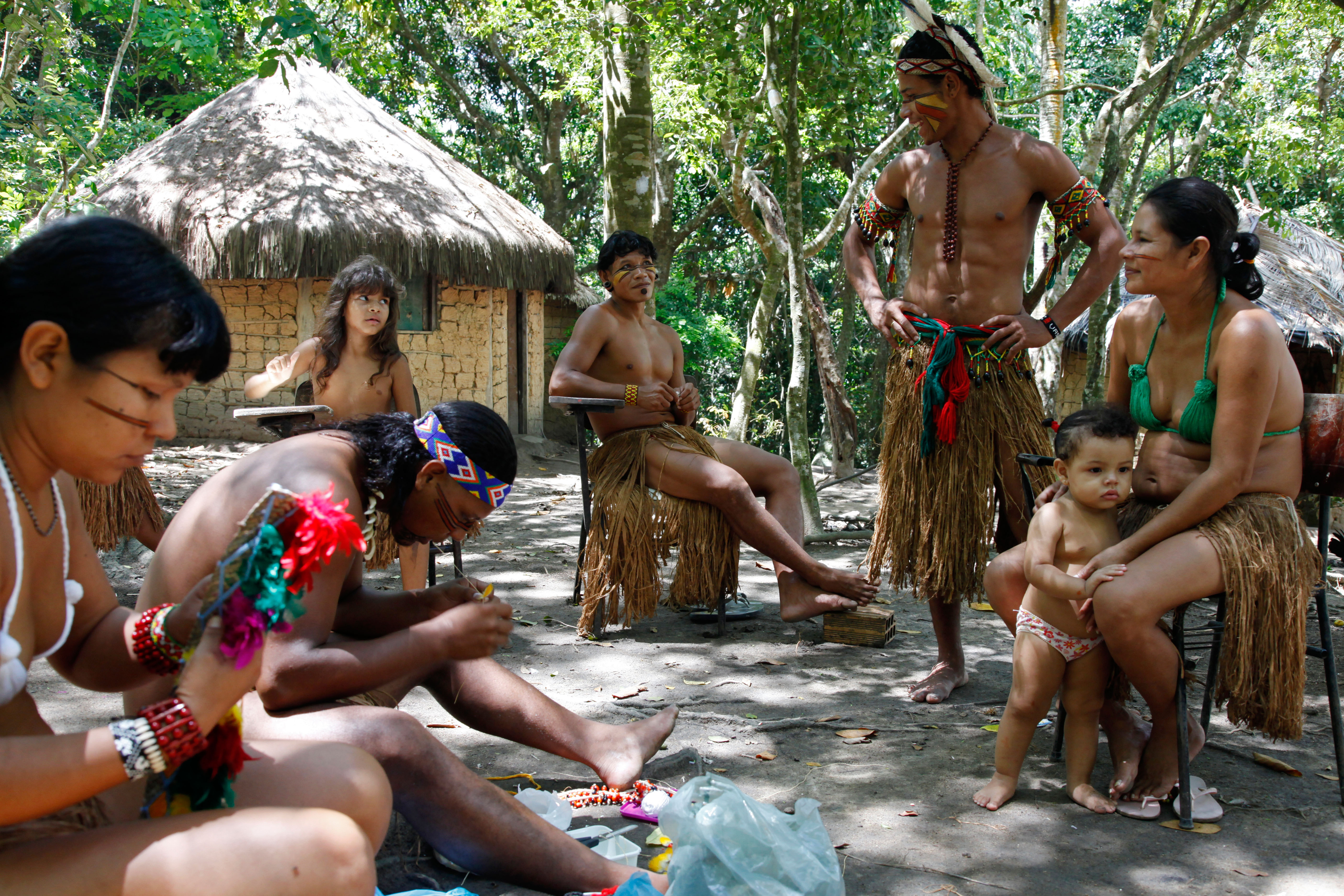
As the Europeans and their descendants moved westward across North America, they became a greater and greater threat to Indigenous ways of life. Centuries later, most of the remaining Indigenous people were moved onto lands known as reservations or reserves. Today, most of the descendants of the first peoples of North America still do not completely follow the ways of other North Americans. In some areas of Central and South America, several tribes have kept their language and way of life. But most of the tribes have become part of a new way of life that is both Indigenous and European.
Scholars called anthropologists, who study human culture, classify the hundreds of North and South American Indigenous tribes into groups of tribes with strong similarities. These groups are called culture areas. This article discusses Indigenous groups in terms of 15 culture areas. The culture areas of Canada and the United States are (1) the Arctic; (2) the Subarctic; (3) the Northeast, often called the Eastern Woodlands; (4) the Southeast; (5) the Plains; (6) the Northwest Coast; (7) California; (8) the Great Basin; (9) the Plateau; and (10) the Southwest. Those of Latin America are (1) Middle America, (2) the Caribbean, (3) the Andes, (4) the Tropical Forest, and (5) the South American Marginal Regions.
The first part of this article describes the family life and other activities of the North and South American peoples before Europeans came. Then the article tells how the first Americans came to the New World and spread over the two continents. Next it describes the ways of life in the culture areas. The article then traces the destruction of Indigenous America and ends with a discussion of Indigenous people in the Americas today.
Family life
Most daily activities of an Indigenous American family centered on providing the main necessities of life—food, clothing, and shelter. Some times of the year were busier than others. Among the salmon-fishing tribes of North America, for example, the spring and summer were the seasons for catching and storing fish. The winter was a relaxed time of year when many ceremonies and social gatherings were held.
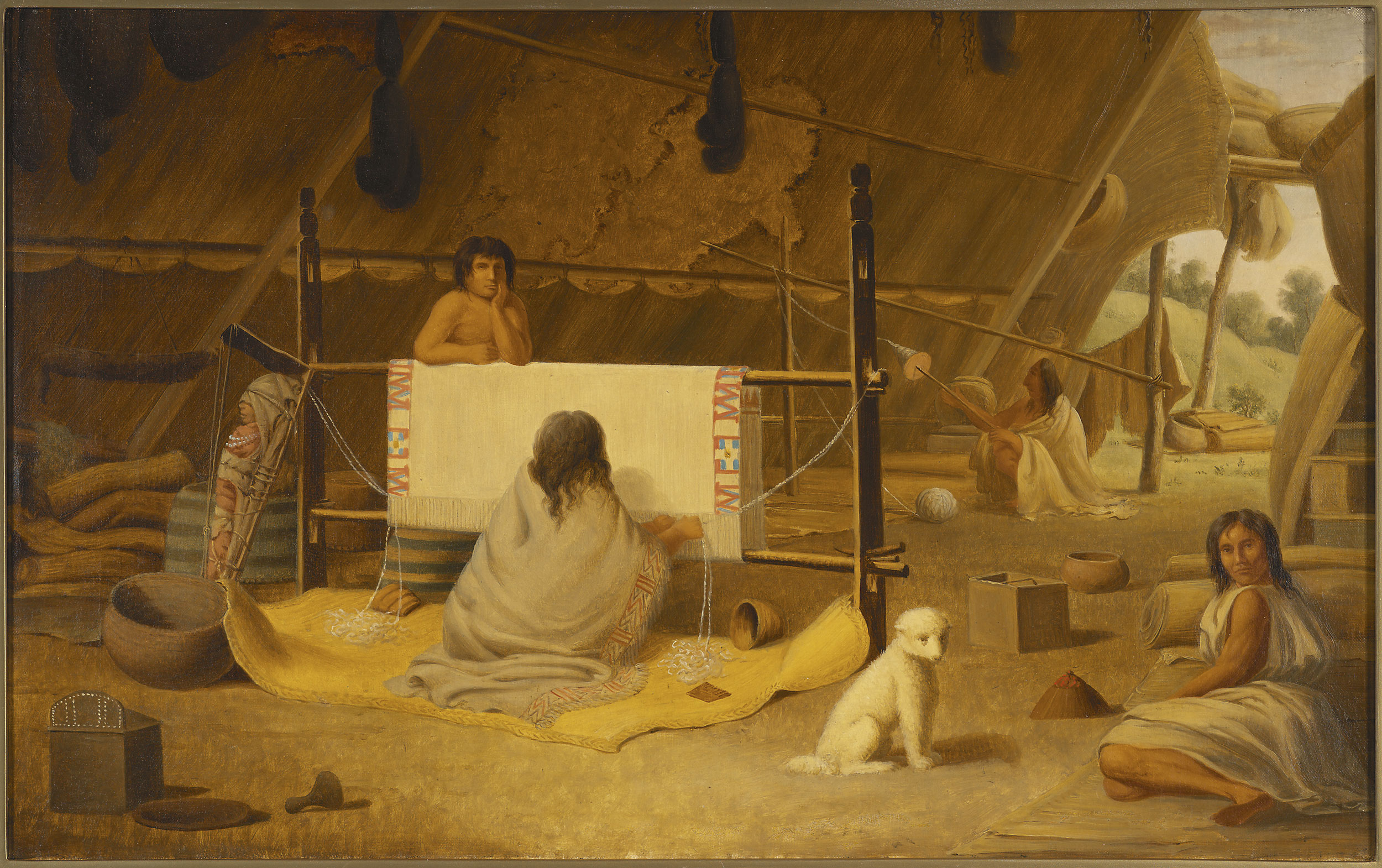
Men and women usually had separate tasks. For example, both men and women were often involved in providing food. But they did so in different ways. In some areas, the women gathered wild plants for food, and the men hunted. In the Northeast and Southeast culture areas, the men hunted, and the women farmed the land. In parts of what are now Arizona and New Mexico and in Middle and South America, the men did the farming. The women gathered plants. In all areas, women were generally responsible for preparing the food.
Marriage.
Many Indigenous people married at an early age—the girls between 13 and 15 and the boys between 15 and 20. In some tribes, the parents or other relatives chose the marriage partners for the young people. In other tribes, especially those of North America, a young man could select his own mate. He had to convince the girl and her parents that he would make a suitable husband. In many cases, he offered them valuable gifts to win their consent.
Throughout most of the New World, marriage was a family affair and not a religious ceremony. The boy’s family usually gave presents to the bride’s family. Many newly married couples lived with the girl’s family—and the husband worked for her family—until the birth of a child. Then the couple might establish their own home. But they generally did not move to a new home in a new area. Many other newly married couples joined an existing family group or lived close to one. Some of the couples moved in with other relatives of the woman or with the relatives of the man. This extended family shared the daily work of the household, including the raising of children.
Many Indigenous American societies allowed men to have more than one wife. But this practice was more common among rich or powerful men. Certain tribes strictly limited men to one mate, such as the Iroquois and the Pueblo of North America.
After a man died, his wife would often live with his brother as husband and wife—even if the brother was already married. Similarly, if a woman died, her family would probably be expected to give her husband another unmarried daughter to replace her.
Children.
Most Indigenous American families were small because many children died at birth or as babies. But the youngsters usually had plenty of playmates. Many extended families included cousins, in addition to a child’s own brothers and sisters.
Children were praised when they behaved well and shamed when they misbehaved. Before the arrival of Europeans, only the Aztec and Inca had regular schools. Boys and girls of other Indigenous groups learned to perform men’s and women’s jobs by helping their parents and older brothers and sisters. Games made Indigenous children skillful and strong.
After most boys reached their early teens, they went through a test of strength or bravery called an initiation ceremony. Many went without food for a long period or lived alone in the wilderness. In some tribes, a boy was expected to have a vision of the spirit that would become his lifelong guardian. Some groups also had initiation ceremonies for girls. A teenager who successfully completed an initiation ceremony was considered an adult and ready to be married.
Family groups.
In many areas, a family group was even larger than an extended family. A clan, for example, consisted of a group of relatives who had a common ancestor. The members of a clan typically were related through either the men of the family or through the women, but not through both. Clan members were usually ready to help one another.
Another type of group was the association. Associations resembled clans, but the members were not related. The tribes of the North American Plains had associations for men. Many of these groups were organized according to age classes. Youths joined a boys’ association and then moved on to other associations at various stages in their lives. As adults, they could join warrior societies and other associations.
Sometimes tribes were divided into halves called moieties (pronounced MOY uh teez). Moieties often played each other in games. They also divided various tasks and responsibilities. For example, members of one moiety might help with the burial of members of another group and comfort them in time of mourning.
Food
that Indigenous people ate depended on where they lived. Tribes that lived on the plains of what is now the United States, where buffalo and other game were plentiful, ate mainly meat. Meat was also the principal food of the peoples who inhabited the woodlands and tundra (frigid treeless plain) of present-day Alaska and Canada. The Pueblo of the Southwest and other farming groups lived chiefly on beans, corn, and squash. Potatoes were an important crop among the Inca. Indigenous groups in the tropical areas of South America made bread from the roots of bitter cassava, a small shrub. Tribes that lived near water caught fish and gathered shellfish. Most Indigenous groups ate berries, nuts, roots, seeds, and wild plants. They also gathered salt and collected maple sap wherever they could.
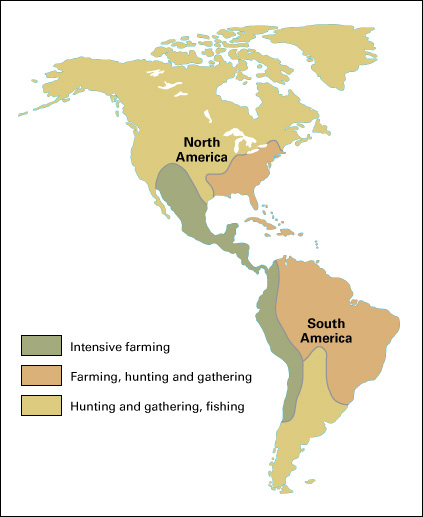
Indigenous people made a kind of tea from such plants as sassafras and wintergreen. Many Middle and South American people drank a mild beer that was known as chicha. They made it from corn, cassava, peanuts, or potatoes.
Indigenous people who ate mostly meat cooked it by roasting, broiling, or boiling. Farming peoples and others who ate chiefly vegetables developed various methods of boiling or baking. They often made pit ovens by lining holes in the ground with hot stones. Meat was preserved by smoking it or by drying it in the sun. Indigenous people in North America mixed dried meat with grease and berries to make a food called pemmican. Most people ate with their fingers, but some used spoons made from animal bones, shells, or wood.
Clothing.
Many Indigenous people made their clothes from animal skins and fur. Tanned deer hide, called buckskin, was one of the most common clothing materials throughout North America. Other materials included buffalo hides, rabbit fur, and bird feathers. Some tribes of the Northwest Coast of North America made cloth of bark and reeds, and the Pueblo wove cotton cloth. The Aztec, Inca, Maya, and some Caribbean peoples wove beautiful cloth made of cotton and wool.
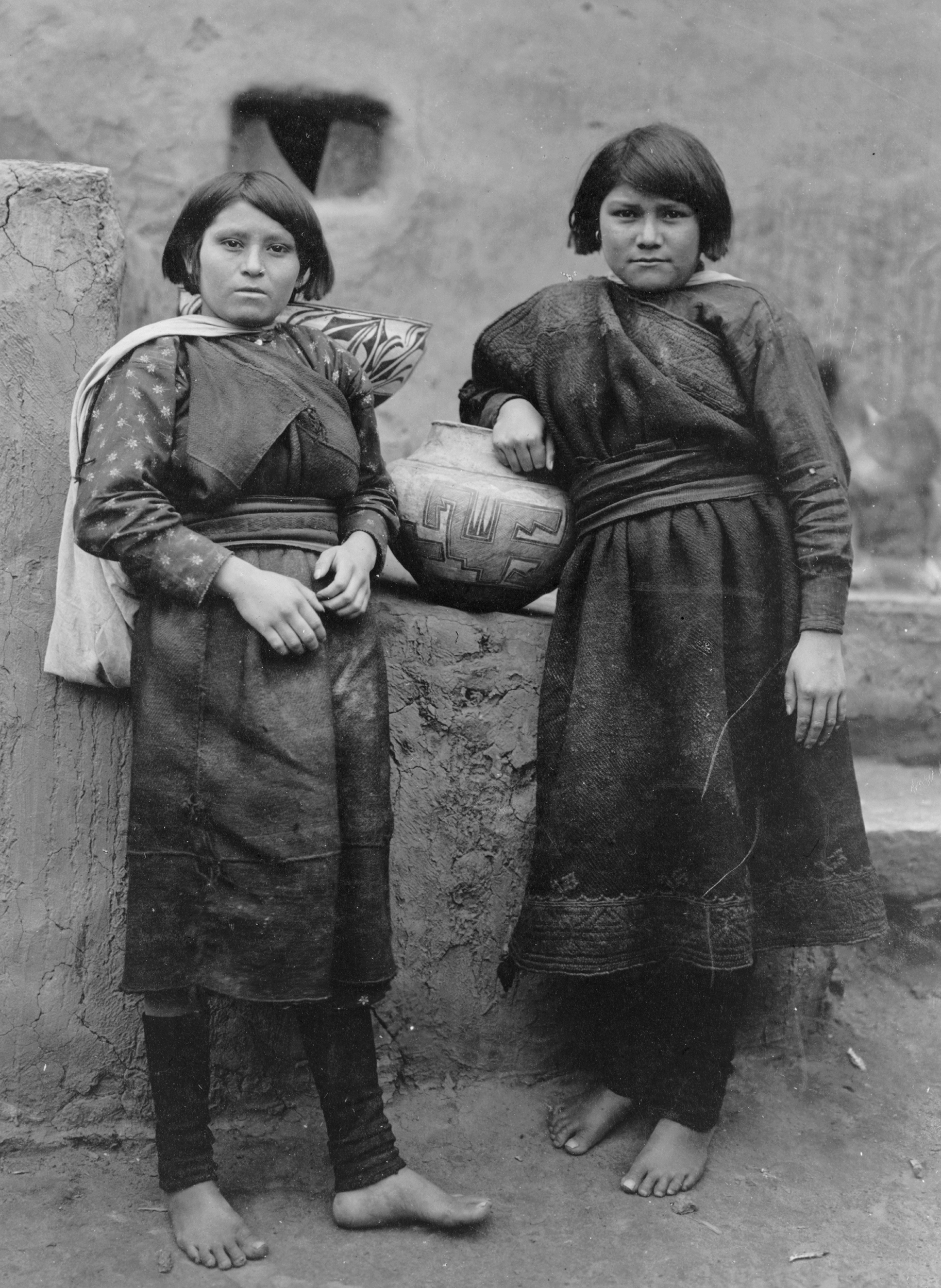
People of the South American tropics often wore little or no clothing at all. In many tribes, a man wore only a breechcloth, a narrow band of cloth that passed between the legs and looped over the front and rear of a belt. Women wore simple aprons or skirts. Inhabitants of colder climates wore leggings, shirts, and robes. Some wore sandals or moccasins to protect their feet.
Shelter.
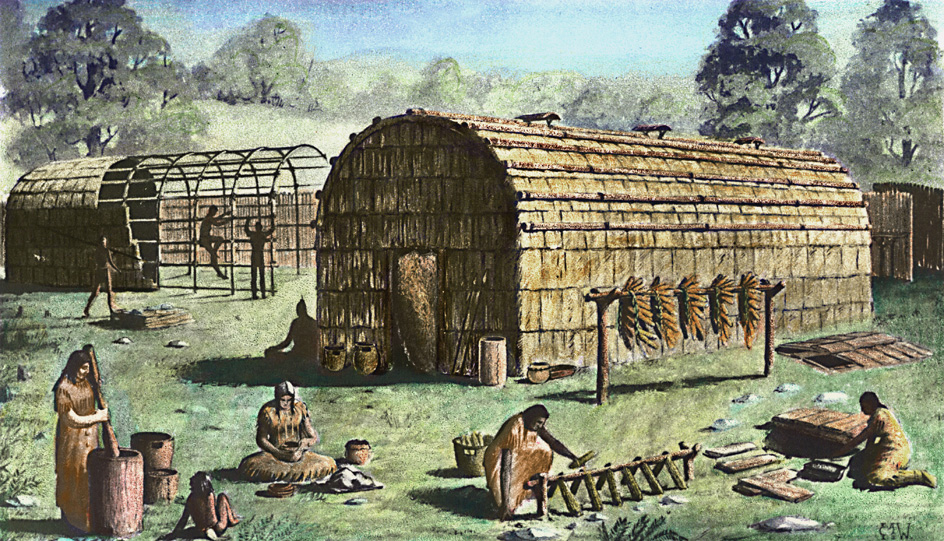
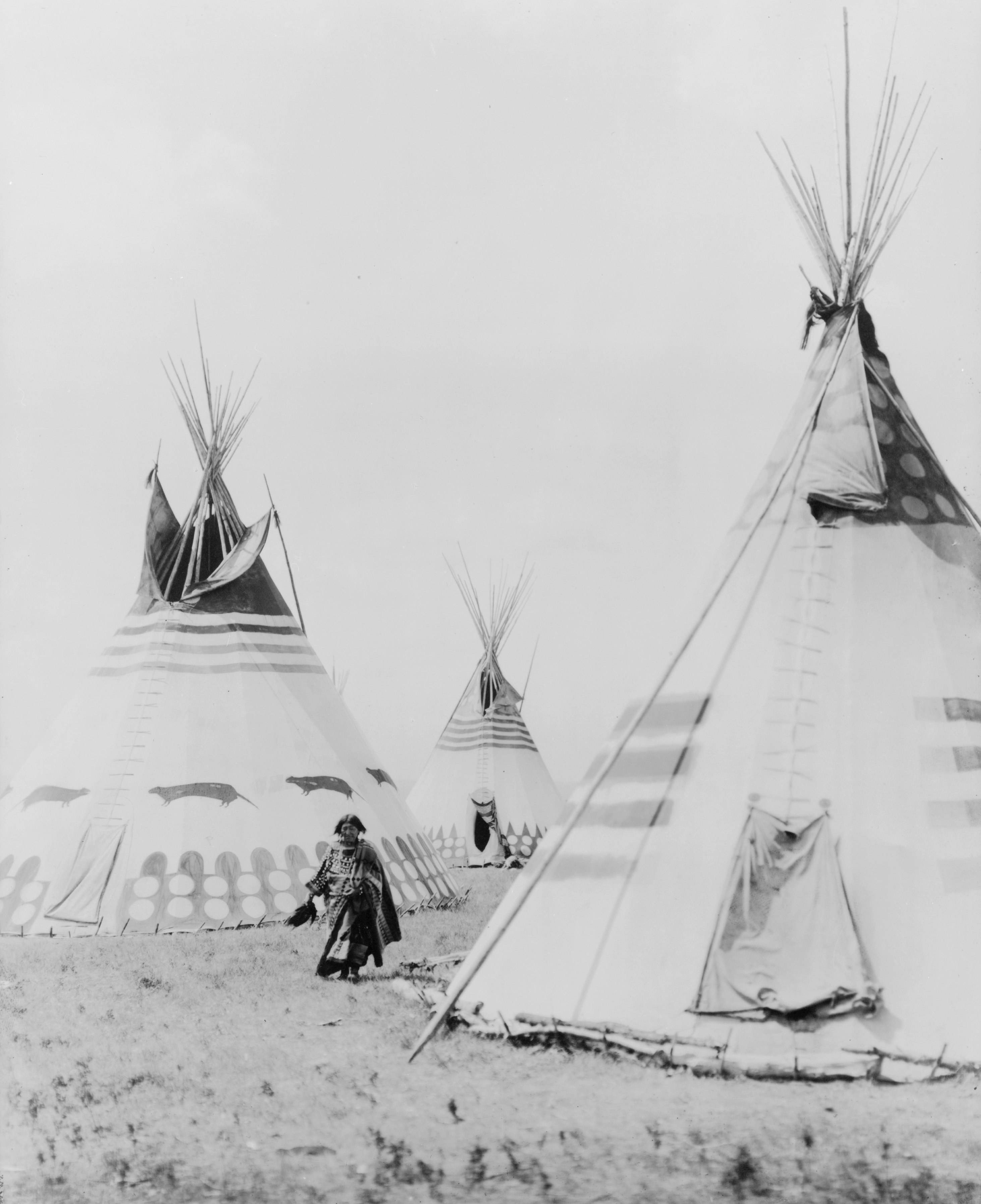
Many Indigenous people built a pole framework and covered it with leaves or bark, like the dome-shaped wigwam of the Northeast. The Iroquois followed a similar method in building their long, rectangular longhouses. The Iroquois called themselves the Haudenosaunee. This name refers to their dwellings and means we longhouse builders. Some longhouses were more than 100 feet (30 meters) long. The Apache and Paiute used brush and matting to make simple wickiups. The Pawnee and some other North American tribes made earth lodges. These had a log framework covered by brush, grass, and earth. In some cases, the framework was placed over a shallow pit. Poles or logs covered with earth formed the Navajo hogan. The Plains peoples built cone-shaped tipis (also spelled tepees) of buffalo skins. In other areas, people covered their tipis with animal skins or with tree bark. Groups living at the southern tip of South America also used skins to cover shelters called windbreaks, which were open on one side. The cliff dwellers and other Pueblo peoples used adobe (sun-dried bricks) to make many-storied “apartment houses.” Indigenous groups in Mexico and in the Andes Mountains of South America also used adobe.
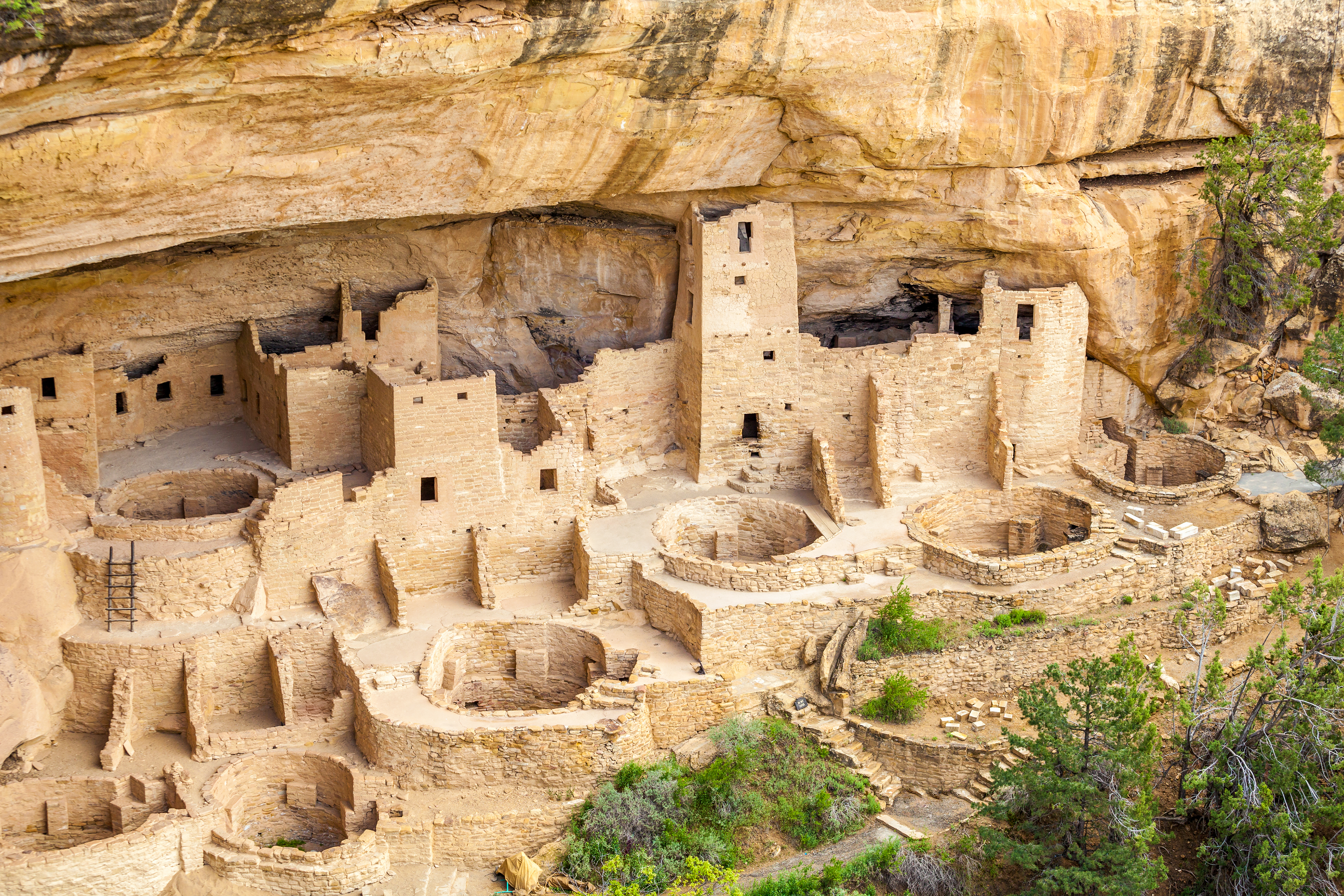
Hunting, gathering, and fishing.
The Indigenous peoples of the Arctic, Subarctic, Northwest Coast, and some other areas hunted or fished for most of their food. They also hunted some birds only for the feathers, and they prized the fur of beavers and certain other animals. The people of California, the Great Basin, and the Plateau got most of their food by gathering wild seeds, nuts, and roots. Even in the Southwest and other farming areas, hunting, gathering, and fishing were important.
The most important game animals of North and South America included deer; rabbits and other small game; such birds as ducks, geese, and herons; such sea mammals as seals, sea lions, and whales; turtles; and snakes. Bear, buffalo, caribou, elk, and moose lived only in North America. Animals that were hunted mainly in South America included the guanaco, jaguar, peccary, rhea, and tapir.
Indigenous people hunted with the same kinds of weapons they used in war. Many bows and arrows, spears, and clubs had special features for hunting. For example, some hunters used unsharpened arrows to shoot birds in trees. These arrows stunned the birds so that they fell to the ground. The Hopi stunned small game with a kind of boomerang.
Indigenous people caught fish with harpoons, hooks and lines, spears, and traps and nets. Tribes of the Northwest Coast also used long poles called herring rakes. These poles had jagged points and could catch a number of herring at one time. In tropical South America, people stood on river sand bars and shot fish with bows and arrows. Both North and South American peoples used drugs to catch fish. In one method, Indigenous people chopped up certain plants and threw them in the water. These plants stunned the fish. Then the fish could be easily scooped out of the water. 
Farming
by the Indigenous peoples of the Americas consisted mainly of growing corn, squash, and beans. Other crops included avocados, cacao, cassava, coca, cotton, guavas, peanuts, peppers, potatoes, tobacco, and tomatoes.

Farming tools included pointed sticks for digging and hoes made of wood, stone, bone, or shell. Farmers planted corn in small hills arranged in rows. Some tribes of eastern North America used dead fish to fertilize the soil. In the desert areas of the Southwest, the early Hohokam people dug long irrigation ditches to bring water to their crops. Irrigation was even more highly developed among the groups that lived in what is now Mexico and among the peoples of the Andes Mountains. These people also cut hillside terraces to increase the amount of farmland by using mountain slopes.
Indigenous people of the Northeast and the Tropical Forest used slash-and-burn farming methods. They cut down a number of trees and burned them. Then they planted their crops among the trunks. The ashes from the burned trees served as fertilizer.
Indigenous people in the Caribbean area and in what are now Mexico and the Southern United States raised turkeys. Andean people kept llamas and alpacas for food and wool and also used them as beasts of burden. Dogs were the only other tame animals in North and South America.
Transportation.
Before the arrival of the Europeans, Indigenous people lacked horses, oxen, and most other beasts of burden used in other parts of the world. As a result, the first Americans never developed the wagon wheel, though they had discovered its principle. The Inca and Maya built excellent roads, but most other Indigenous groups used narrow trails.
Travel by water was the most common means of transportation. Many travelers used bark canoes, which were light and easy to carry. Some large dugout canoes carried as many as 60 people. People also made light boats of reeds. The Plains people stretched buffalo skins over a round frame to make a bullboat. Inhabitants of the snowy north developed snowshoes and toboggans. Some favored groups, such as Inca nobles, traveled on wooden frames carried by servants.
The first Americans had few ways of carrying loads. The Plains tribes used dogs and, later, horses to pull a load-carrying frame called a travois << truh VOY >>. Andean peoples used alpacas and llamas as beasts of burden. But these animals could not carry heavy loads, so the people themselves carried most of their goods. People often supported a heavy load on their back with a pack strap called a tumpline. The strap was attached to both ends of the pack and stretched across the forehead.
Recreation.
Almost all Indigenous people played games. Men and women usually played separately and had different games. Children played almost all the games that their parents enjoyed.
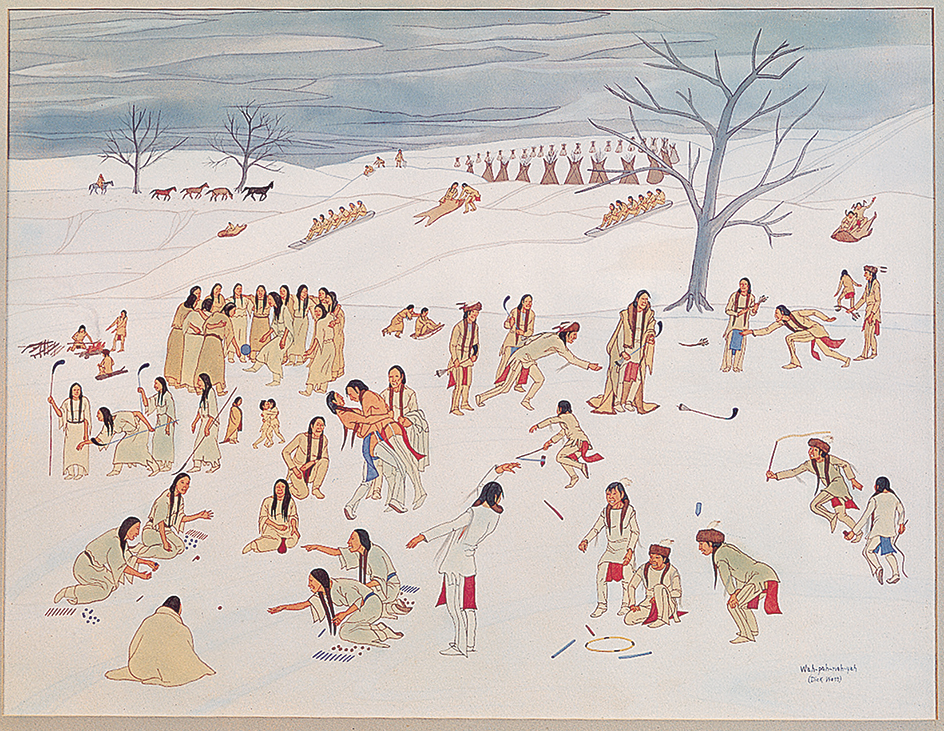
Footracing was popular in many areas. The Indigenous people of what are now northern Mexico and the southwestern United States particularly enjoyed this sport and sometimes ran over a 30-mile (48-kilometer) course. Indigenous Americans played many different kinds of ball games. In almost all these games, the players were not allowed to touch the ball with their hands. Stickball developed into the game of lacrosse. Usually, only women played shinny, or shinty, a kind of field hockey that was common in North America. The Aztec and Maya played a ceremonial game in which the players tried to bounce a large, hard rubber ball through a high vertical ring with their hips. Scoring was so difficult that the game ended when either team scored. In some cases, the captain of the losing team was sacrificed to the gods.
In the hoop-and-pole game, the players rolled a hoop along the ground and threw spears or sticks at it. They scored according to where the spears hit. The Arapaho, for instance, cut four marks around the edge of the hoop. They tried to strike the rolling hoop so that the stick fell directly on or below a certain mark. The peoples of the Southeast called this game chunkey and used a small stone ring as a target.
Many Indigenous Americans enjoyed shooting arrows as a sport. They used several kinds of targets, including pieces of bark, woven grass, or an arrow stuck in a tree. Northern groups enjoyed a game called snow snake, in which each player tried to slide a dart or spear farthest on snow or ice.
Quieter amusements included several games of chance. Guessing games were popular in North America. In the hand game, one or more players on a team held marked sticks in their closed fists. The players on the other side tried to guess where a certain stick was. The hiding side sang loudly to confuse the guessers, and both sides bet on the results.
Government
For the most part, the Indigenous peoples of the Americas lived in small groups and shared in making important decisions. Some groups, including the Aztec in Mexico and the Inca in Peru, developed complicated systems of government. But most tribes did not, because they had no need for such systems.
Bands.
Families of Indigenous people joined together to form local groups called bands. These groups ranged in size from about 20 people to as many as 500. The size of a band resulted mainly from the number of people that the nearby area could support. If there was plenty of game or the land was rich, the band would probably be large. If food was scarce, the band would be small.
When faced with a problem, such as a shortage of food, the members of a band would gather around a fire to discuss it. They might offer prayers to their gods. In some areas, such a meeting was called a powwow. Some bands had permanent leaders, but others chose different leaders for different problems.
Tribes
were larger than bands. Hundreds of tribes lived in the Americas when Columbus arrived. All the members of a tribe lived in the same general area. They spoke the same language and had the same religious beliefs.
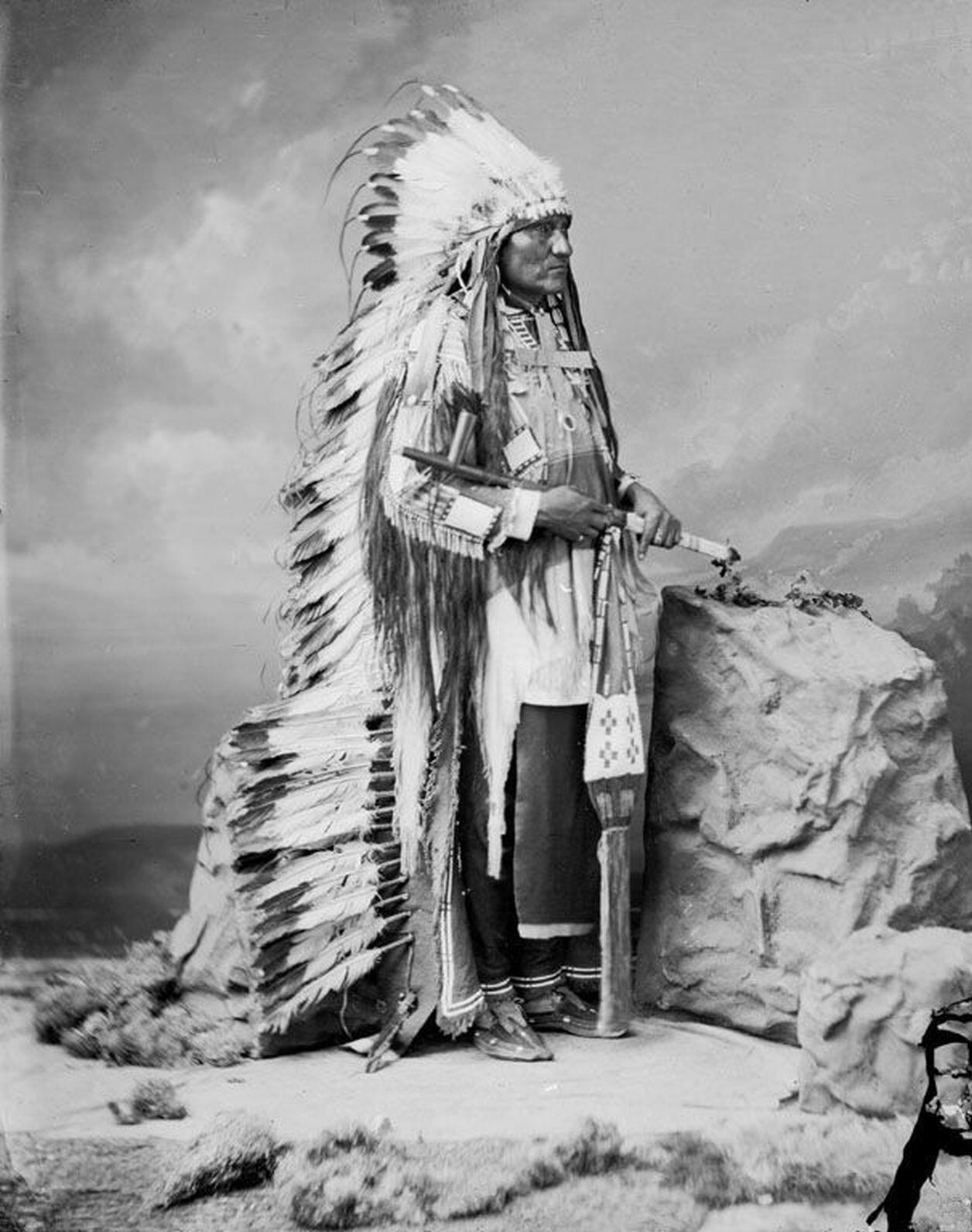
Forms of tribal leadership varied. Tribes might have one or more leaders, often referred to as chiefs. In some tribes, one chief might be in charge of the tribe during peacetime. Another would lead the tribe in war. In some tribes, a person had to belong to a certain family, band, or clan to become a chief.
Although many tribes did not have a single permanent leader, certain groups called chiefdoms did. In both types of tribes, decisions were typically made by general agreement after a meeting of the tribal council. This council consisted of members of the tribe who were respected for their wisdom or abilities.
Federations.
Some tribes in North America joined together to form groups called federations. The most famous federation was the Iroquois League, originally made up of the five Iroquois tribes—the Mohawk, Onondaga, Oneida, Seneca, and Cayuga. Historians believe that the Iroquois leader Hiawatha helped found the federation to stop the fighting among these neighboring tribes. Other federations, such as the Cherokee and Muscogee (Creek), were formed to fight common enemies or to solve various problems.
Empires and states
existed only in Middle and South America. An emperor ruled the huge Aztec state in Mexico, and the people were divided into social classes. In the Inca empire, which stretched along the Andes Mountains in South America, a god-king ruled from 3 1/2 million to 7 million people. Among the Maya of Middle America, large cities ruled over the surrounding areas. Many of these cities were home to tens of thousands of people.
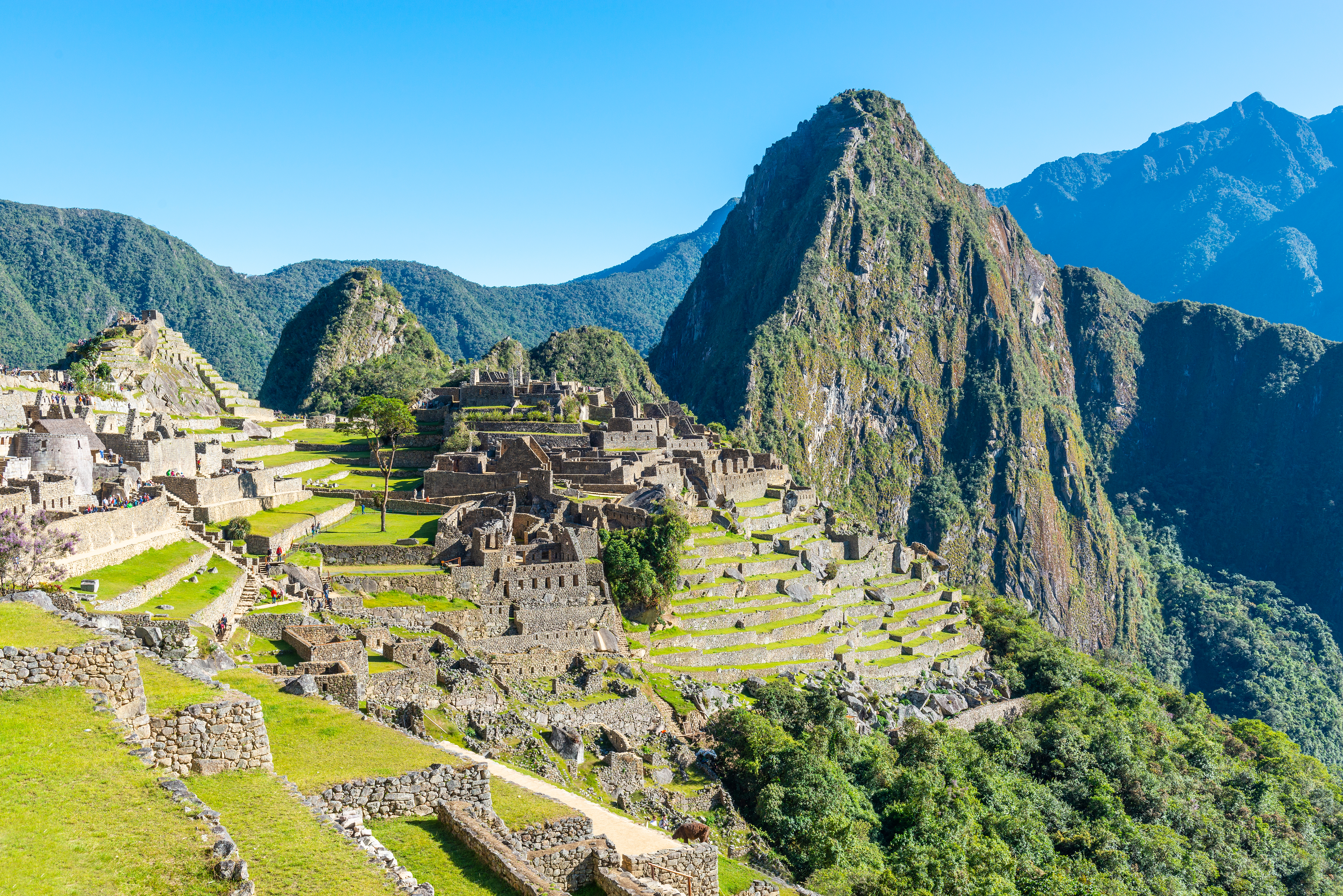
A formal state may have started to develop among the Natchez people and their neighbors in the Southeastern United States. The arrival of the Europeans halted its development. The Natchez had a powerful king.
Warfare
Wars occurred from time to time among the tribes of the Americas. But not all tribes took part in warfare. Many tribes opposed fighting, and others were so small that they did not have enough warriors to fight a war. Many of the leaders who tried to defend their tribes and land against the advance of white people became famous warriors. They included King Philip, a Wampanoag; Pontiac, an Ottawa; Tecumseh, a Shawnee; Osceola, a Seminole; Crazy Horse, of the Oglala band of the Lakota, or Teton Sioux; and Geronimo, an Apache.
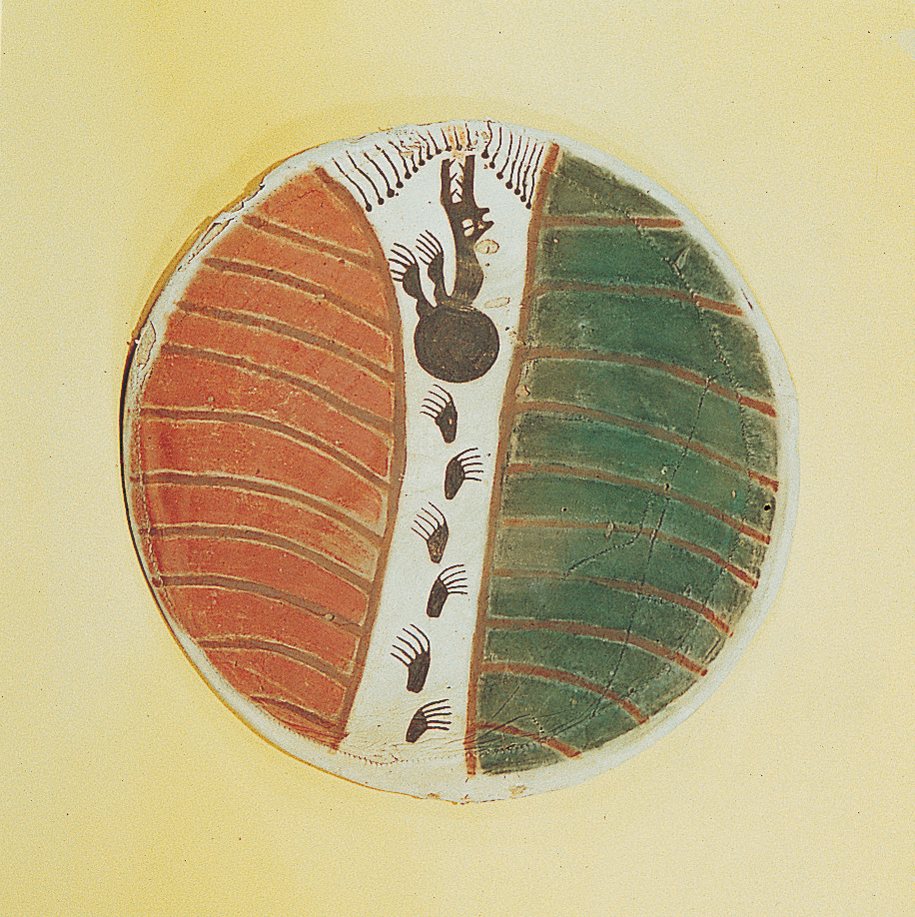
Weapons.
The bow and arrow was probably the most common weapon throughout North and South America. Some South American tribes put poison on their arrowheads. Many Indigenous warriors fought with spears and war clubs. The peoples of eastern North America developed a special type of club known as the tomahawk. A weapon of the Aztec consisted of pieces of obsidian (volcanic glass) stuck into a wooden club. South American fighters used blowguns and slings.
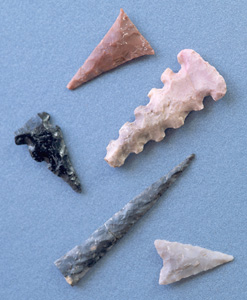
Why conflicts occurred.
Warfare was sometimes the only way of settling disputes between tribes. A council, made up of the chiefs of tribes that had joined together, settled many arguments between tribes. But warfare might result if the council could not settle a dispute.
Warfare gave warriors a chance to achieve high rank in their tribes. On the Plains, it was considered braver to touch a live enemy and get away than to kill the enemy. This act was known as counting coup << koo >>. Warriors on the Plains carried a coup stick into battle and attempted to touch an enemy with it. Those warriors who counted coup wore eagle feathers as signs of their courage.
The scalp of an enemy was a war trophy in parts of North America. Some Europeans encouraged scalp hunting in North America by paying Indigenous people who were friendly to the newcomers for the scalps of enemies. The Indigenous peoples of the Caribbean and Tropical Forest regions fought for war honors and trophies that included skulls and shrunken heads as well as scalps.
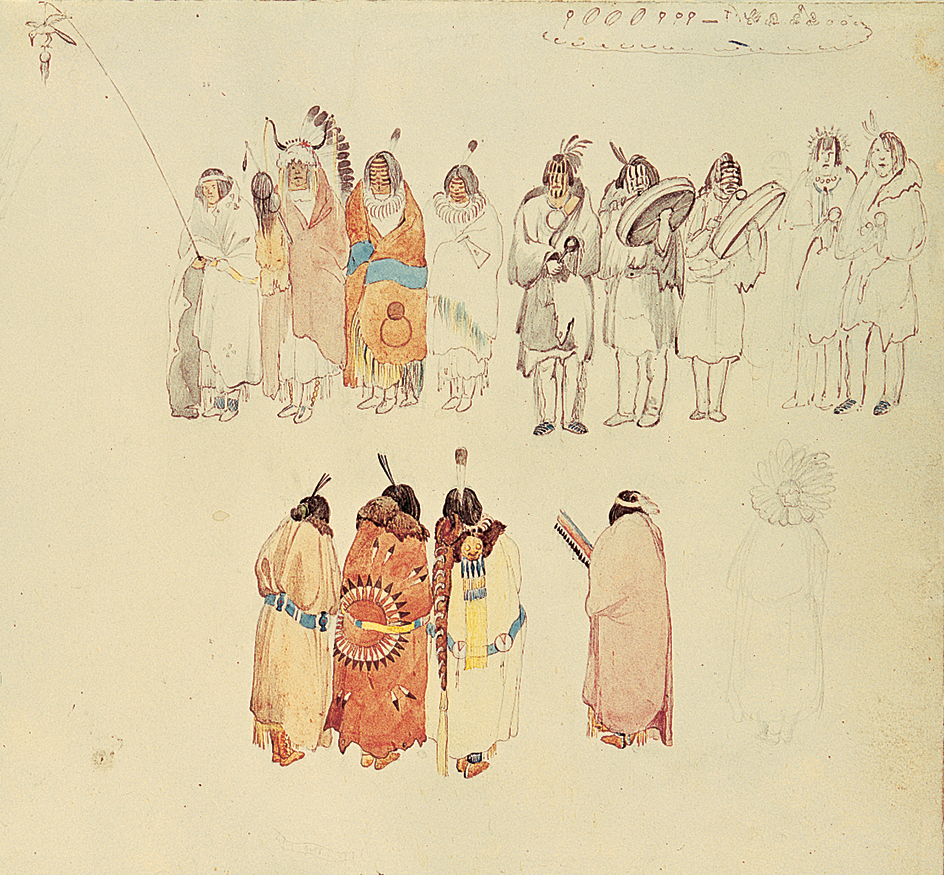
The Aztec fought not only to enlarge their territory but also to take captives for sacrifice to the gods. Human sacrifice was a major part of the Aztec religion. Only the Aztec and the Inca had full-time armies. In other tribes, warriors went back to hunting or farming after their battles. Some tribes, particularly the Northwest tribes and the Iroquois, enslaved their captives. The Witoto and Tupinamba tribes of the Tropical Forest sometimes killed war captives and then ate them. But the victims were not eaten as a source of food. The tribes believed the dead person’s strength and bravery would be passed on to the person who ate the flesh.
Warfare increased greatly in all areas after the Europeans came. It became the main way of settling disputes between Indigenous groups and white newcomers. The Europeans adopted Indigenous styles of warfare—ambush, surprise attack, and quick withdrawal. Indigenous groups began to use the Europeans’ guns and other weapons.
Arts and crafts
The Indigenous peoples of the Americas worked in many arts and crafts. For the most part, people tried to make everyday objects attractive as well as useful. Indigenous people also produced various forms of oral and written literature.

Pottery.
Indigenous people created a great variety of beautiful pottery. They made most of their pottery by the coil method, in which pieces of clay are rolled into slender strips and laid on top of one another in spiral fashion. Potters sometimes kept the coils on the pottery as decoration but often scraped the surface smooth.
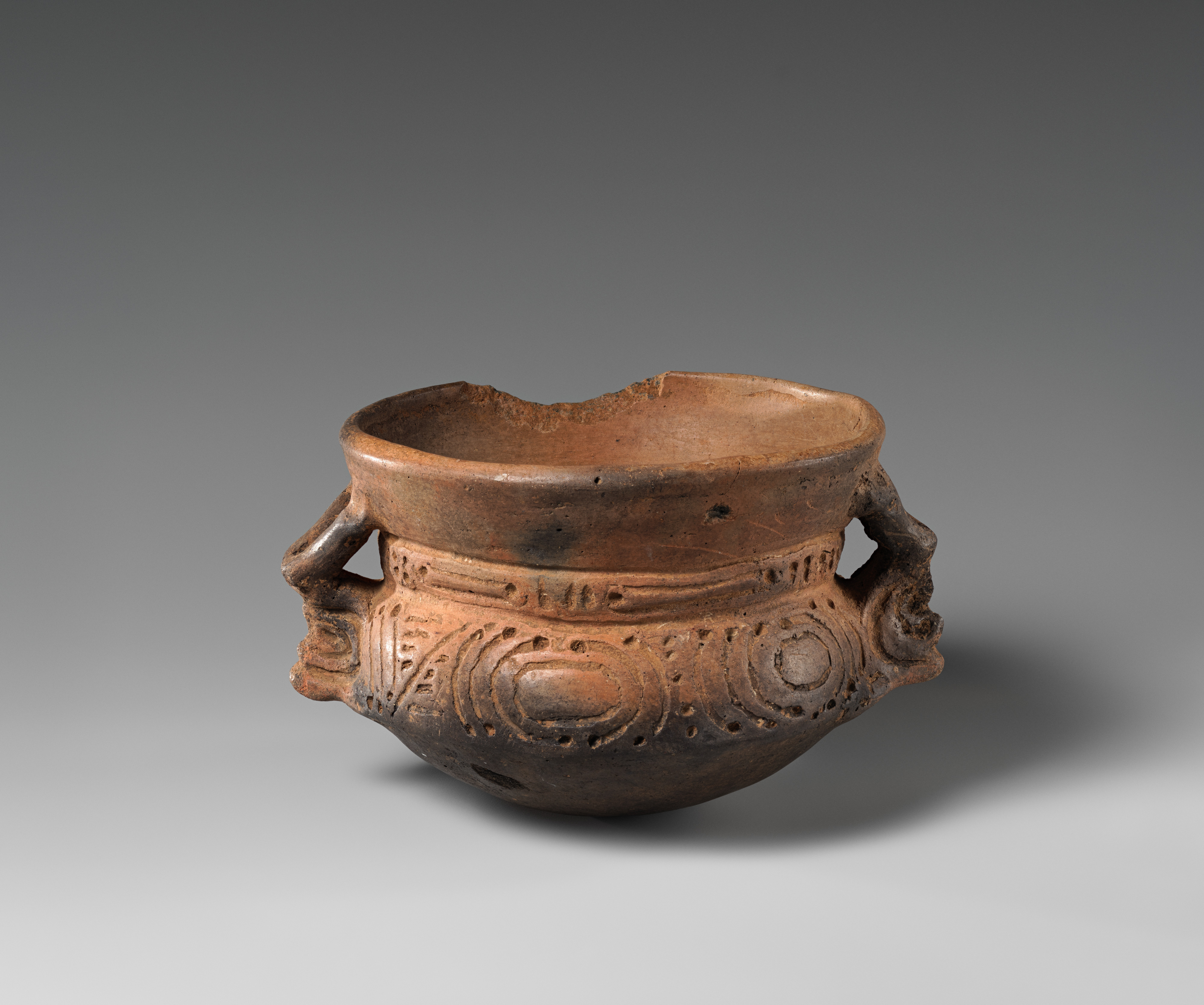
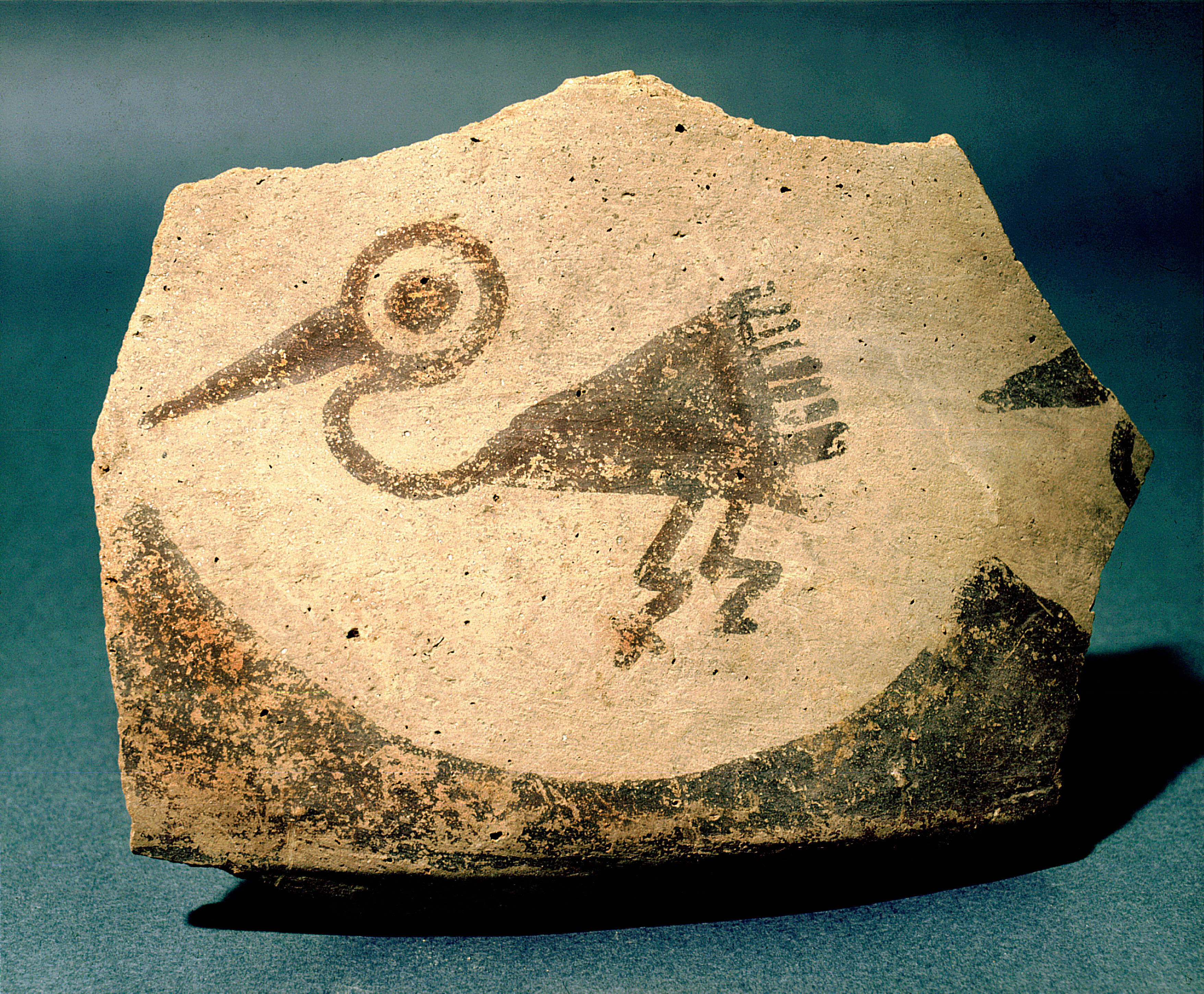
Inca potters made some of the finest pottery in the New World. The Aztec and Maya painted some of their pottery with scenes of religious ceremonies. In North America, the early peoples of the Mississippi Valley made fine bowls and jars, many in the shape of animals.
Basketry.
Almost all Indigenous groups made baskets that they used to store and carry food. Indigenous people also wove fibers into mats and wall coverings, articles of clothing such as hats and sandals, and fish traps. The Pomo people, who lived in California, were probably the finest basket makers in the New World. The Pomo sometimes decorated their baskets with shells, feathers, and beadwork. Pomo baskets were woven so tightly that they could hold water. 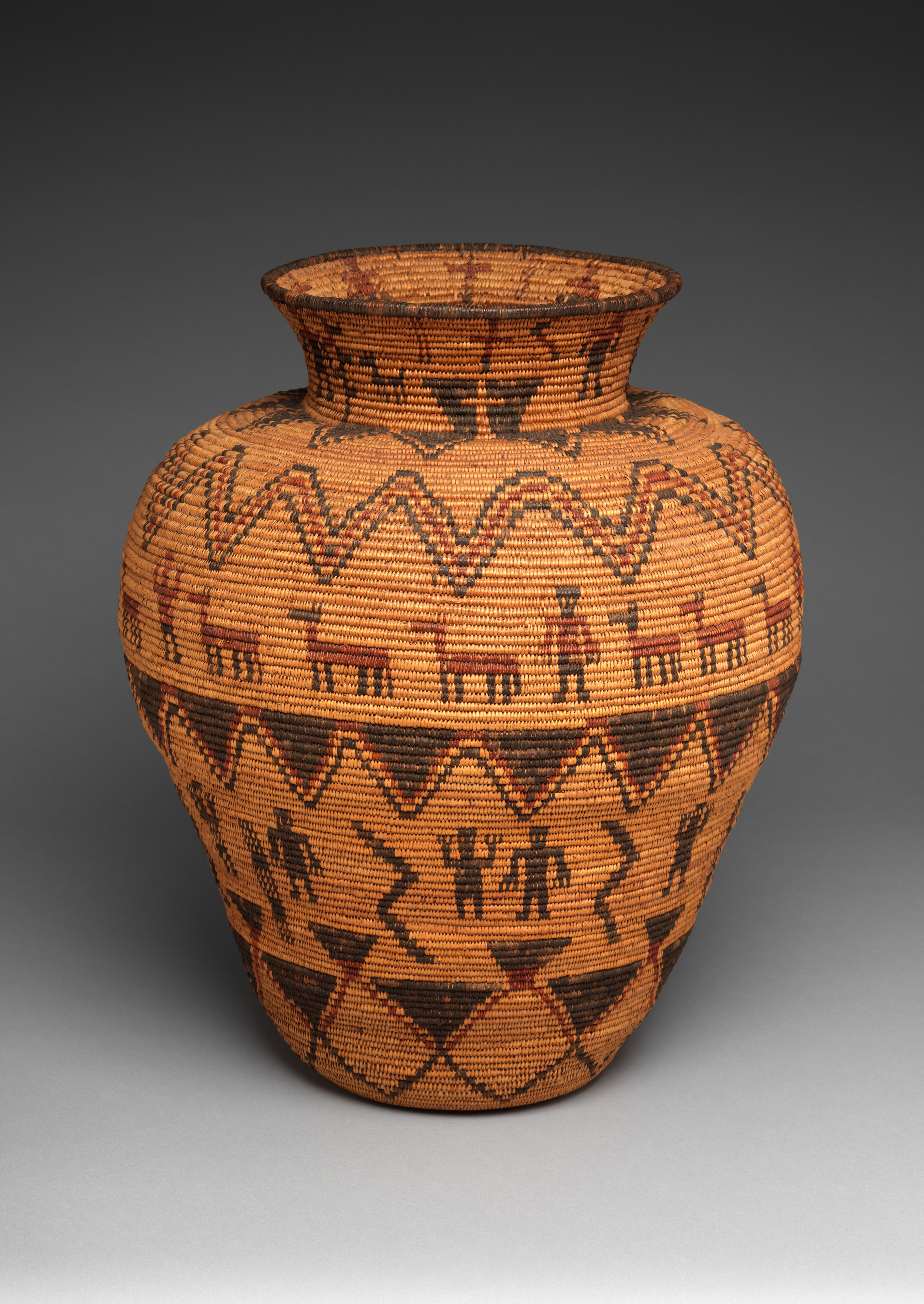
Carving.
The Indigenous peoples of Middle America created elaborate carvings. Large sculptures were used to decorate ancient Aztec and Maya structures or were placed alongside the structures as monuments. The peoples of Middle America also carved jade, onyx, quartz, and other materials. Peoples of the Northwest Coast made fine woodcarvings. Their ceremonial wooden masks had movable parts. They also carved house posts, grave markers, and totem poles.
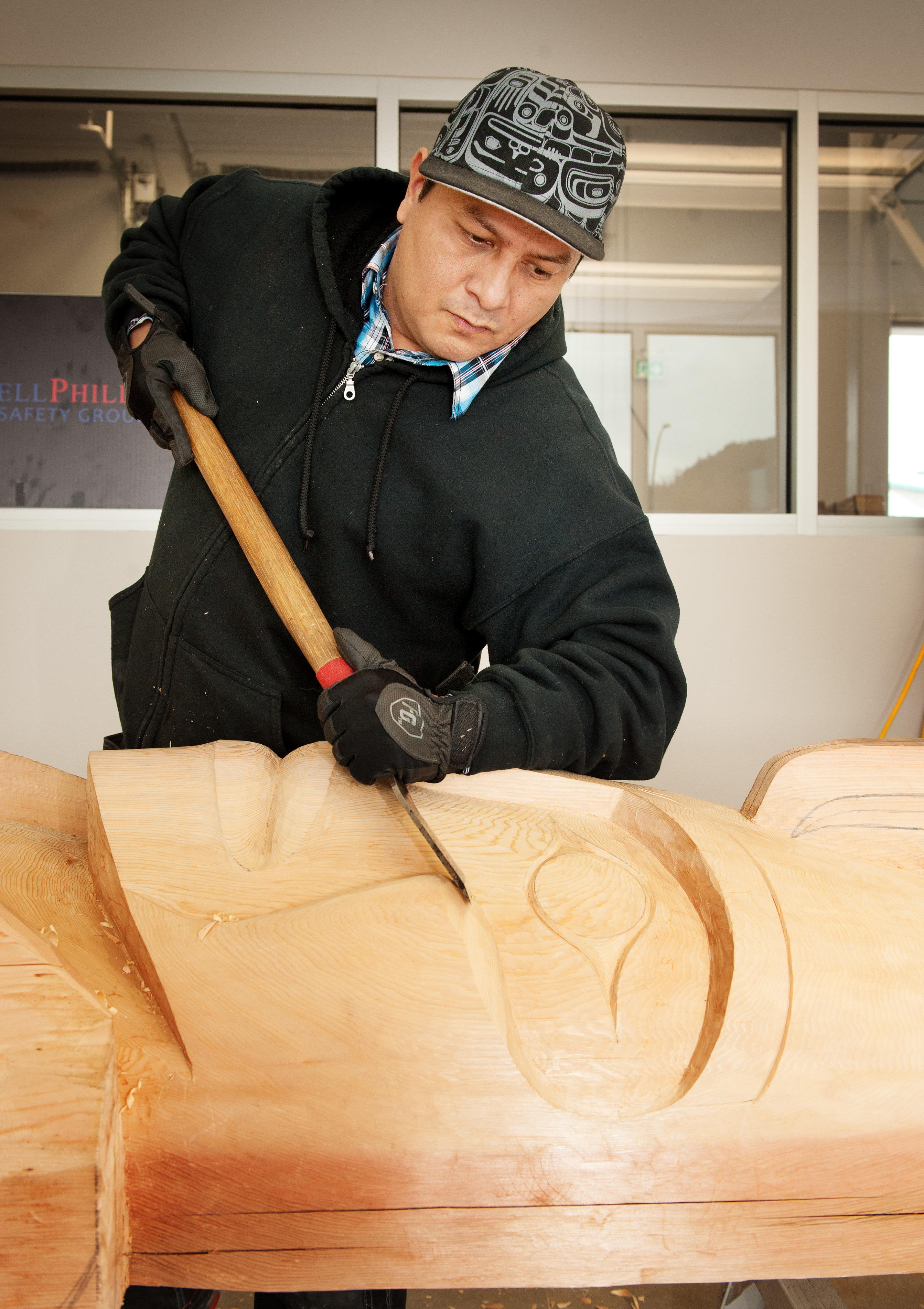
Metalwork.
The Andean people knew how to make bronze and how to cast, solder, and gild metals. The Caribbean peoples produced fine pieces of gold work. No such elaborate metalworking took place north of what is now Mexico. But Indigenous people in the Lake Superior region and the Northwest Coast hammered copper to form tools and weapons. They also cut hammered copper into decorative or ritual objects.
Weaving
was most common south of the Rio Grande. But the Pueblo of the Southwest wove cotton cloth before the arrival of the Europeans. The Navajo, or Diné, people took up wool weaving later and became famous for their blankets and rugs. Peoples of the Northwest Coast made beautiful blankets of cedar fibers and mountain-goat hair. Inhabitants of the Southeast wove plant fibers so well that the early European settlers thought the material was actually cotton cloth.
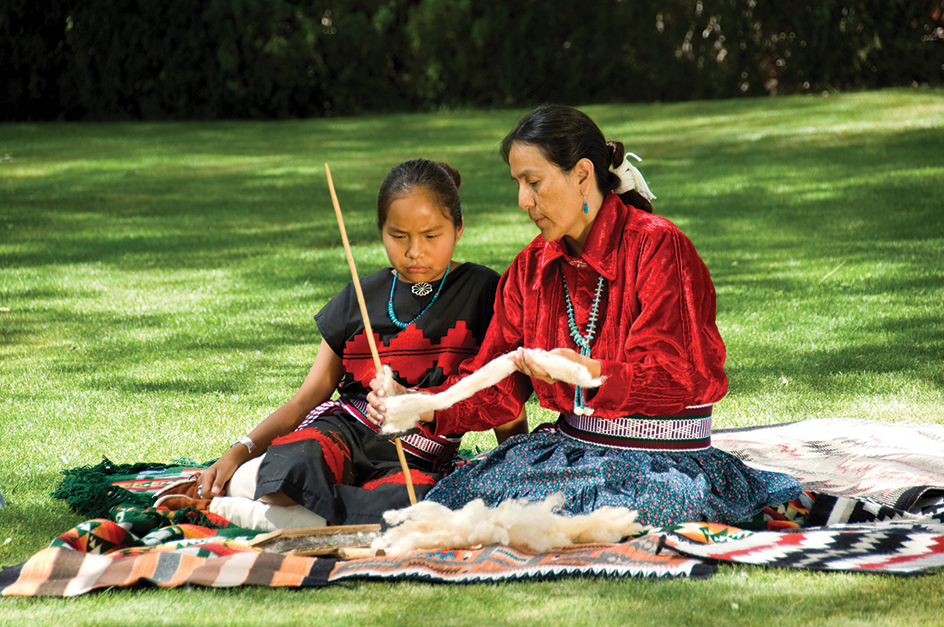
Weaving was also an important art among the Inca. Their weaving of cotton and of alpaca, llama, and vicuna wool was so fine that it has not been improved upon—even with power looms.
Painting.
Indigenous craftworkers usually combined painting with other arts. For example, much pottery of the Indigenous peoples of the Southwest and of the Aztec, Maya, and Inca had painted designs. The Aztec and Maya also made large wallpaintings of important ceremonies and historic events. Painted designs also decorated some woodcarvings of the Northwest Coast tribes. The Pueblo were the first to make sand paintings, and the Navajo improved on this ceremonial art.
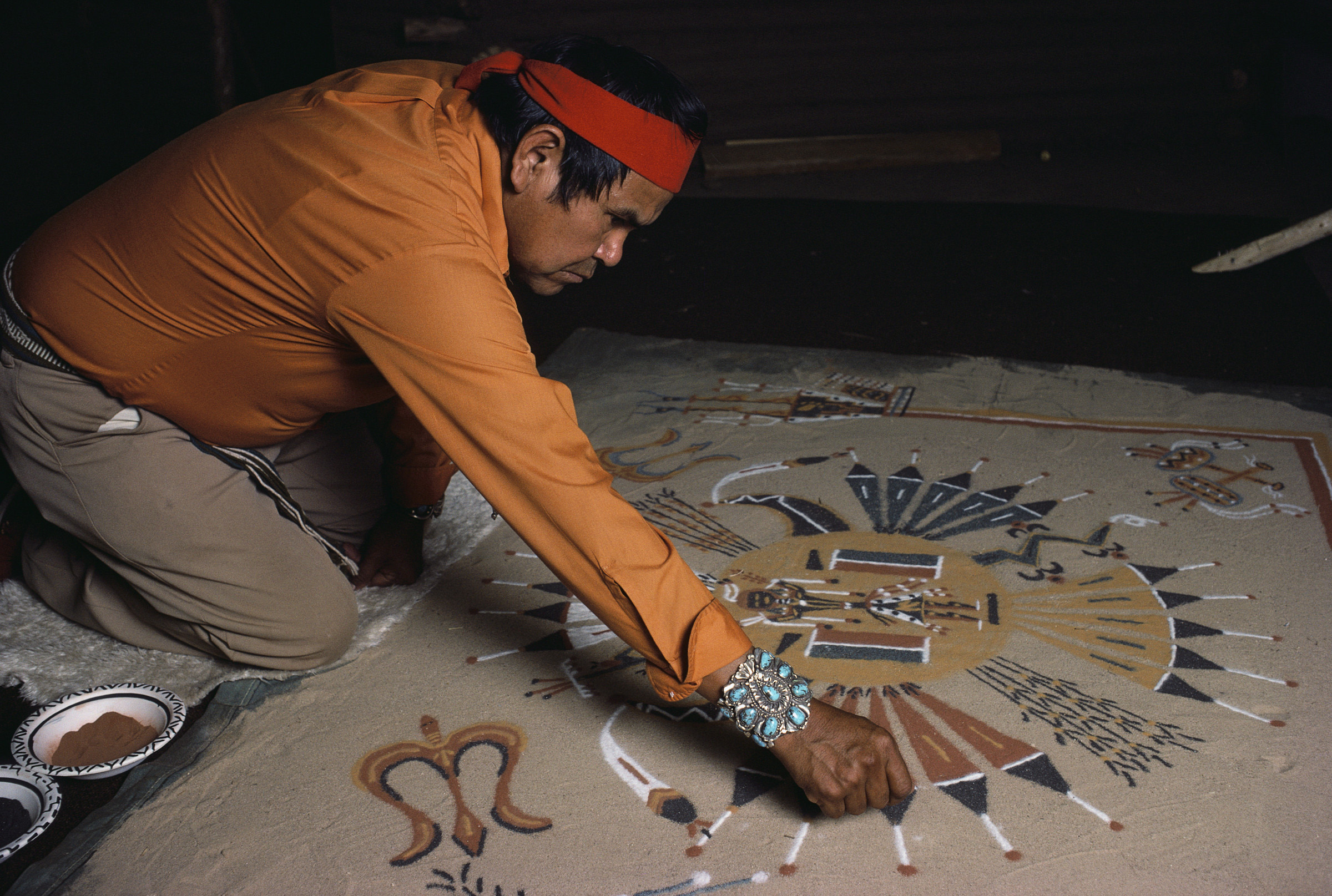
Literature.
Most Indigenous groups handed down their folk tales and poetry by word of mouth for centuries. Some North American groups, such as the Ojibwe, recorded some of their tribal songs on bark. The Maya left behind manuscripts that tell of their ancient history. The Inca wrote dramas dealing with great military victories as well as with everyday life.
Religion
The Indigenous peoples of the Americas had no one religion any more than they had one way of life or one language. But certain religious beliefs were widespread. Most important was the belief in a mysterious force in nature. Indigenous people considered this unseen spirit power superior to human beings and capable of influencing their lives. People depended on it for success in the search for food and in healing the sick, as well as for victory in war.
Beliefs.
Most Indigenous people believed that the spirit power could be gained by certain people or through certain ceremonies. The power might be centered in some animals, areas, or things, making them powerful or dangerous. Some tribes had a name for the spirit power. The Iroquois called it orenda, and the Lakota referred to it as wakan tanka.
Some tribes believed in a Creator Spirit—an especially powerful god. But the great god belief was always accompanied by a belief in many other spirits or in the general spirit power.
The peoples of Middle America and the Andes had whole families of gods. The Aztec, for example, worshiped hundreds of gods. The Inca believed that their ruler was also a god—a god-king—and they worshiped him along with their other gods.
Indigenous people in some areas greatly feared the ghosts of the dead. But few people gave much thought to life after death or the idea of a heaven.

The guardian spirit.
One way of reaching the powerful spirit world was through a personal spiritual helper called a guardian spirit. Most Indigenous people believed that the spirit helped guide a person through the hardships of life. An individual might have one special guardian spirit, or different ones for different needs. Belief in a guardian spirit was common throughout most of the New World.
When boys—and, in some tribes, girls—reached their early teens, they went through an initiation ceremony to help them find a guardian spirit. Many went without food, sleep, or companionship until they saw a vision of their guardian spirit. Some wounded themselves to help bring a vision. This search for a vision of a guardian spirit is known as a vision quest.
Medicine people.
The spirit world could also be reached with the aid of a religious helper called a medicine maker or shaman. These helpers were believed to have close contact with the spirit world. They were sometimes called medicine men or medicine women because their tasks included treating the sick.
Some people believed that certain diseases were caused by an object in the body. Medicine people began their cure for such conditions with special songs and movements. They usually blew tobacco smoke over the sick person because tobacco was believed to have magical powers. Medicine people sucked on the body of the sick person until they “found” the object causing the illness. Then they spit out the object—usually a small stick or a stone that they had hidden in the mouth.
Medicine people had some knowledge of medicine. They set broken bones and used various herb remedies. Many plants they used are still given by doctors today. Curare arrow poison is used in treating hydrophobia and tetanus. Indigenous people also used quinine, which physicians prescribe to treat malaria. The Inca developed trephining, the removal of part of the skull. This surgery was often used to relieve pressure on the brain.
Occasionally, medicine people joined together to form a religious organization called a curing society. Such organizations included the Midewiwin Society of the Ojibwe and the False Face Society of the Iroquois.
Priests
performed public ceremonies for an entire group, but a medicine person usually helped only a single person or family. Unlike medicine people, priests went through long periods of formal training. They also used more equipment than the medicine people and had places of worship for performing ceremonies. Indigenous groups with priests included those of the Northeast, the Southeast, the Southwest, and Middle and South America.
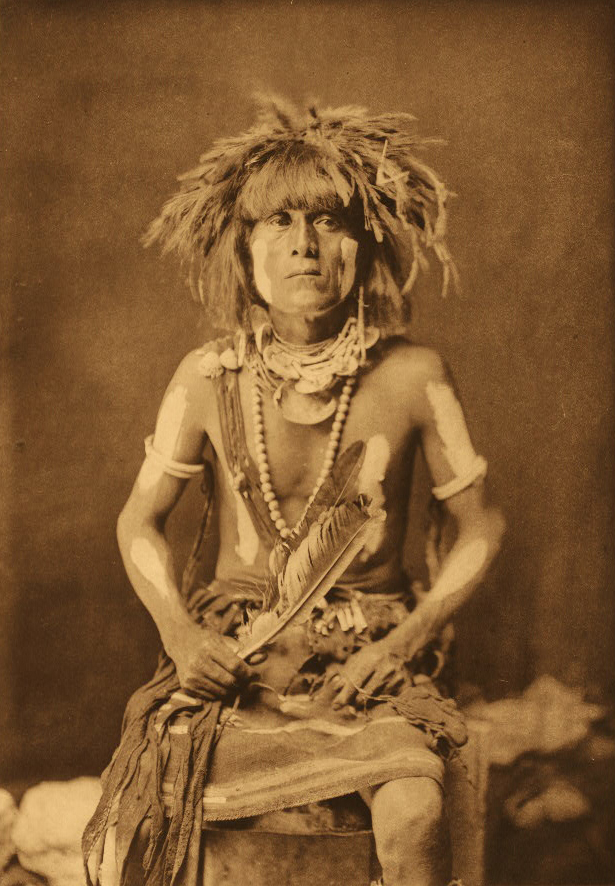
Prophets.
A new type of religious leader appeared among Indigenous people after the Europeans arrived. Most of the new leaders urged their followers to give up European goods—especially liquor—and return to the old ways. Because these leaders predicted future events, the Europeans called them prophets.
Sometimes the prophets preached war to the death against white settlers. But often they called on their people to live separate, peaceful lives. Famous prophets included Hiawatha, the leader who helped form the Iroquois League in an effort to end wars between tribes; Popé, a leader of the Pueblo revolt of 1680; and the Shawnee Prophet, a brother of Tecumseh. Handsome Lake, an Iroquois prophet, founded the Longhouse religion, which combined elements of Christianity and traditional Iroquois religion. Wovoka, a Paiute, founded the Ghost Dance religion of 1890, which taught that the Creator Spirit would restore the Indigenous American world to the way it was before Europeans arrived.
Ceremonies.
Indigenous Americans held a number of kinds of ceremonies. Many of these rituals were designed to ensure that the people had enough food. Hunting tribes performed ceremonies to keep game plentiful. The Plains peoples, for example, believed that the buffalo dance would ensure success in hunting buffalo. Farming tribes held planting ceremonies, rain dances, and harvest festivals. The green corn dance of the people of the Southeast region celebrated the summer’s first corn crop. At the end of the Hopi snake dance, snakes were released to ask the rain god to send rain.
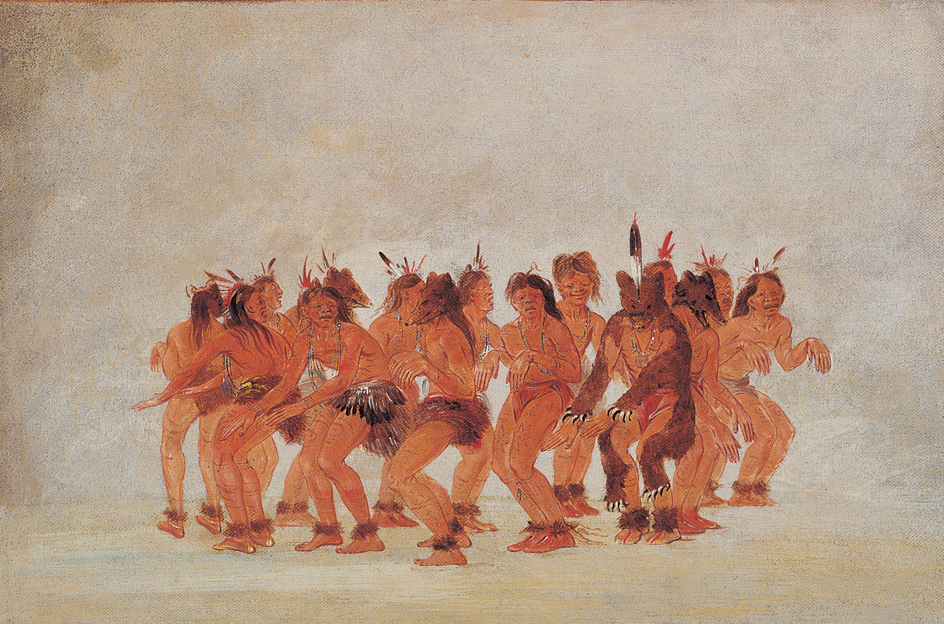
The Pueblo people had religious societies that performed dances the year around to ensure good crops. One such group was the Kachina Society of masked dancers. These dancers also visited the homes of children to ask if the youngsters had been good. If they had not, the Kachina dancers might punish them.
The sun dance was the chief ceremony of the Plains peoples. Dancers performed it to gain supernatural power or to fulfill a vow made to a divine spirit in return for special aid. Some men tortured themselves as part of this ceremony. A sun dance lasted several days.
Nearly all Indigenous groups of North and Middle America had some kind of a sweat lodge ceremony. This ceremony took place in a structure called a sweat lodge. Some sweat lodges were heated directly by a fire. But in many lodges, water was poured over heated stones to produce steam. The hot steam caused occupants of the sweat lodge to perspire. Sweat lodge ceremonies were designed to purify the body, cure illnesses, and influence spirits. 
The most elaborate ceremonies were those of the Aztec and Maya in Middle America and the Inca in the Andes Mountains. Priests directed these great public celebrations. Some lasted for several days. Major Aztec ceremonies included human sacrifices to the gods.
Music
accompanied most Indigenous ceremonies. Many tribes sang to the rhythm of rattles, clappers, and drums. Some tribes also used flutes and whistles. Panpipes, a series of hollow reeds tied together, were common in the Caribbean region and in South America. 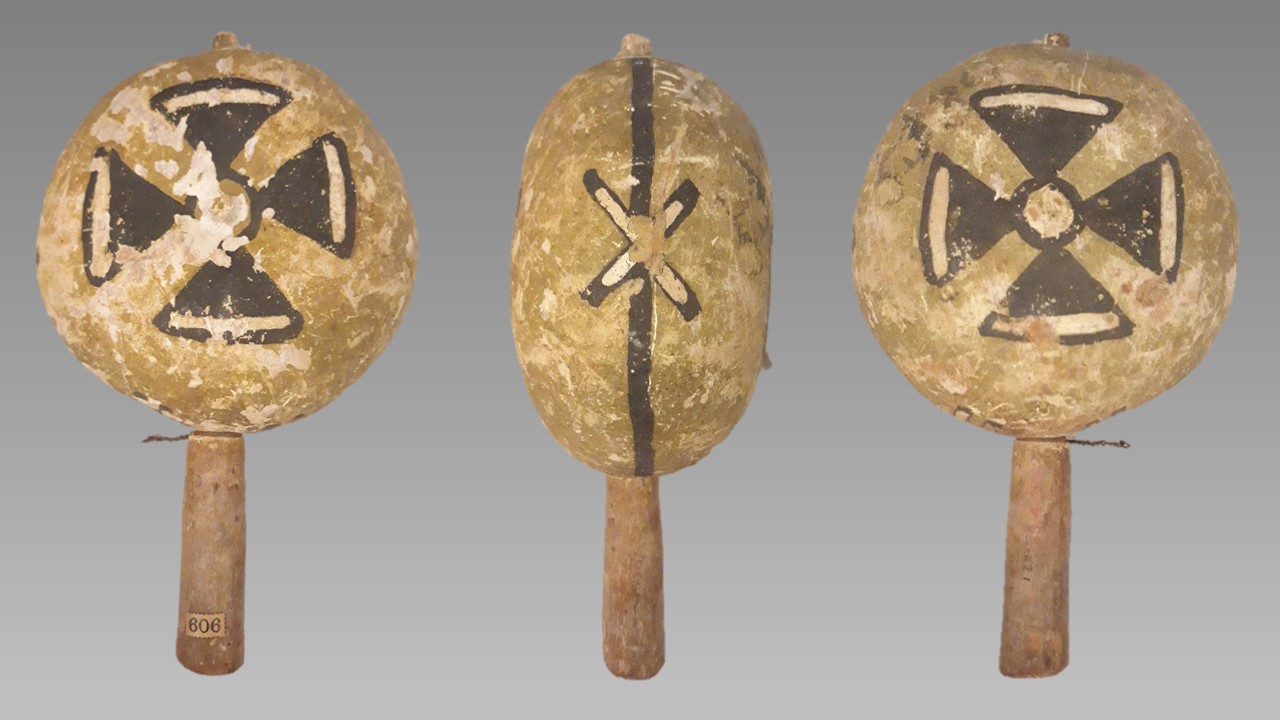
Legends
of gods, spirits, and ancestors were handed down from parent to child. Legends formed the basis of various ceremonies. Legends included stories of the world before it had people, stories of the origin of people and tribes, and tales of tribal heroes.
Trade
Trading was an important activity among nearly all Indigenous groups. The groups learned much from one another as they exchanged goods and shared ideas and experiences. Throughout the Americas, goods were traded along routes that existed thousands of years before the Europeans arrived.
In North America, obsidian was carried from the Rocky and Cascade mountains, flint from Ohio and southern Canada, copper from Lake Superior, mica from North Carolina, and shells from the Gulf of Mexico and the Atlantic and Pacific coasts. In both North and South America, Indigenous people traded tobacco wherever it could not be grown. Salt was widely traded in agricultural areas. In Middle and South America, precious metals and gems were important items of trade.
Money.
Indigenous groups had no formal system of money. For the most part, they traded goods and services for other goods or services. In some areas, people used certain objects much as money is used today. Among the peoples of California and the Northwest Coast, sea shells called dentalia or tooth shells were divided into five sizes. The longer the shell, the greater was its value. Indigenous people of Middle America used cacao beans, from which chocolate is made, as money.
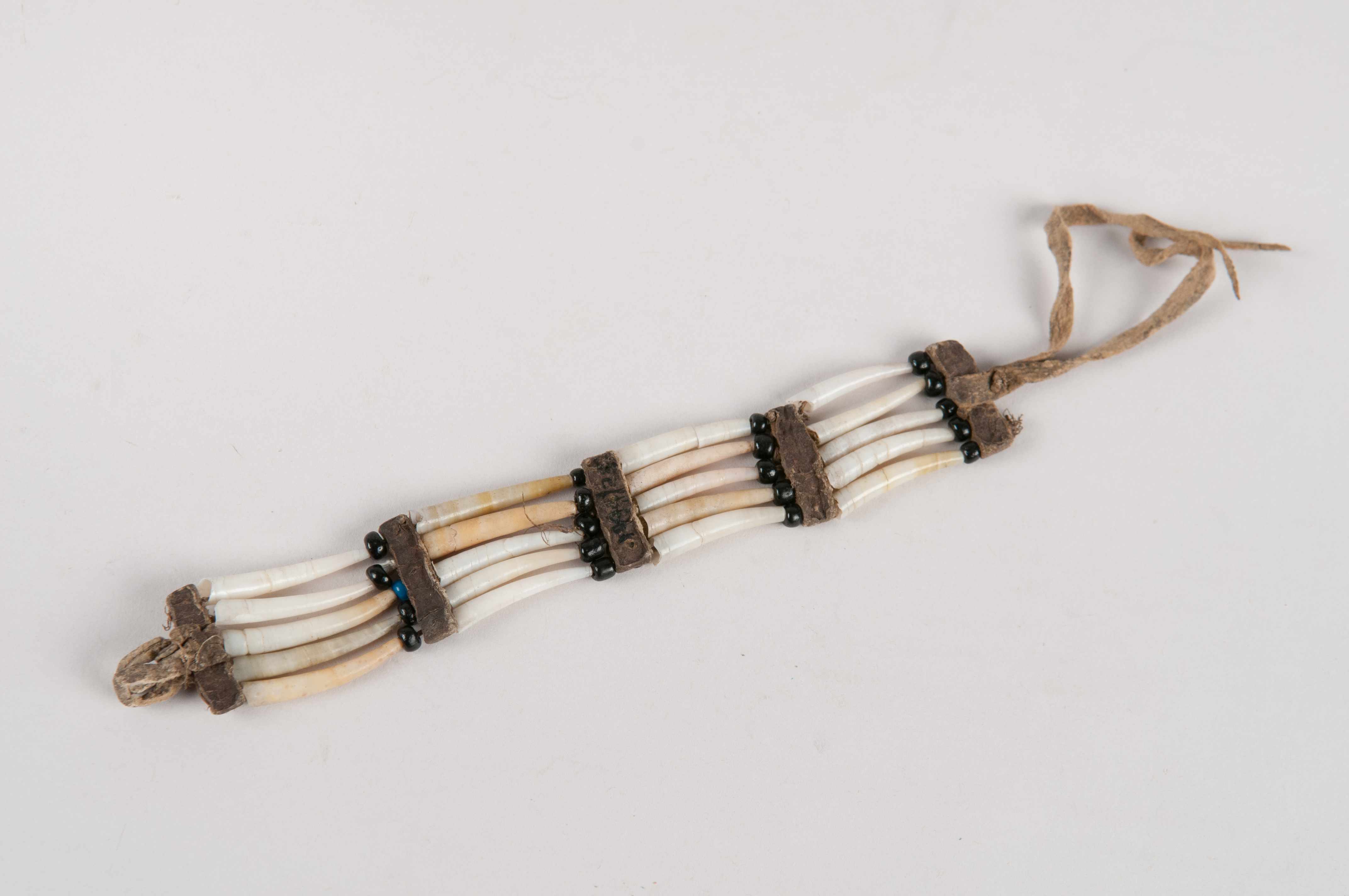
In eastern North America, Indigenous people sometimes used wampum. Wampum, a combination of purple and white beads made from shells, was strung into necklaces or belts. It served mainly as a means of keeping records or recording treaties. But because it had value, it was also used as money.
Trading centers
for various products existed only in parts of Middle and South America. These public markets had full-time traders and merchants. Among the Aztec, traders also served as spies for the government. Many lived among conquered tribes and watched for signs of revolt or nonpayment of tribute (required goods) to the Aztec.
Trade between Indigenous groups and European settlers was important in North America. The settlers needed many of the things the Indigenous people had, and Indigenous people wanted guns, horses, liquor, and metal tools. Both groups used beaver pelts and buffalo hides as items of trade in the northern areas and on the Plains.
Language
Many scholars believe the Indigenous peoples of North and South America spoke more than 2,000 languages at the time the Europeans arrived. At least 300 separate languages were spoken north of Mexico. Some had many similar words and grammar, but others differed greatly. Many Indigenous languages are lost because all the people who spoke them died before their languages could be recorded.
Language groups.
The languages of Indigenous Americans, like other languages, can be classified into large groups. In general, languages are grouped into families, which in turn are grouped into larger language phyla. One classification of Indigenous languages has 11 main phyla. These phyla are (1) American Arctic-Paleosiberian, which includes the languages of the Eskimo-Aleut family; (2) Andean Equatorial; (3) Aztec-Tanoan, which includes the Uto-Aztecan family; (4) Gê-Pano-Carib; (5) Hokan; (6) Macro-Algonquian, which includes the languages of the Algonquian and Muskogean families; (7) Macro-Chibchan; (8) Macro-Otomanguean; (9) Macro-Siouan, which includes the Iroquoian and Sioux families; (10) Na-Dene, which includes the Athabascan family of languages; and (11) Penutian.
Sometimes one language became the trade language for many tribes. For example, a waterfall at The Dalles on the Columbia River was an important trading site. The Chinook people of the area spoke for the various tribes who came there to trade. As a result, the Chinook language became a trade language. After European contact, mixtures of European and Indigenous languages began to be used for trading.
Writing.
The most highly developed Indigenous American writing systems included those of the Maya, the Aztec, and some of their neighbors in Middle America. Maya writing consisted of symbols called glyphs, which were carved in stone. The Maya also wrote on bark paper and deer hide. Scholars have translated most of the known glyphs. The Maya had a number system based on 20, and a symbol for zero. They used their numbers to create a calendar that may have been more accurate than those of the ancient Egyptians, Greeks, or Romans.

Aztec writing consisted of pictograms, most of which were pictures of objects. The Aztec used pictograms mainly to keep records. The Spaniards learned to read Aztec writing, which was still in use when they arrived. But Maya writing had not been used for several hundred years before the Europeans came.
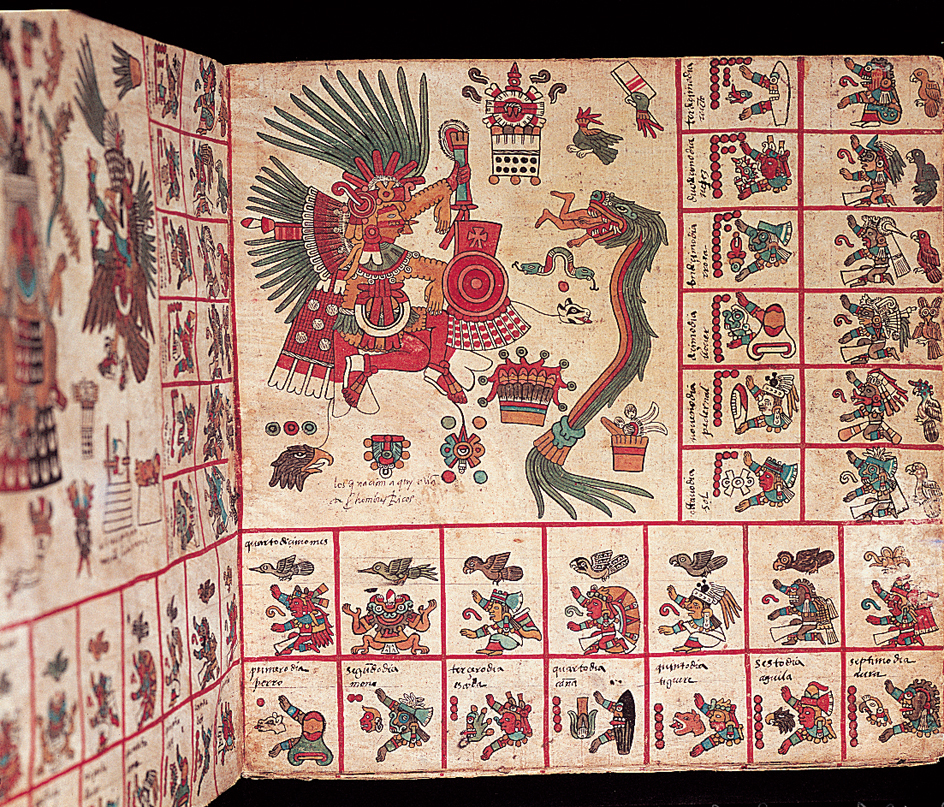
The Inca kept records by tying knots on a string called a quipu. The quipu used the decimal system. The knots at the end each stood for 1, those farther up each counted for 10, and those still higher up stood for 100. The Inca recorded crop records and population information by this method.
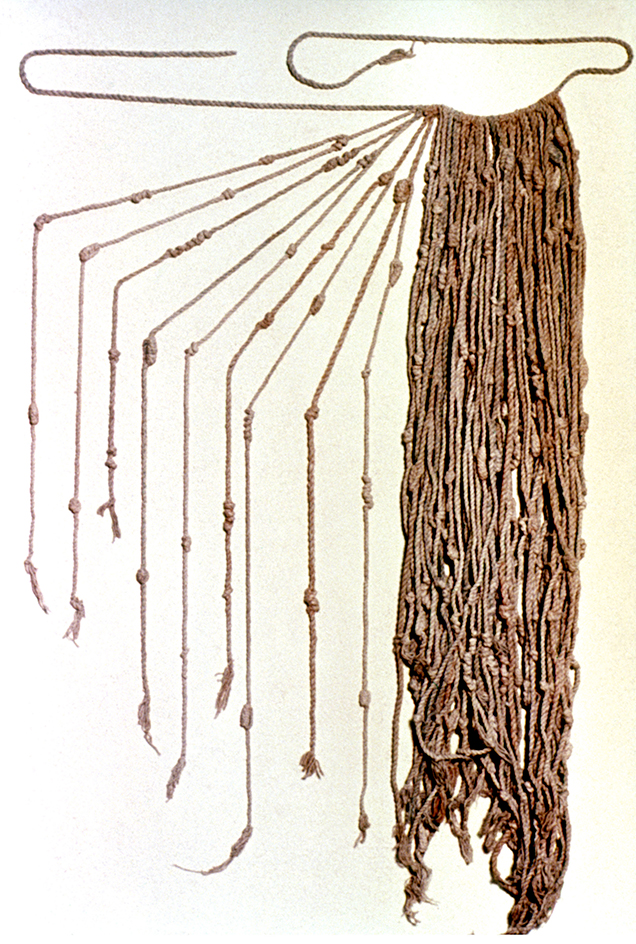
Some tribes used pictures or wampum to keep records. Pictures drawn on animal skins or bark showed events in a person’s life or a tribe’s history. The drawings—known to the peoples of the Plains as winter counts—also recorded the passage of time and of the seasons. Belts of wampum kept account of treaties.
In North America, a Cherokee named Sequoyah invented a writing system called a syllabary. This system, completed in 1821, consisted of symbols that stood for sounds in the Cherokee language. With 86 signs, he could write any Cherokee word.
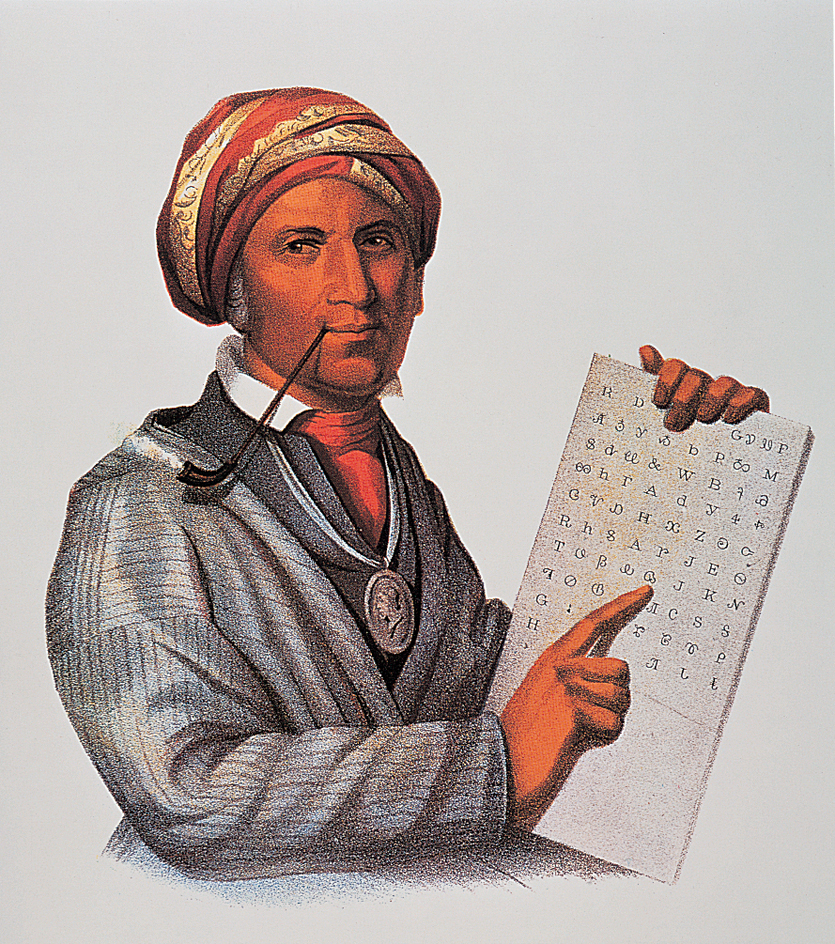
Other communication.
The peoples of the North American Plains spoke many languages and needed some means of communicating with one another. From this need came a series of commonly understood gestures called sign language. After the Plains people obtained horses, many more tribes came together in the region. This situation led to the further development of sign language. Sign language was not a complete language, and it could not express any complicated idea. Nor was it understood by peoples outside the Plains region.
The Plains people also used smoke signals and drum signals. However, these forms of communication could send only limited information—a warning, for example.
The first Americans
The story of the first peoples of the Americas began thousands of years ago. Scholars know little about these first Americans. Scientists have had to dig their story out of the earth itself. Pottery, stone tools, bones of human beings and animals, charcoal of campfires—all these have offered clues about how and when these early Americans lived. But many questions remain unanswered.
Scientists believe that the first peoples of the Americas are descended from the peoples of eastern Asia. In some ways, descendants of the first Americans resemble the Chinese, Japanese, and other peoples of eastern Asia in appearance. For example, they have straight black hair and high cheekbones, and little hair on their bodies. But Indigenous Americans also differ from their Asian relatives in some ways.
Early days.
For a long time, no people lived in the Americas, though many animals roamed the land. They included huge mammoths and mastodons, herds of bison and elk, and saber-toothed cats.
During the Pleistocene Epoch—between about 2.6 million and 11,500 years ago—great sheets of ice covered much of the Northern Hemisphere. These ice sheets were up to about 10,000 feet (3,000 meters) deep. The level of the oceans became lower because so much of the earth’s water made up the ice sheets. Much land that had been underwater—and is underwater again today—became dry. One such area lay between Siberia and Alaska, where the Bering Strait now separates Asia and North America by about 50 miles (80 kilometers).
Plants started to grow on the new land, and animals began to cross it in both directions, grazing on the vegetation. Some people of Siberia followed the animals that they hunted, and they crossed this land into the New World. These people were the ancestors of the Indigenous peoples of the Americas. No one knows exactly when these migrants came to North America, but most experts believe they arrived at least 15,000 years ago. By about 11,500 years ago, the ice sheets had melted and the land bridge became covered with water. By 6000 B.C., people lived in nearly every part of North and South America.
The first Americans lived in small bands of 20 to 50 people. They followed herds of the animals they hunted and never settled anywhere for long. Their shelters were probably crude and temporary.
The weapons of the early Americans were mainly wooden spears with sharp stone points. Some of the points had a large flake removed from one or both sides. This type of point is called a fluted point. The first fluted point was discovered in the early 1900’s among a pile of animal bones near Folsom, New Mexico. Fluted points of that type are called Folsom points. Early hunters also used a spear-throwing device called an atlatl, which increased the range and force of their spears.
The animals hunted by the early Indigenous American peoples were very large. The hunters often found it easier to kill these beasts by driving them into swamps or over cliffs, rather than spearing them. Most of the knowledge that we have about the hunters comes from these sites where animals were killed.
The changing land.
Slowly, the climate turned warmer and wetter, and the huge ice sheets began to melt. Water from the ice sheets flowed into riverbeds and lakes, and raised the level of the oceans. The land across the Bering Strait became covered with water, and migration to the New World all but stopped.
The large animals hunted by early Indigenous Americans began to die out about this time. No one knows exactly why, but the animals’ food supply of grass may have slowly decreased as the climate changed.
A change in Indigenous ways of life accompanied the changing climate and plant and animal life. In North America, great forests replaced many grasslands in the north and east. Small, swift animals lived in these woodlands. Indigenous hunters may have begun to use the bow and arrow at this time. It made a good weapon for hunting swift woodland animals. Around the lakes and along the rivers, people began to fish and to trap ducks and other water birds. They gathered shellfish for food along the coasts of both North and South America.
Some regions became desertlike. Indigenous people who lived in these areas ate more plant food because the animals were small and scarce. The desert people ground seeds to make flour, gathered berries and bulbs, and ate nuts. Sometimes they added meat to their diet—chiefly rabbits, prairie dogs, and an occasional deer.
The first farmers.
In what is now Mexico, the warm, dry climate produced a way of life similar to that of other desert areas—with one important difference. The people began to cultivate certain grasses that became the ancestors of modern corn. By 1500 B.C., Indigenous Mexican peoples had improved the quality of corn until it grew as large ears. Corn, along with beans and squash, became their main source of food. These people no longer had to travel in search of food, and they began to settle in villages. With farming, the land could support more people. They could build more permanent houses and towns, and have more time for arts and crafts and religious ceremonies. Monte Albán, Teotihuacán << tay oh `tee` wah KAHN >>, and other large cities developed.
Farming spread both north and south from Mexico. In Middle America and the Andean Highlands, the Aztec, Maya, and Inca achieved the most complicated societies in the New World. As the peoples of North America learned farming, their villages grew larger. Farming along the Ohio and Mississippi rivers became so productive that villages developed into towns and cities. Between about 100 B.C. and A.D. 500, in Ohio, the Hopewell people built huge burial mounds and ceremonial centers. Along the Mississippi and other major rivers, from about 700 to 1700, some cities grew to great size.
Estimates of the Indigenous population of the New World when Columbus arrived vary. Many scholars estimate that there may have been between 30 million and 75 million Indigenous people living in all of North and South America, with about 2 million to 7 million of these people living in North America north of Mexico. But some estimates run as high as 118 million for the Americas, with about 18 million living north of Mexico.
Peoples of the Arctic
In North America, the Arctic includes most of the seacoast of Greenland, northern Canada, and Alaska. The land consists mainly of tundra. In the winter, ice and snow cover the ground, and most of the Arctic Ocean is covered with ice.
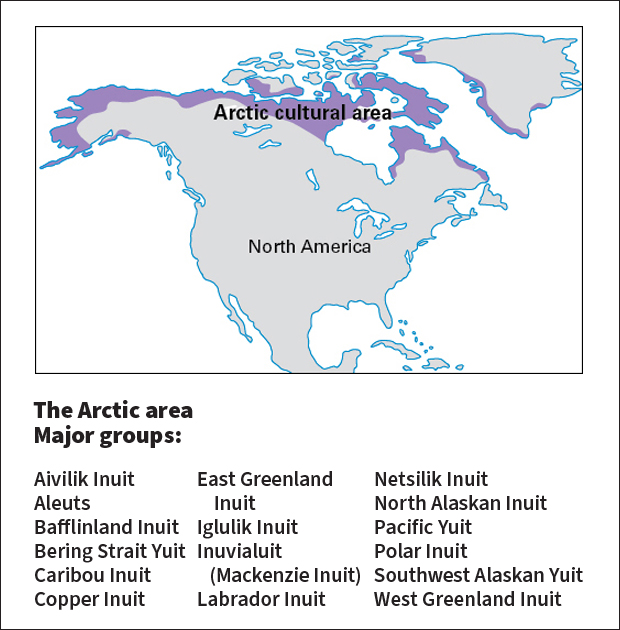
Scholars classify the Indigenous peoples of the North American Arctic into three large groups: (1) the Aleuts, who live on the Aleutian Islands off the coast of mainland Alaska; (2) the Inuit, who live from northern Alaska across Canada to Greenland; and (3) the Yuit, who live in western and southern Alaska, as well as in Siberia, in Russia. The three groups have similar ways of life, but their languages, though related, differ.
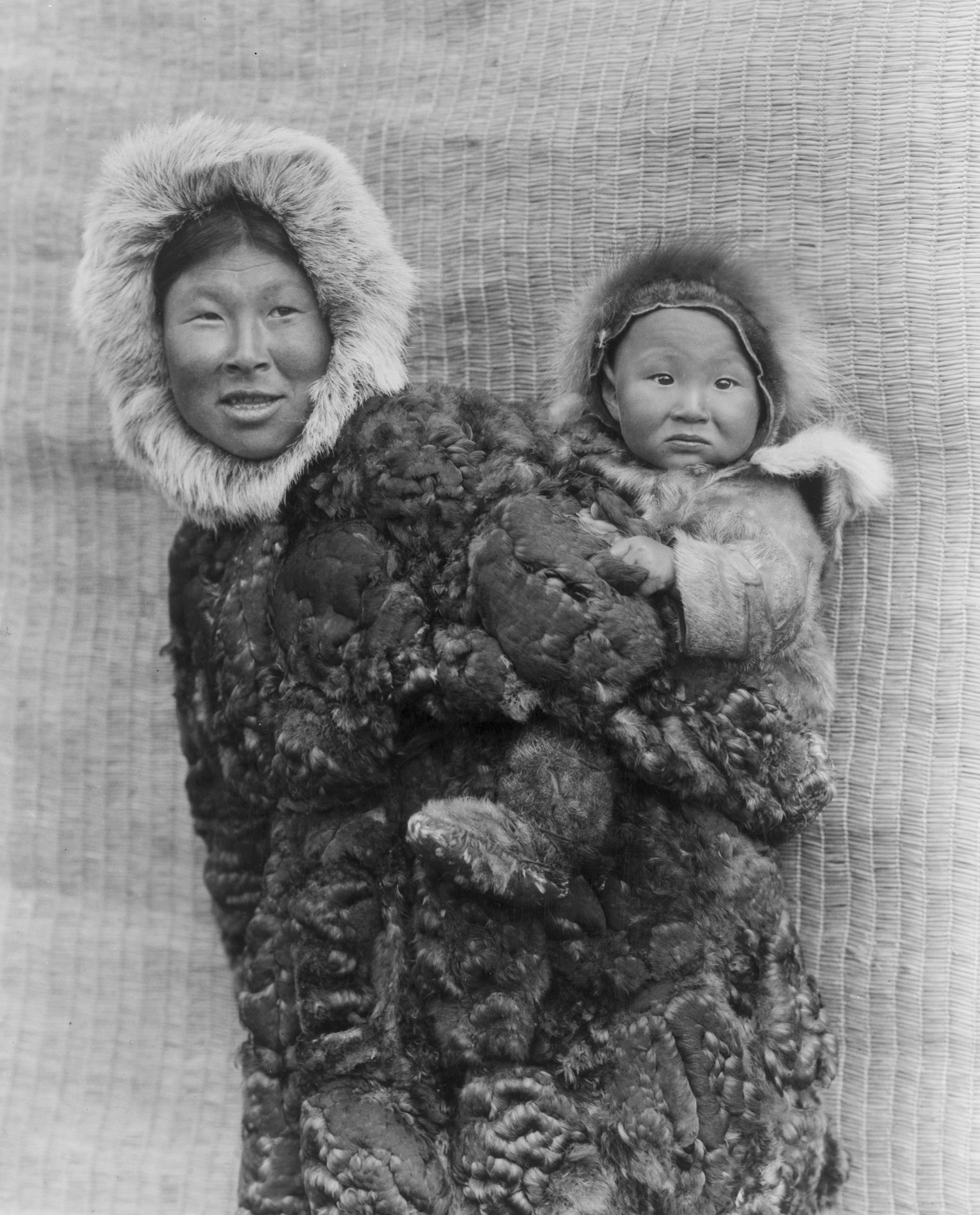
Arctic peoples probably began to migrate across the Bering Strait into the New World about 10,000 years ago. They were the last prehistoric people to arrive in the Western Hemisphere. They are more closely related to peoples who currently live in Siberia than they are to Indigenous Americans south of the Arctic.
Before European contact.
Most Arctic peoples lived in small bands, mainly in widely scattered settlements along the seacoast. The bands moved often in search of food but usually remained within a certain territory. Most Inuit bands did not have permanent leaders. Many Aleut and Yuit villages had chiefs.
Arctic peoples obtained food mainly by hunting and fishing. Seals were the primary food across most of the region. Sealskin was widely used for making shelters and boats, clothes, tools, and other goods. Arctic peoples also hunted a type of deer called caribou and whales, walruses, and other sea mammals for their skin and for food. In much of the Arctic, meat was eaten raw because there was no firewood.
Men, women, and children of the Arctic wore similar clothing. They usually wore a caribou-skin parka (hooded jacket) and trousers and sealskin boots. Babies and young children often rode in the backs or hoods of their mothers’ parkas.
In Alaska and Greenland, many shelters were made of wood, sod, stone, or animal skins. In much of Alaska, forests provided wood for making permanent houses. Some Inuit in Canada built snowhouses during the winter, but they lived in skin tents during the summer.
The Inuit used skin boats for travel and to hunt sea mammals. These boats were made of sealskin or walrus skin stretched over a wooden frame. In the winter, Arctic peoples often traveled across the frozen sea and the frigid land on dog sleds.
Weapons of the Arctic peoples included harpoons, spears, bows and arrows, and knives. Bones and antlers were often used to make arrowheads and spear points.
Arctic peoples believed the animals, mountains, sea, and other things around them each had a spirit. Shamans were thought to have some control over the spirit world. When hunters killed an animal for food, they thanked its spirit.
After European contact.
The Inuit in Greenland came into contact with Vikings about 1,000 years ago. Beginning in the 1500’s, European explorers met the Inuit of northeastern North America. Aleuts and the Yuit of Alaska first met Russian and other European explorers, traders, and colonists in the 1700’s.
Contact between European and Arctic peoples increased during the 1800’s as whaling and the fur trade grew in the region. Rifles obtained from white people enabled Arctic peoples to hunt more efficiently but also eventually led to a scarcity of game animals. Today, the peoples of the Arctic have adapted to the modern world while preserving much of their traditional way of life.
For more information on the peoples of the Arctic, see Aleuts and Inuit.
Peoples of the Subarctic
The Subarctic is a large semiarctic region that includes the interior of Alaska and most of Canada. It is a land of cold winters and heavy snows. The Subarctic has many lakes and streams, and forests of fir, pine, spruce, and other evergreen trees.

Before European contact.
The Subarctic was one of the most thinly populated regions of North America. The people who lived in this rugged region belonged to one of two major language groups—the Algonquian speakers in the east and the Athabascan speakers in the west. In spite of their language differences, the two groups had similar ways of life.

Subarctic peoples lived in much the same way as did the first peoples to migrate from Asia to the New World. Tribes consisted of many small bands. Each band lived in its own territory but was related through marriage to other bands in the tribe. Many groups in the east traced family ties through the father. Subarctic peoples in the west generally traced ancestry through the mother. Most tribes did not have permanent leaders.
Food was often scarce, and the people moved about hunting and gathering wild plants, berries, and nuts. The growing season was too short for farming. Buffalo, caribou, deer, elk, moose, and musk ox were the main animals hunted. Fish and shellfish were important foods along the coasts, rivers, and lakes of the region.
Peoples of the Subarctic made most of their utensils of wood. They made containers but no pottery. In the east, containers were fashioned from bark, and in the west they were made of woven spruce roots.
Subarctic tribes used caribou or moose skin to make most of their clothing. The men wore long shirts, breechcloths, leggings, and moccasins. The women had about the same clothing but wore longer shirts and shorter leggings. In winter, everyone wore robes, mittens, and fur caps for extra warmth. People decorated many of their garments with quillwork, embroidery, or painted designs.
Houses were made of wooden frames covered with bark, brush, or animal skins. The people also built dome-shaped wigwams, lean-tos, and sturdy log houses. Families that moved around a lot lived in tipis.
In summer, the people of the Subarctic used bark canoes to travel on the lakes, rivers, and streams in search of food. In winter, they used wooden toboggans and snowshoes for travel.
Weapons of the Subarctic included bows and arrows, spears, clubs, and knives. In the east, the tribes used stone to make arrow points and knife blades. The western tribes generally used bone and antlers to make tools, and beaver teeth for making knives. Wars were almost unknown.
After European contact.
Indigenous Americans of the Subarctic usually had good relations with the early French fur traders. But the tribes slowly changed their way of life by hunting fur-bearing animals that they traded to the French for weapons, traps, and food. Previously, they had made most of the necessities of life from various parts of the animals they killed.
Indigenous groups took sides in the wars between the French and English colonies. Some fought for the French and some for the English. The tribes also fought one another as a result of competition for the fur trade. Eventually, the Indigenous people lost their land to the settlers. Today, most Indigenous people of the Subarctic region live in areas set aside for them, called reserves in Canada and reservations in the United States.
Peoples of the Northeast
The Northeast cultural area extends from just north of the Canadian border to just south of the Ohio River. It stretches from the Atlantic Ocean, including the coasts of Virginia and northern North Carolina, to about the Mississippi River. The Northeast is a region of cold winters and warm summers. Forests cover much of the area, which is often called the Eastern Woodlands. Rolling prairies lie in the west.
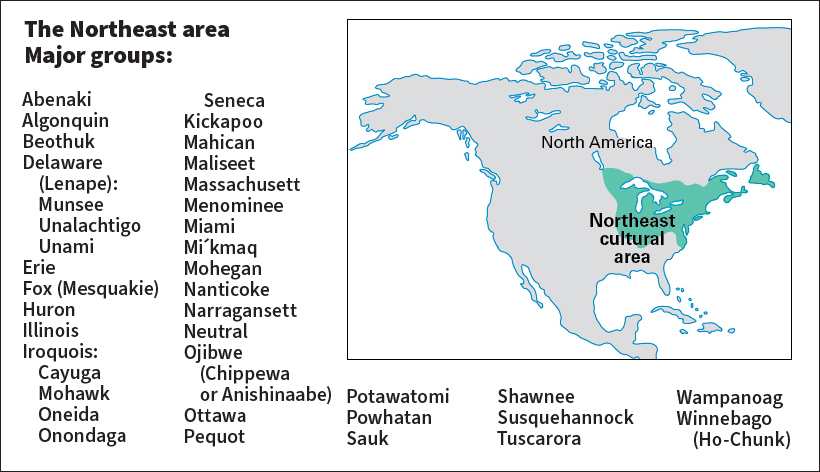
Before European contact.
Almost all the Northeast tribes spoke an Iroquoian or Algonquian language. The Iroquoian-speaking tribes included the Cayuga, Mohawk, Oneida, Onondaga, and Seneca. By the early 1600’s, these five groups had joined together to form the Iroquois League. The Tuscarora joined the league in the early 1720’s. The Huron also spoke an Iroquoian language, but they were enemies of the league.
The Iroquois lived mostly by growing corn, beans, and squash. Slash-and-burn agriculture was the main method of farming. The women farmed and gathered wild plants, nuts, and berries. Men hunted and fished.
Among the speakers of Algonquian languages were the Abenaki in the east and the Ojibwe in the west. Some of the northernmost groups depended more on hunting, gathering, and fishing than on farming. But most Algonquian groups grew corn, beans, squash, and other crops. The Ojibwe and other peoples of the Great Lakes region also harvested wild rice. Some tribes collected the sap of maple trees.
Houses were made to protect people from the cold in winter. Most Northeastern people lived in villages of dome-shaped wigwams covered with bark. Iroquois villages included longhouses with separate sections for related families. Tall fences called palisades surrounded many villages and provided protection from enemies. 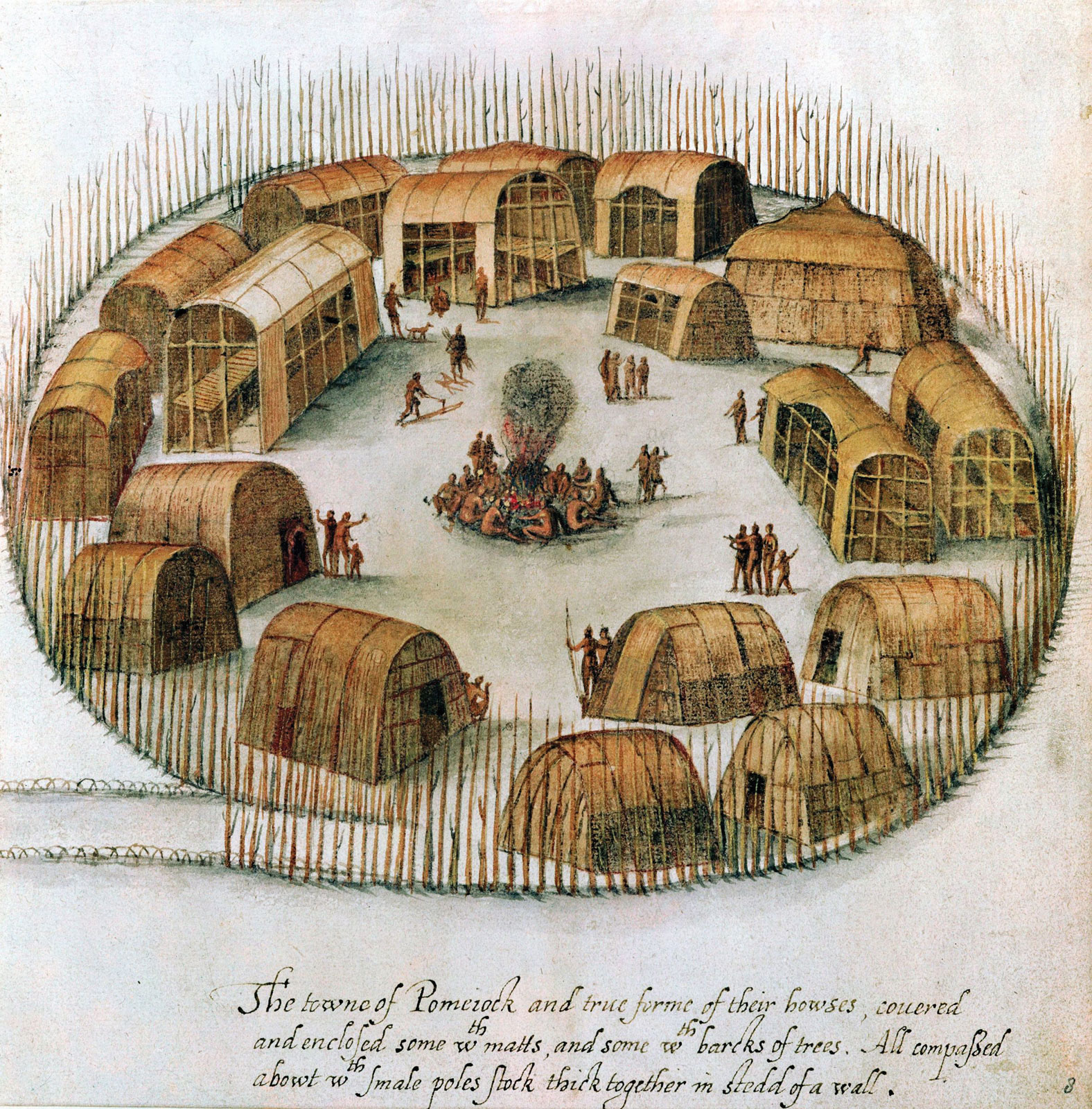
The peoples of the Eastern Woodlands traveled on foot or in bark canoes. Northeastern people made deerskin shirts, dresses, leggings, and breechcloths. Many of these people rubbed their hair with bear grease to make it smooth and shiny. In some groups, men shaved their heads almost completely, leaving only a small tuft of hair on top.
Warfare sometimes broke out among the peoples of the Northeastern region. Weapons included clubs and bows and arrows. The Iroquois were the dominant group in warfare.
Family ties were traced through the father among most Algonquian speakers. Among the Iroquoian speakers and a few Algonquian speakers, however, family ties were traced through the mother. Many Iroquois longhouses sheltered an elderly couple with separate “apartments” for each married daughter. The couple’s married sons lived in the longhouses of their wives’ families.
Leaders of the Eastern Woodlands tribes were called sachems. The five tribes that formed the Iroquois League chose 50 sachems to lead their federation. The sachems were chosen from different clans. Only men could be sachems, but only women had the right to select who became a sachem. If a sachem did not do what the women wanted in council, they could remove him and select a new leader.
When councils of the Iroquois League met, they made decisions by consensus. Sachems would give speeches setting forth their position on an issue. Discussions sometimes went on for hours or days until everyone could compromise and agree on the same plan.
Religion played an important part in the lives of the peoples of the Northeast. These tribes believed in a spirit power that inhabited many creatures and forces of nature and could appear in visions as guardian spirits. In some Algonquian languages, this power was called manito. Medicine people supposedly could summon helper spirits to cure diseases or to predict who would win a war.
Complicated ceremonies were common in the Great Lakes region. The Ojibwe, Ho-Chunk, and neighboring tribes had a secret society called the Midewiwin Society. Its members had special songs, rites, and equipment that they used to reach the gods. Some groups, including the Shawnee, Kickapoo, and Potawatomi, made use of medicine bundles—bags of such objects as animal skins, pipes, dried herbs, and tobacco. Medicine bundles, sometimes known as sacred bundles, were believed to have special powers, and they were opened only during certain ceremonies. The members of the Iroquois False Face Society wore brightly painted wooden masks during their disease-curing rituals.
After European contact.
The tribes of the Eastern Woodlands were among the first to meet European explorers and settlers. At first, the two groups had friendly relations. Squanto, a Patuxet, is said to have taught the white settlers how to plant corn and fertilize it with dead fish. Massasoit of the Wampanoag helped the Pilgrims of Plymouth Colony. In 1621, the Wampanoag and Pilgrims joined in a Thanksgiving ceremony to give thanks for a good harvest and peace. But the friendly relations did not last, and warfare soon became common. Most of the early fighting consisted of small battles between settlers and Indigenous people. Smallpox, measles, and other European diseases killed many Indigenous people.
As the settlers moved westward, they took the land for their own. When Indigenous groups objected, fighting broke out. Some of these battles grew into wars. The Indigenous peoples of the Northeast also became involved in the wars between France and Britain for possession of North America. Indigenous tribes took sides in these wars and often ended up fighting each other as well as the white settlers. The Huron and many Algonquian groups sided with the French. The tribes of the mighty Iroquois League generally allied themselves with the British and helped Britain gain control of almost all of France’s territory in North America.
The Iroquois League began to split during the American Revolution (1775-1783). Some members of the league sided with the American colonists, but most supported the British or remained neutral. After the American victory, white settlers poured onto Iroquois lands. Weakened by diseases and conquest, the league fell apart.
Farther west, the Shawnee leader Tecumseh united many of the tribes of the Northeast and Southeast. The Shawnee and some other groups sided with the British during the War of 1812 in an attempt to push the American settlers off their lands. But large-scale resistance ended shortly after Tecumseh was killed in the Battle of the Thames in 1813.
Many tribes from the Eastern Woodlands now live in Oklahoma and various Western states. The U.S. government forced them to move to these areas during the early 1800’s. But the Iroquois and some others still live on their original lands. Many Iroquois became leaders in the struggle for the rights of Indigenous people in Canada and the United States.
Peoples of the Southeast
The Southeast extends from just south of the Ohio River to the Gulf of Mexico and from the Atlantic Coast of southern North Carolina to just west of the Mississippi River. It is a region of mild winters and warm, humid summers. The terrain varies from the mountains of the Appalachians to the sandy coastal plain, with rolling hills and some swamps in-between. Pine forests cover most of the region.
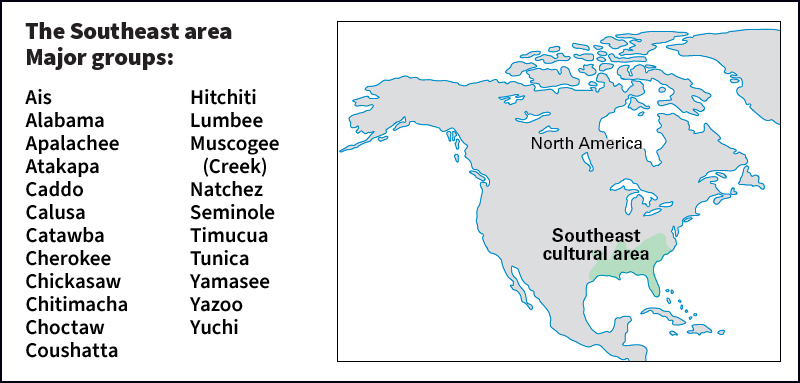
Before European contact.
The tribes of the Southeast included the Catawba, Cherokee, Chickasaw, Choctaw, Muscogee, and Seminole. The Muscogee, Alabama, Coushatta, and a number of other tribes belonged to a federation that European Americans called the Creek Confederacy. Southeastern peoples spoke many languages, including ones belonging to the Algonquian, Muskogean, and Siouan language families.
Southeastern peoples generally had an abundant supply of food. The adequate rainfall and long growing season enabled them to grow large quantities of corn. A favorite drink or soup was sofkee, which was made by grinding and then boiling corn. The people of the Southeast also grew beans, squash, pumpkins, and sunflower seeds, and raised turkeys. The women farmed and gathered nuts, berries, and wild plants. Men cleared the land and did most of the hunting and fishing.
People of the Southeast traveled either on foot or in wooden dugout canoes. Dugout canoes were made by burning out the centers of fallen trees with embers and then chopping out the charred wood with stone axes.
Most Southeastern villages had a central plaza with a council house, a public square, and a ceremonial ground. Most houses were made of wattle and daub—that is, a wooden frame covered by reed mats with plaster spread over them. Palisades enclosed many villages.
The people of the Southeast made deerskin shirts, dresses, leggings, and breechcloths. Women sometimes wore wraparound skirts of woven cloth made of plant fibers. Turkey feathers were sewed onto netting to make robes. Inhabitants of warmer areas wore little clothing, and many decorated their bodies with tattoos and body painting. Muscogee and Chickasaw men shaved their heads almost completely, leaving only a small tuft of hair on top. Choctaw men let their hair grow long.
Warfare sometimes broke out among peoples of the Southeast area. Weapons included bows and arrows and a variety of clubs. Warriors fought for glory and often tattooed their bodies with signs of brave deeds. Elaborate ceremonies accompanied most warfare. Before battle, the warriors gathered in a council house. They painted themselves, performed religious rites, and took special medicines. Sometimes, two tribes would play a stickball game to settle a dispute and thereby avoid a war.
Women had much power and influence among most Southeastern groups. In most cases, family ties were traced through the mother, and extended families in which all the women were related formed the basic social unit. Cherokee women could attain the position of war woman and participate in war councils. A few Cherokee women fought as warriors.
The Southeast had the most complex forms of government north of present-day Mexico. The Natchez people had a king called the Great Sun. He and his family formed the highest class, the Suns. Below them were two other upper classes, the Nobles and the Honored Men and Women. At the bottom were the commoners. The Natchez built temples and the Great Sun’s house on large, flat-topped, earthen mounds.
Many Southeastern tribes had ascending ranks of chiefs. Nearly all chiefs were men. A chief could head a village or a whole region of villages or, in the case of a chiefdom, a whole tribe. Typically, some chiefs represented the peace faction. Others represented the war faction. Councils of assistants, advisers, and shamans helped each chief. In most cases, a man inherited his position of chief from his mother’s brother, not from his own father.
Religion played an important role in the lives of the peoples of the Southeast. The people honored their ancestors and held elaborate funeral ceremonies. Many of the dead were buried with grave goods—that is, pottery and other objects—for use in the afterlife. A number of groups worshiped the sun.
The green corn dance was the most important ceremony of the Southeastern peoples. This annual harvest celebration lasted several days and served as a time for giving thanks. The dance was thought to maintain harmony and to make things pure again. A new year began when a community fire was lit during the ceremony and a woman from each household took some fire for her hearth.
After European contact.
The tribes of the Southeast were among the first Indigenous Americans to meet European explorers and settlers. Armies, explorers, missionaries, and traders from Europe came through the Southeast looking for gold, fur, people to enslave or to convert to Christianity, and even the Fountain of Youth. As the Europeans took the land for their own, Southeastern peoples objected. Warfare between the two groups became common, and many Indigenous people were killed. Many also died from measles, smallpox, and other diseases brought by Europeans.
After the American Revolution, the Cherokee and some other Southeastern peoples tried to adopt the ways of white Americans. They began to dress, speak, and act like whites. White people sometimes called the Cherokee, Choctaw, Chickasaw, Muscogee (Creek), and Seminole the Five Civilized Tribes because white people considered their own ways more civilized than Indigenous customs.
However, white Americans continued to desire the lands of the Southeastern tribes. In 1830, Congress passed the Indian Removal Act. This legislation allowed the U.S. government to move Indigenous people living east of the Mississippi River to a territory west of the river. Thousands of people died during this forced removal to the West, and the Cherokee came to refer to their westward journey as the Trail of Tears. This term was later applied to the forced removal of other Southeastern tribes as well. In some cases, a small part of a tribe managed to remain behind in the East. A small group of Cherokee, for example, fled to the mountains of North Carolina. Today, the tribes that remain in the Southeast try to maintain a balance between traditional and modern ways of life.
Peoples of the Plains
The Plains stretch from just west of the Mississippi River to the Rocky Mountains and from Canada to Mexico. Few people lived in this vast grassland region before the arrival of the Europeans. But after the Spaniards brought the horse to the region in the 1600’s, a new way of life appeared on the Plains. On horseback, the Plains peoples could follow the great herds of buffalo. After new tribes and white settlers arrived on the Plains, fighting broke out.
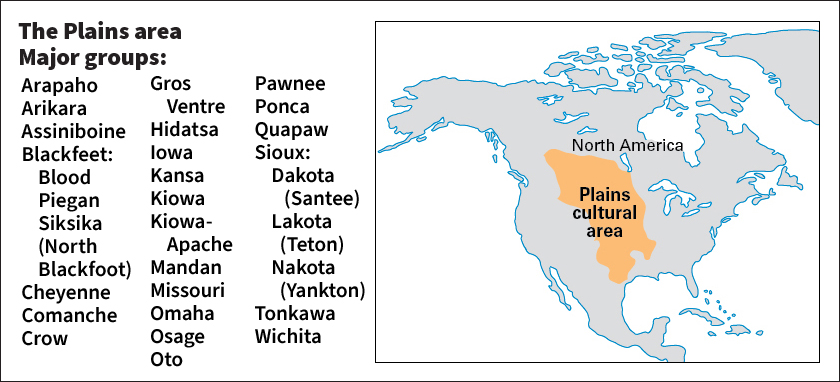
Before European contact.
Most of the original Plains tribes lived in villages along the rivers and streams where the land was fertile and easily cultivated. Out on the grasslands, the tough sod was hard to farm. The women tended crops of beans, corn, squash, and tobacco while the men hunted deer, elk, and sometimes buffalo. During the summer, people left their villages to hunt the vast buffalo herds on the Plains. The huge beasts were difficult to hunt on foot, and so the men tried to stampede herds of them off cliffs or into areas where they could be killed more easily. In the fall, the Plains people returned to the villages and harvested their crops. They pulled the slain buffalo home on travois, which were made by fastening a platform to two poles. Sometimes the people used dogs to pull the travois.
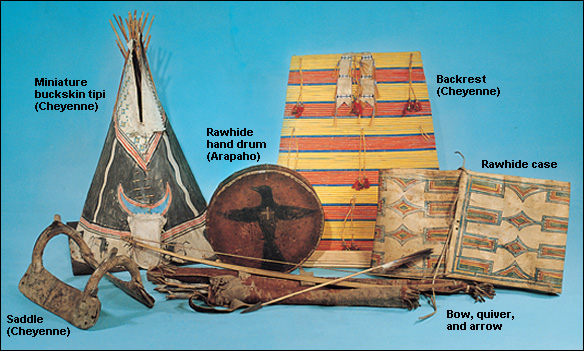
The early Plains peoples wore deerskin breechcloths, leggings, and simple shirts. They used buffalo hides for winter robes and moccasin soles. In their villages, the tribes lived in earth lodges, frames of logs covered with brush and dirt. Out on the Plains, they lived in tipis made of animal skins.
After European contact.
The coming of the horse and gun greatly changed life on the Plains. With the horse, hunters could leave their villages and follow the buffalo herds—which they could not do on foot. Buffalo meat became their main food. The flesh could be roasted over a fire, dried in the sun to make jerky, or pounded with berries and suet to make pemmican. The Plains people used buffalo skins to make clothing, bedding, and tipis. They made the bones and horns into tools and utensils and used dry buffalo manure for fuel. The tribes held many ceremonies aimed at assuring a large enough supply of buffalo.
The tribes on the eastern Plains, sometimes called the Prairies, continued to farm part of the year and to live in earth lodges. But on the western Plains, often referred to as the true plains, daily life became centered on the vast buffalo herds. The buffalo hunters stayed on the move continually. As a result, large tipis, which could be moved from camp to camp, replaced earth lodges as the principal dwellings on the true plains. The people used horses to haul their possessions on large travois. A good buffalo hunter might have two or more wives to prepare all the buffalo hides he brought home.
Nearby tribes, and those forced westward by the advancing white people, quickly adopted the Plains way of life. These late arrivals on the Plains included the Arapaho, Blackfeet, Cheyenne, Comanche, and Lakota.
With many new tribes on the Plains, communication required some kind of common, easily understood language. This need led to the development of the Plains sign language. 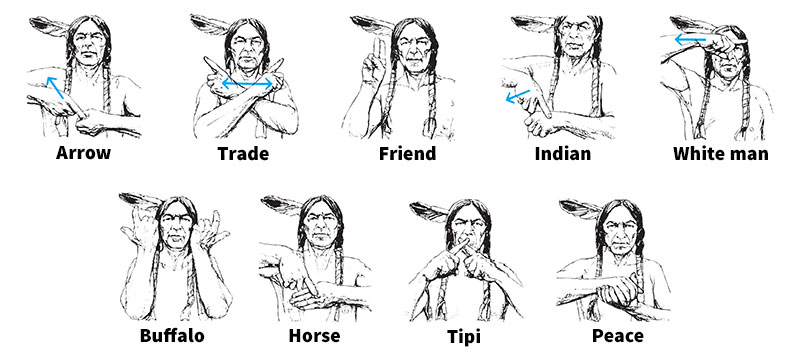
The increasing number of tribes on the Plains fought with one another and with white people. Success in warfare earned fame for a warrior. Counting coup—that is, the act of touching a live enemy and getting away from him—won the highest honor. After battle, the warriors told of their heroic deeds and celebrated their victory. Eagle feathers were awarded for bravery.
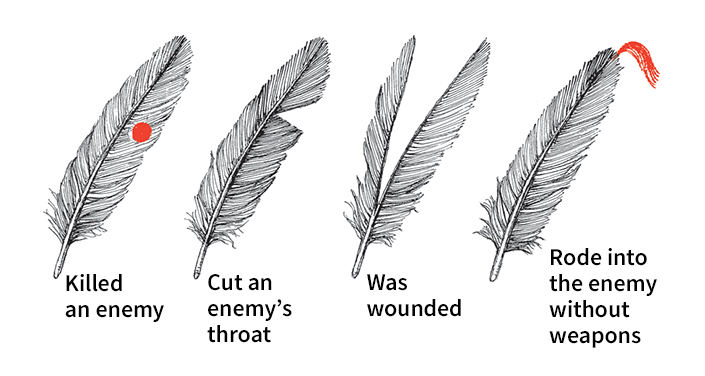
The religion of the Plains peoples centered on spiritual power. Almost every man and some women had a personal guardian spirit that they had seen during a vision quest. Tribes also had medicine bundles containing plants, stones, and other objects with supposed supernatural powers. The most important ceremony was the sun dance.
The widespread killing of buffalo, particularly by white hunters, threatened to wipe out the great beasts. By 1890, the buffalo herds had almost disappeared—and with them, the Plains way of life. In their place came increasing numbers of ranchers and settlers who turned the Plains into cattle ranches and homesteads. The federal government moved many tribes onto reservations and hoped they would take up farming. But the Plains peoples considered farming to be the work of women or white people. They turned instead to warfare and, later, to religious movements. One such movement was the Ghost Dance religion, led by Wovoka of the Paiutes. Some adherents believed that it would bring back the buffalo and remove the settlers from Indigenous lands.
The last major conflict between Plains peoples and the U.S. Army took place in 1890. Federal troops trapped and massacred as many as 300 Sioux men, women, and children at Wounded Knee in South Dakota.
Today, many Indigenous peoples of the Plains still perform the sun dance and other traditional ceremonies. In addition, the Cheyenne and Comanche in particular have become leaders in the Native American Church. Some Sioux became well known for their activities in the American Indian Movement (AIM), a civil rights and treaty rights organization.
Peoples of the Northwest Coast
The Northwest Coast stretches along the Pacific Ocean from southern Alaska to northern California. Fish and seafood are plentiful in the ocean and the rivers of the region. Thick forests rise sharply from the beaches and include giant redwoods, Douglas-firs, and pine trees. The region has a mild, humid climate.
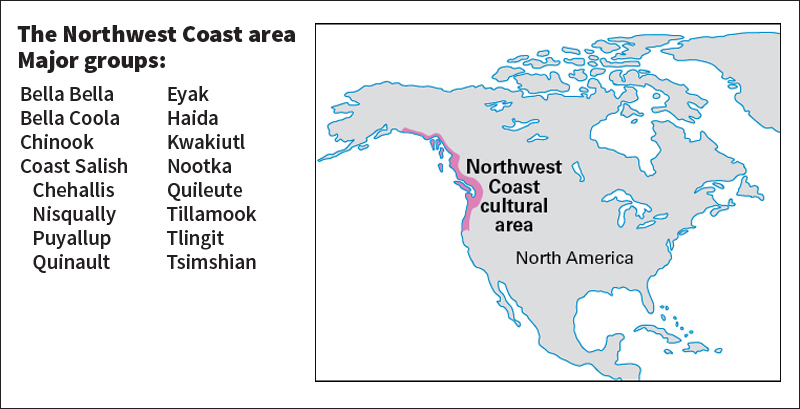
Before European contact.
Among tribes of the Northwest Coast, a few families had great influence in each village because of their ancestry and wealth. People in the north traced family ties through the mother; those in the south, through the father. Tribes measured wealth in terms of such possessions as canoes and blankets. Other valuable property included enslaved people—captured members of enemy groups or their descendants. But sheets of copper, hammered into shield shapes, had the greatest value of all. These sheets are sometimes called coppers.
Men—and some women—of wealth and social position proved their right to high rank at a feast called a potlatch. During a potlatch, which lasted several days, a host fed the guests and gave away many valuable items. The gifts gained respect for the host and the host’s clan and indicated the social rank of the individuals who received the gifts. Some potlatches were held to mark births, marriages, and deaths. During rival potlatches, hosts destroyed a valuable copper shield to challenge their rivals to outdo them at another potlatch.
Food from the sea included not only salmon and a variety of fish, but also seals, sea otters, sea lions, whales, and other animals. Plentiful land animals included bear, caribou, deer, elk, and moose.
The Northwest Coast tribes made elaborate boxes, masks, grave markers, and utensils from wood. They built houses with large posts and beams, covered with planked sides and gabled roofs. Several families lived in one of these large structures.
Great seagoing canoes—some more than 60 feet (18 meters) long—were burned and cut from the trunks of huge cedar and redwood trees. The canoes could hold as many as 60 people. The people carved or painted designs on many of these vessels.
The Northwest Coast people believed in a large number of gods. During the winter, secret societies dramatized various myths. These performances were mainly religious ceremonies. But elaborate costumes, masks, and settings—plus singing and dancing—made them highly entertaining as well.
After European contact.
The peoples of the Northwest Coast came into contact with Europeans later than did the tribes of most other regions. But by 1800, fur trading flourished among the coastal tribes. The iron tools brought by the white traders aided the skilled Indigenous carvers. Totem poles, carved from tree trunks, became more common. Totem poles, which stood in front of homes and in other public places, showed the social rank and ancestry of a family or of an individual.

The coming of white people began the end of the Indigenous way of life almost everywhere in the Americas. But the peoples of the Northwest Coast adapted to the new ways better than most tribes did. In time, some Indigenous fishermen bought motorboats and started to sell their fish catches to commercial packers. Others took jobs in canneries or began to raise potatoes. However, the potlatch and other important ceremonies are still carried out today.
Peoples of California
The California cultural area includes much of California. The area extends from the southern edges of Oregon in the north to Baja, in Mexico, in the south. It stretches from the Sierra Nevada in the east to the Pacific Ocean in the west. The landscape of the region varies from the northern redwood forests to the southern deserts. The climate is generally mild.
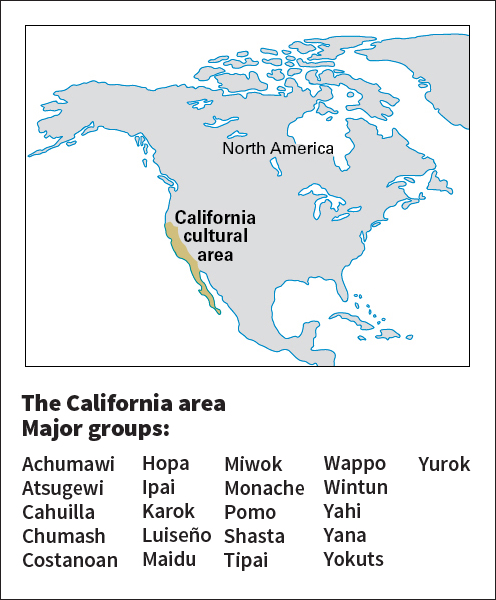
Before European contact.
More languages were spoken in California than in any other culture area of North America. The Indigenous peoples of the region spoke languages belonging mainly to the Aztec-Tanoan, Hokan, Macro-Algonquian, Penutian, and Na-Dene language groups.
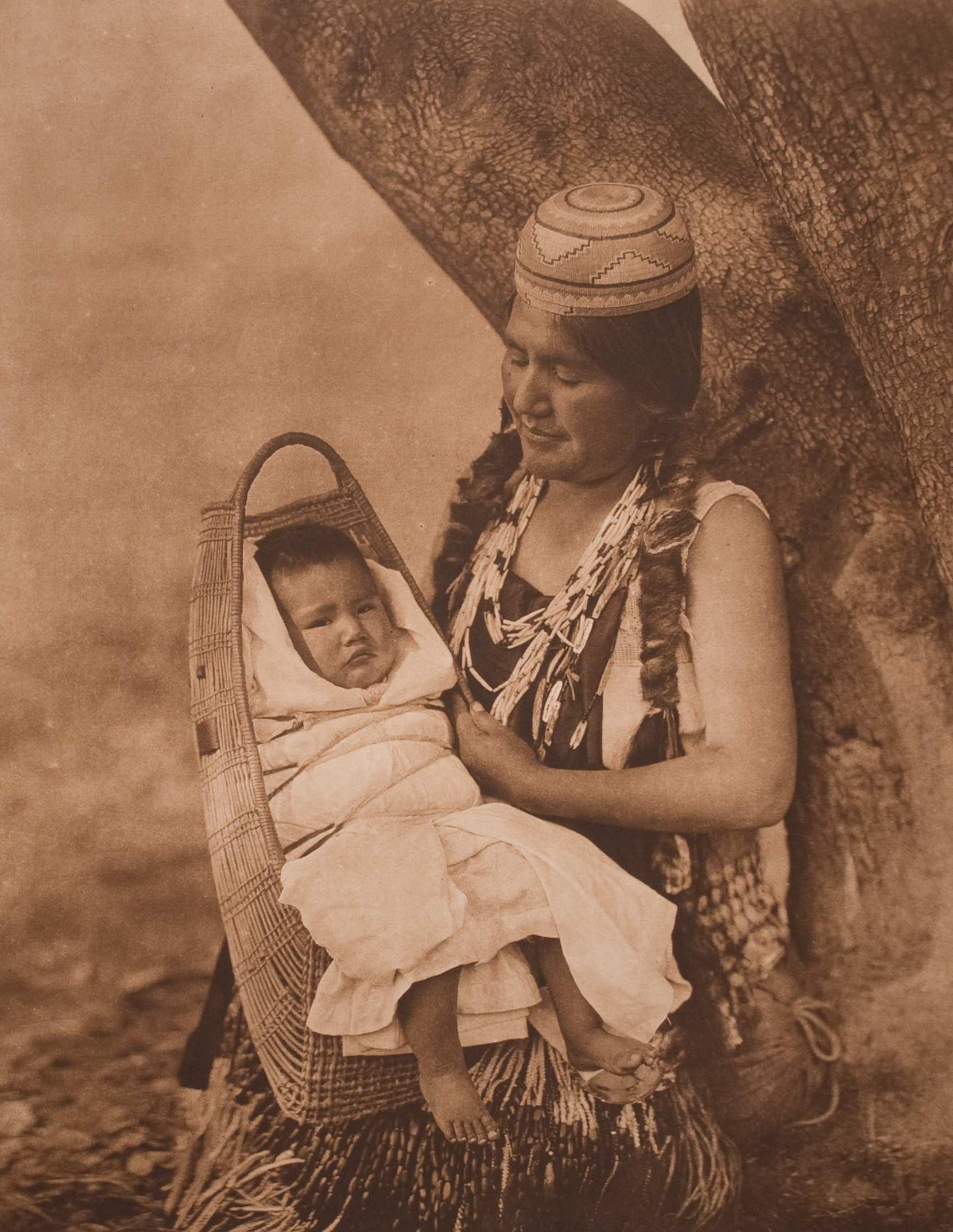
Tribes in the California area consisted of one or a few villages of extended families. Many of these tribes were led by chiefs, most of whom were men. Chiefs organized ceremonies and gave advice about hunting, gathering, and fishing.
Acorns were the most important food. Women gathered acorns, washed them, and pounded them into flour. The women then cooked the flour to make acorn mush or bread. Women also gathered pine nuts, mesquite beans, grass seeds, cactus fruits, and berries. They collected clams and other shellfish along the seacoast. The men hunted such game animals as bighorn sheep, deer, elk, and pronghorns. Some coastal groups hunted seals and other sea mammals. Salmon was the main fish caught.
Housing varied greatly. Houses in the north were made of wooden planks. Farther south, some groups built cone-shaped dwellings that consisted of rush mats, brush, or slabs of bark on frames of poles. Others lived in pit houses. These shelters were dug several feet into the ground and had roofs and sides made of mud and other materials.
The peoples of California wore little clothing. Men typically wore animal-skin breechcloths, and women donned animal-skin aprons or skirts. In cold weather, men and women wore robes made of rabbit skins or feathers to keep themselves warm. California peoples often painted their bodies for ceremonies.
Indigenous Californians believed that people differed from one another because they had different amounts of spirit power. Many tribes held world renewal ceremonies to prevent the spirit power in the universe from disappearing. These ceremonies were also designed to ensure an adequate supply of food. Some groups of California peoples feared ghosts.
The Pomo were famous for their basket making. Pomo women crafted watertight baskets that they decorated with beads, feathers, and shells. 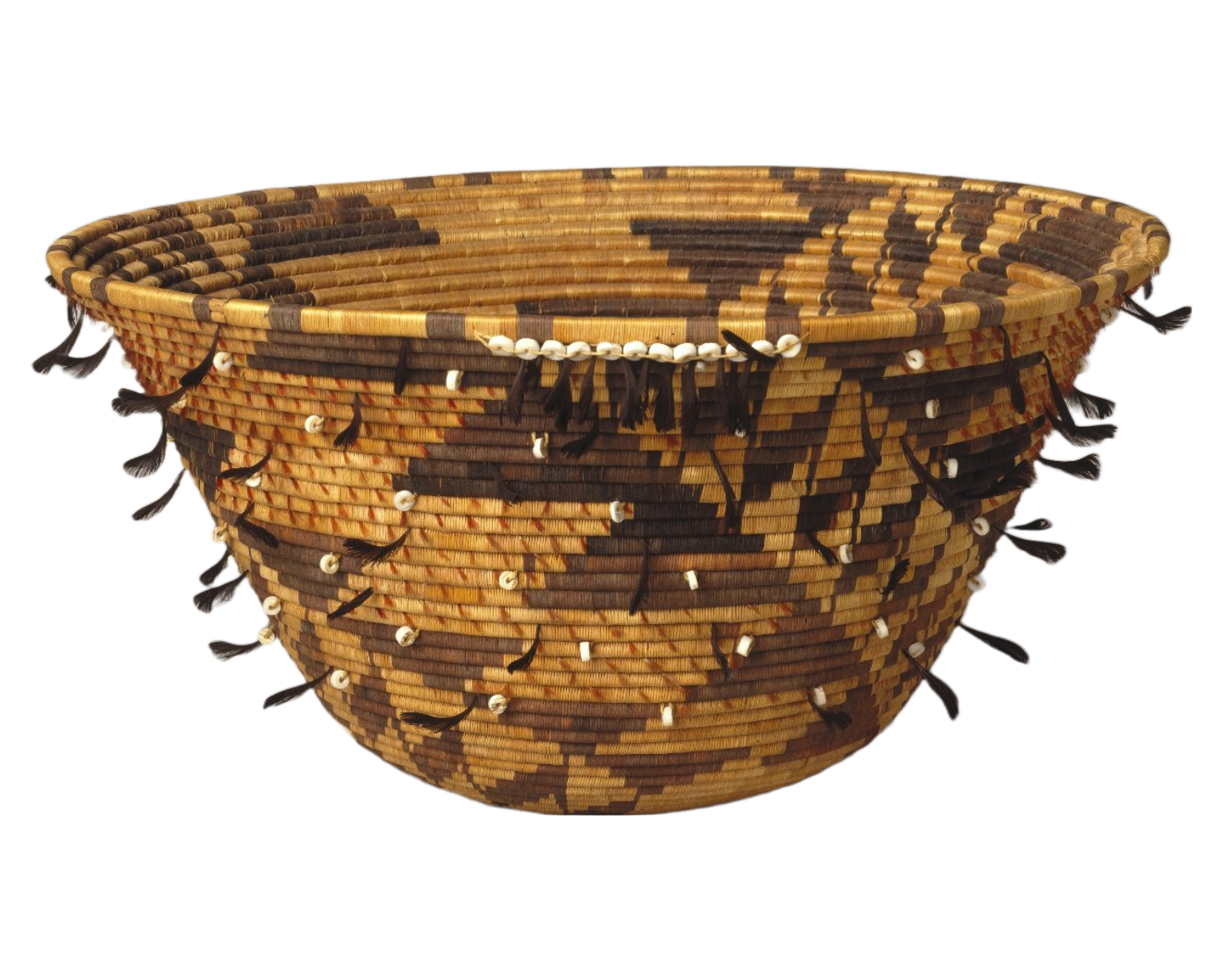
After European contact.
During the 1500’s, Spanish explorers became the first Europeans to have contact with the people of California. After Spanish missionaries established missions in the area during the 1700’s, they encouraged and sometimes forced the Indigenous people to live at these settlements and learn farming and cattle herding. The Indigenous people who converted to Christianity and settled on missions became known as Mission Indians.
The population of Indigenous people in California dropped greatly after contact with Europeans. New diseases brought by the Spaniards and later settlers took many Indigenous lives. After gold was discovered in California in the 1800’s, more Indigenous people were killed by the gold miners who came to the region to seek their fortune. Today, the surviving tribes of California struggle to maintain their traditions.
Peoples of the Great Basin
The Great Basin includes Nevada and Utah and parts of Oregon, Idaho, Montana, Wyoming, Colorado, New Mexico, Arizona, and California. Much of the area is desert, with scattered grasses and sagebrush. Pine forests rise in the mountains and along streams and lakes. Summers are hot. In the northern part of the Great Basin and in the mountains, winters can be cold.
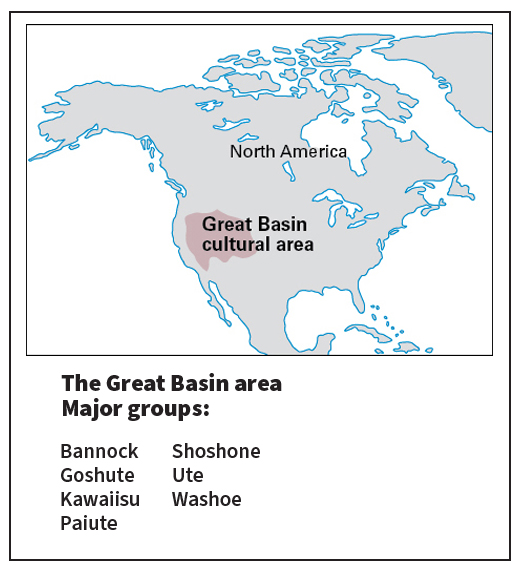
Before European contact.
The tribes of the Great Basin consisted of many small bands, some no larger than extended families. Family ties were traced through both parents. Each band had a home territory near a lake or a stream that provided a reliable supply of water and fish.
Pine nuts were the most important single source of food for Great Basin peoples. Other wild plants used for food included acorns, beans, a type of lily called camas, mesquite, ricegrass, wheatgrass, and wolfberries. A few groups grew corn, beans, and squash. Great Basin peoples fished in the area’s lakes and streams, where they caught mainly salmon, trout, and whitefish. They also hunted such game as pronghorns and rabbits.

Men in the south typically wore animal-skin breechcloths, and those in the north wore moccasins, leggings, and fringed shirts. Women in the south generally wore animal-skin skirts, and those in the north wore dresses, knee-length leggings, and moccasins. In the winter, rabbit-skin robes provided warmth for men and women in both the north and the south.
Shelters varied with the season. In warmer weather, Great Basin peoples built brush windbreaks. In the winter, they constructed a conical shelter of pine poles covered with such materials as sod, bark, grass, and animal skins.
Great Basin peoples believed the world around them was inhabited by spirits. Shamans were thought to have the ability to heal people and improve hunting. Guardian spirits were important. Initiation ceremonies for girls reaching adulthood were common. Great Basin groups also frequently held round dances. In these dances, dancers linked arms and circled a central pole or tree. Round dances were held to ask for rain, to make the plants grow, to ensure a good hunt, and for many other reasons.
After European contact.
The way of life changed dramatically for many Great Basin peoples following the introduction of the horse by the Spaniards. By the 1700’s, the Bannock, Shoshone, and Ute in particular had become buffalo hunters like the peoples of the Plains.
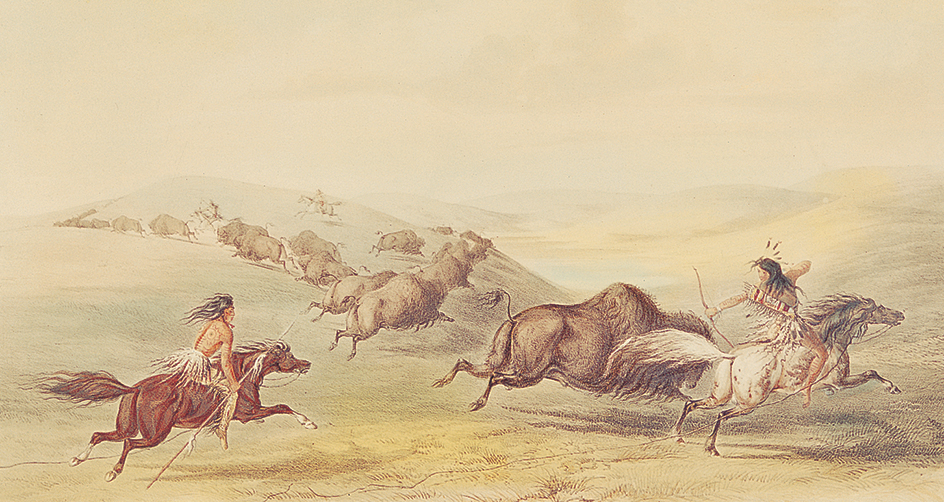
Further changes occurred among the Great Basin peoples after gold, silver, and other minerals were discovered in the area. Miners and other settlers poured into the region, and the Great Basin peoples were pushed from their homes. The settlers’ cattle and sheep ate many of the wild plants that Indigenous people depended on for food. In some areas, sections of the pine forests, which provided Indigenous people with pine nuts, were cut down for lumber.
Today, many Indigenous people of the Great Basin live as ranchers and farmers. Some tribes earn money by leasing mining sites on their land.
Peoples of the Plateau
The Plateau covers most of the southern half of British Columbia east of the coastal mountains. It also includes parts of Washington, Oregon, Idaho, and Montana, as well as a small section of northern California. Forests and grasslands cover most of the north. The south is semidesert.

Before European contact.
The tribes living in the Plateau consisted of bands of extended families. Each band lived in its own territory but was related through marriage to other bands in the tribe. During the summer, bands traveled their territory in search of food. In the winter, they lived in villages. Each village had one or more respected leaders, most of whom were men. These leaders gave advice and helped settle disputes.
The main foods eaten by Plateau peoples were wild bulbs and roots, including camas and bitter root; such berries as blackberries and huckleberries; and salmon and other fish. Women gathered the berries and dug the roots and bulbs. Men did the fishing. They also hunted rabbits and other game.
Plateau men often wore robes, and women wore dresses. These garments were typically made of the skins of deer or mountain sheep or goats, but they could also be made of woven bark fibers. The clothing of some groups included buckskin leggings, moccasins, shirts, and dresses. Nez Perce and many other Plateau women became famous for the basket hats that they wove out of dried leaves.
In the winter, most inhabitants of the Plateau lived in warm pit houses. These shelters were typically built by digging a large, round hole in the ground and placing posts in a circle to form the walls. The cone-shaped roof was covered with dirt. People often entered the dwelling through the smoke hole in the roof. In the summer, Plateau peoples lived in temporary brush or mat-covered shelters that were easy to build and take apart.
Plateau peoples believed that medicine people could heal them and had some control over the spirit world. Both boys and girls went on vision quests to seek out guardian spirits. During round dances, the dancers sometimes went into trances and had visions.
After European contact.
During the 1700’s, some Plateau tribes acquired horses, which the Spaniards had introduced to the New World. The Nez Perce in particular then began to hunt buffalo as the Plains peoples did.
The first white people to have direct contact with the Plateau tribes were the American explorers Meriwether Lewis and William Clark. They traveled to the region during their famous expedition of the early 1800’s along with Sacagawea, a Shoshone woman who served as interpreter. The Plateau peoples had generally friendly relations with the fur traders who soon followed. In the mid-1800’s, however, settlers and miners began to take Indigenous lands. They also brought many deadly diseases, including smallpox and scarlet fever, to the area. The Indigenous groups struggled to keep their lands, and two of the most famous so-called Indian wars of the 1800’s were fought by the Plateau peoples. They were the Modoc War (1872-1873) and the Nez Perce War (1877). Today, many Plateau peoples live on reserves in Canada and reservations in the United States.
Peoples of the Southwest
The Southwest, a huge, dry region, includes Arizona, New Mexico, southern Utah, southern Colorado, and northern Mexico. In the northern area of the Southwest, wind and water have formed steep-walled canyons, sandy areas, buttes, mesas, and other landforms. In the south, the mountains give way to flat, desert country. The Rio Grande and the Colorado, Gila, and Salt rivers cut through the Southwest region.

Before European contact.
The early peoples of the Southwest included several tribes. The Ancestral Pueblo (sometimes called the Anasazi) built cliff houses in the northern area. The Hohokam dug long irrigation canals in central Arizona. The Mogollon hunted and farmed along the rivers of eastern Arizona and western New Mexico. The Pueblo tribes, most of whom were descended from the early Ancestral Pueblo people, had one of the most highly developed civilizations in North America. Most Pueblo lived in villages and farmed along rivers that provided water for irrigation. Their name—Pueblo—comes from the Spanish word for village.
The Pima, Quechan, and Tohono O’odham (also known as Papago) also farmed, though hunting and gathering provided much of their food. They lived in villages but moved from place to place with the changing seasons. The Navajo (also known as Diné) and Apache were other hunting and gathering tribes that migrated seasonally in small bands to obtain food and other resources. These groups came to the Southwest much later than the Pueblo. They often raided the Pueblo people.
The Pueblo depended on corn, beans, and squash for most of their food. They also raised turkeys. Water was important to them because enough rain meant the difference between plenty of food and starvation. Throughout the year, the Pueblo held religious festivals and ceremonies that were aimed at bringing rain and making their crops grow.
The Pueblo were excellent craftworkers. The women made handsome pottery and decorated it with painted designs. They spun yarn from cotton that they grew and wove it into cloth. The men wore cotton breechcloths and cotton kilts. Pueblo women wrapped cotton cloth around their bodies and fastened it under the left arm and over the right shoulder. Around their legs they wore buckskin wrappings that reached to the top of their moccasins. After the Spaniards introduced sheep to the Southwest, the Pueblo began to weave woolen cloth for clothing.
The Pueblo built large, many-storied homes of adobe and rocks. These dwellings housed many families—and some held an entire village. The people usually entered by ladders through the roof. The ladders could be removed in case of enemy attack. They provided protection from the frequent raids by the Apache and Navajo. Sometimes the Pueblo built their dwellings into the sides of steep cliffs, which provided additional protection against attack.
The Pueblo usually fought only when attacked. If a Pueblo killed someone—even in warfare—that individual had to go through a long period of self-purification before returning to live in the village.
The Apache and Navajo, on the other hand, were fierce fighters. These two groups raided the Pueblo in search of food and goods. The Navajo and Apache both learned some farming from the Pueblo, but they depended chiefly on hunting and gathering for their food. They hunted game, including deer, pronghorns, and rabbits, and gathered cactus fruit, roots, piñon nuts, and other plant food.
The Navajo and Apache wore skin garments, though the Navajo later adopted loom weaving and Pueblo dress. A Navajo family lived in a mud-covered log hogan. The Apache did not have permanent houses. Some of these peoples lived in brush shelters, and others lived in tipis.
After European contact.
Francisco de Coronado, a Spanish explorer, was one of the first Europeans to meet the people of the Southwest. He met the Rio Grande Pueblo in 1540 while searching for the Seven Cities of Cíbola, legendary places reported to be rich in gold. Soon afterward, the Spaniards established Roman Catholic missions among the Pueblo. The Spaniards attempted to teach them Christianity and forbade them to perform rainmaking ceremonies. However, the Pueblo continued to practice their old religion, and the Spaniards punished them. Many Pueblo people were killed.
The Pueblo, directed by Popé and several other leaders, revolted in 1680. The Spaniards conquered them again by 1700. This time, many Pueblo fled to live with the Navajo and other Southwestern peoples.
The Navajo learned new ways—both Pueblo and European—from the Pueblo. These included fruit growing, sheep raising, and cloth weaving. The Navajo also adopted Pueblo religious practices, such as chanting, masked dancing, and sand painting. Sand painting, sometimes called dry painting, became an important part of Navajo curing ceremonies. In sand painting, grains of sand, ground-up minerals, and seeds of various colors are arranged into designs.
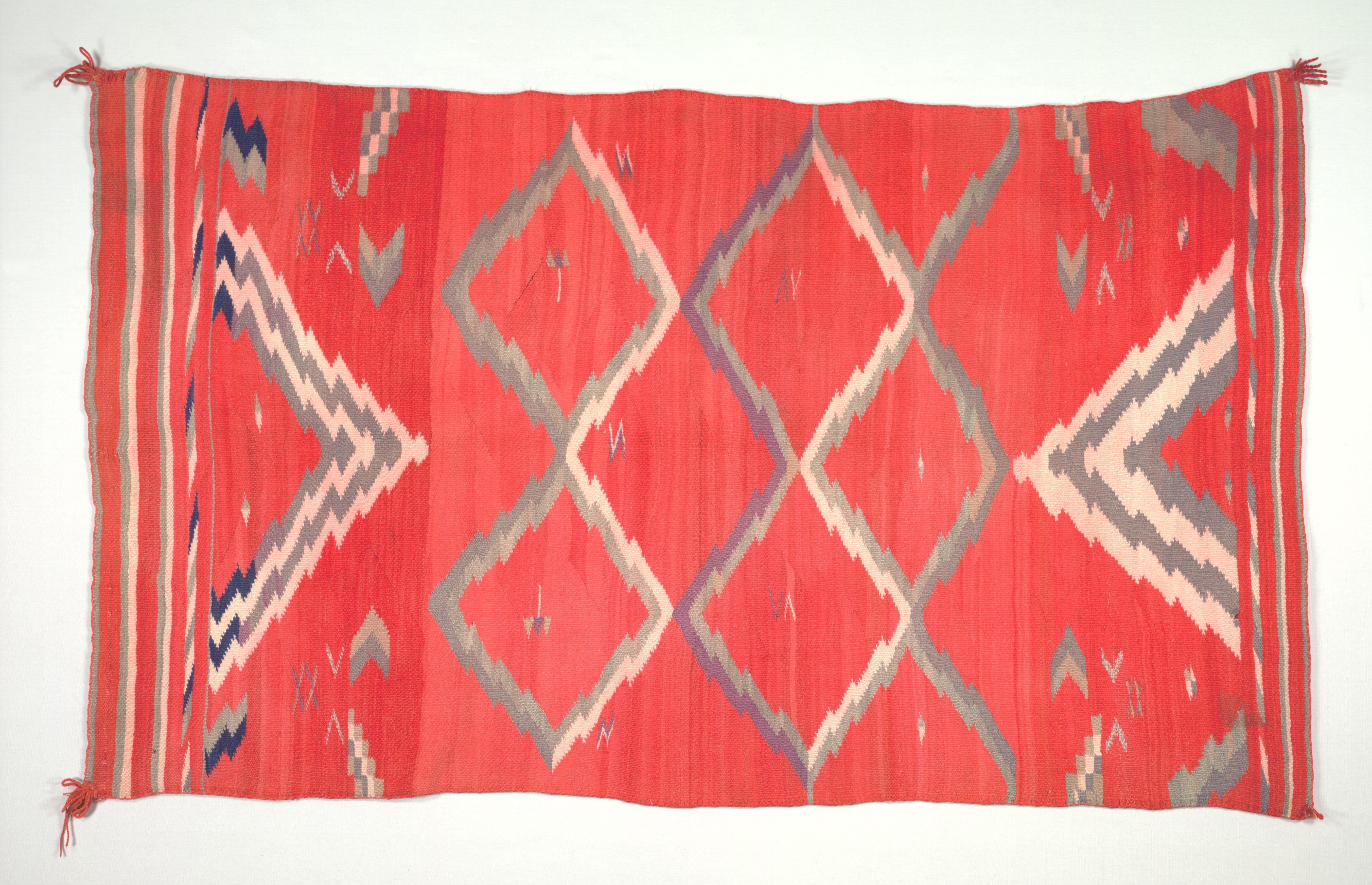
Today, the Navajo are one of the largest Indigenous groups in the United States. They number about 315,000, many of whom live on a reservation that lies chiefly in Arizona but also covers part of New Mexico and Utah. The Navajo have become noted for weaving blankets and rugs and making silver jewelry. Some raise sheep and cattle, but the land is dry and overgrazed. The Apache became famous for their bravery and fierce fighting. Most of the remaining Apache also live on reservations. The Pueblo never completely gave up their religious practices, even under Spanish rule. They—and most Southwestern peoples—have been successful through the years in preserving their traditions.
Peoples of Middle America
The Indigenous peoples of Middle America lived in what are now Mexico, Guatemala, and Honduras. Part of this region lies in the tropics, but the altitude in the mountainous areas and on the plateaus of Mexico makes the weather comfortable the year around.
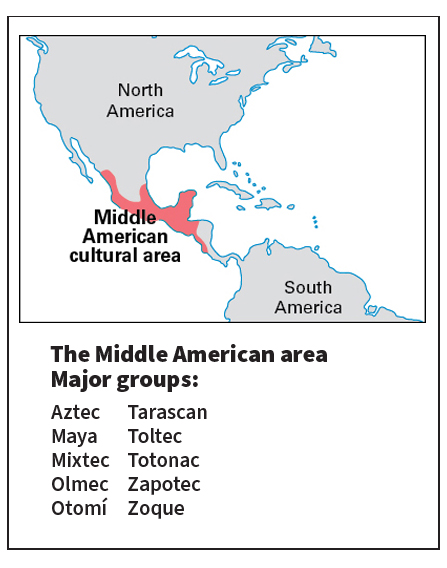
Before European contact.
The people of Middle America were the first farmers of the New World. Agriculture probably began by about 7000 B.C. By 2000 B.C., permanent villages began to appear as the people cultivated corn, beans, squash, and other crops. With farming, the land could support a large population, and some of the people were freed from the continual search for food. More time could be dedicated to arts and crafts, trade, government, and religion. Great cities grew, and the Maya and the Aztec civilizations became two of the most highly developed in the Americas.
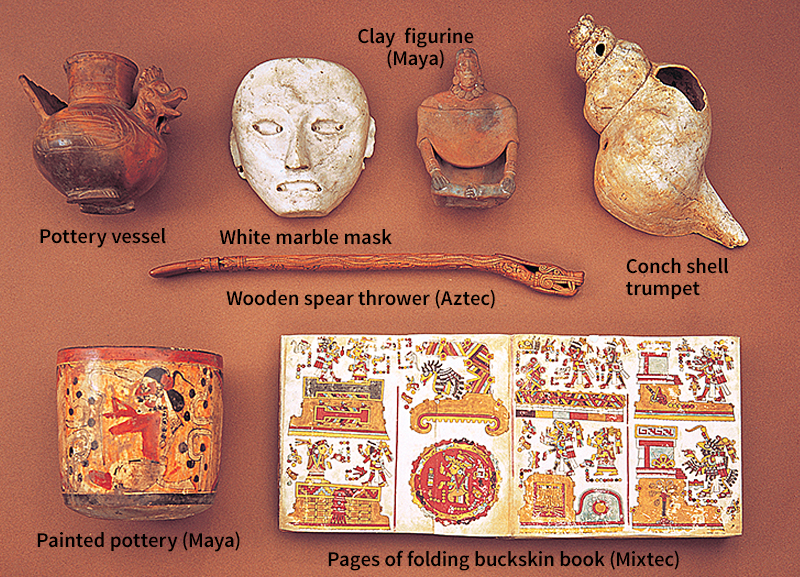
One of the first major centers of Middle American civilization was that of the Olmec people on the southern Gulf Coast in what are now the Mexican states of Veracruz and Tabasco. Between 1200 B.C. and 400 B.C., these people developed both a counting system and a calendar. Ruins of an Olmec ceremonial center have been discovered at La Venta in Tabasco. The site featured an enormous pyramid and was surrounded by platforms and mounds. Four huge heads carved from basalt—the largest about 8 feet (2.4 meters) tall and weighing about 15 tons (14 metric tons)—have been found at La Venta. Scientists believe the heads represent rain spirits. Fine pieces of pottery and jade carving have also been found on this site.
Between about A.D. 100 and 750, Teotihuacán became the largest city of the ancient Americas. With a population between 150,000 and 200,000, it rivaled in size many European and Asian cities of the time. The city’s cultural and economic influence spread through most of Mexico and into Guatemala. Teotihuacán’s vast ruins of pyramids, palaces, and apartment complexes can still be seen just north of present-day Mexico City.
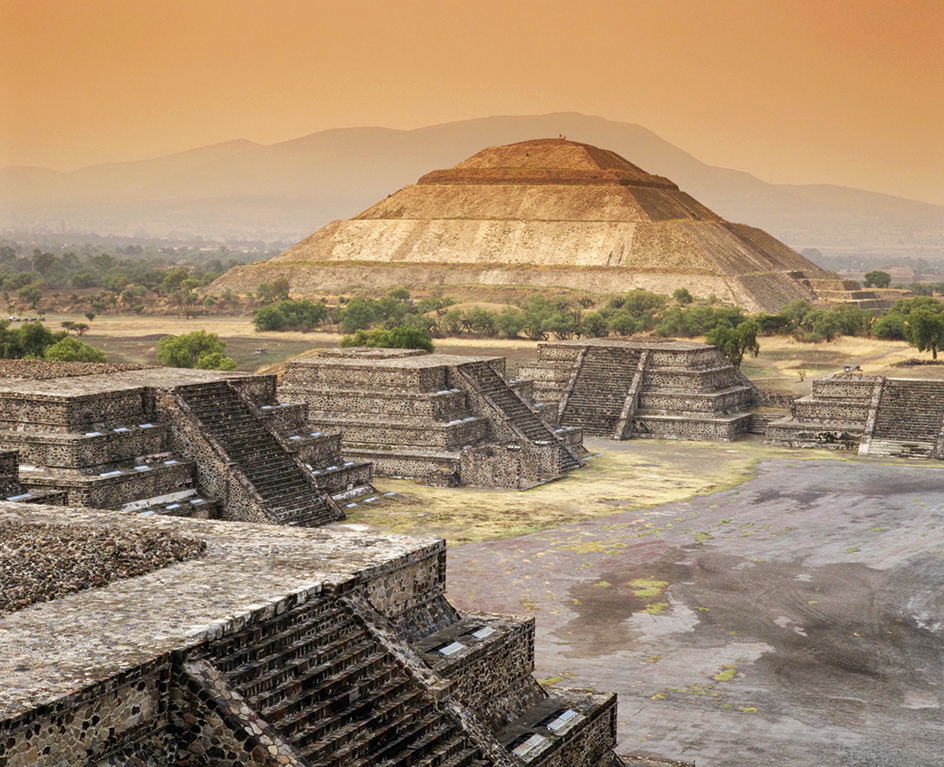
Other great civilizations peaked in Middle America between about A.D. 250 and 900. The Maya built large cities that had tens of thousands of inhabitants. The Maya also studied the stars from observatories and invented a system of writing. Another advanced civilization was developed by the Zapotec people. They had their capital city at Monte Albán, in what is now the southern Mexican state of Oaxaca.
The cities of Middle American peoples included ceremonial structures, such as pyramids, temples, terraces, and courts. Middle American peoples worshiped rain gods, a sun god, and a corn god. They decorated their temples with stone carvings. A ball court formed part of most cities. Most of the peoples of Middle America played a game in which they tried to bounce a ball through a hoop.
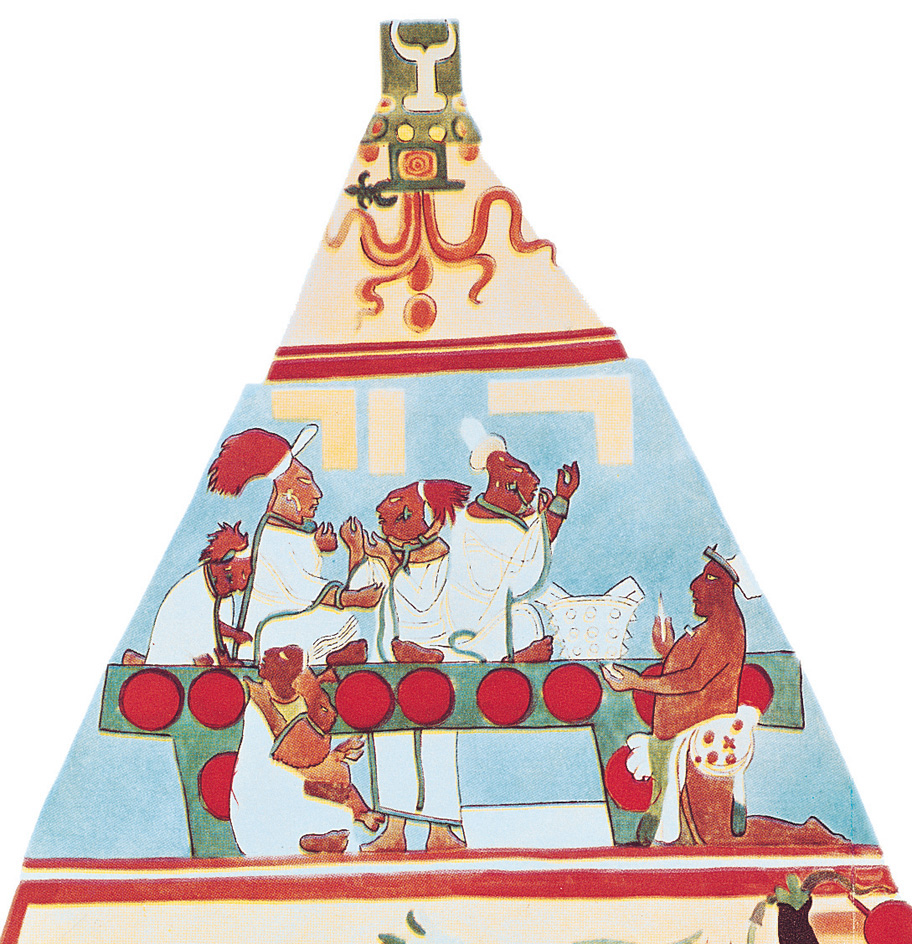
Farmers in Middle America used raised fields and terraced hillsides to make the most of their fertile land. The people of Middle America built houses of poles and covered them with roofs made of leaves and grass. Some houses had roofs made of mud.
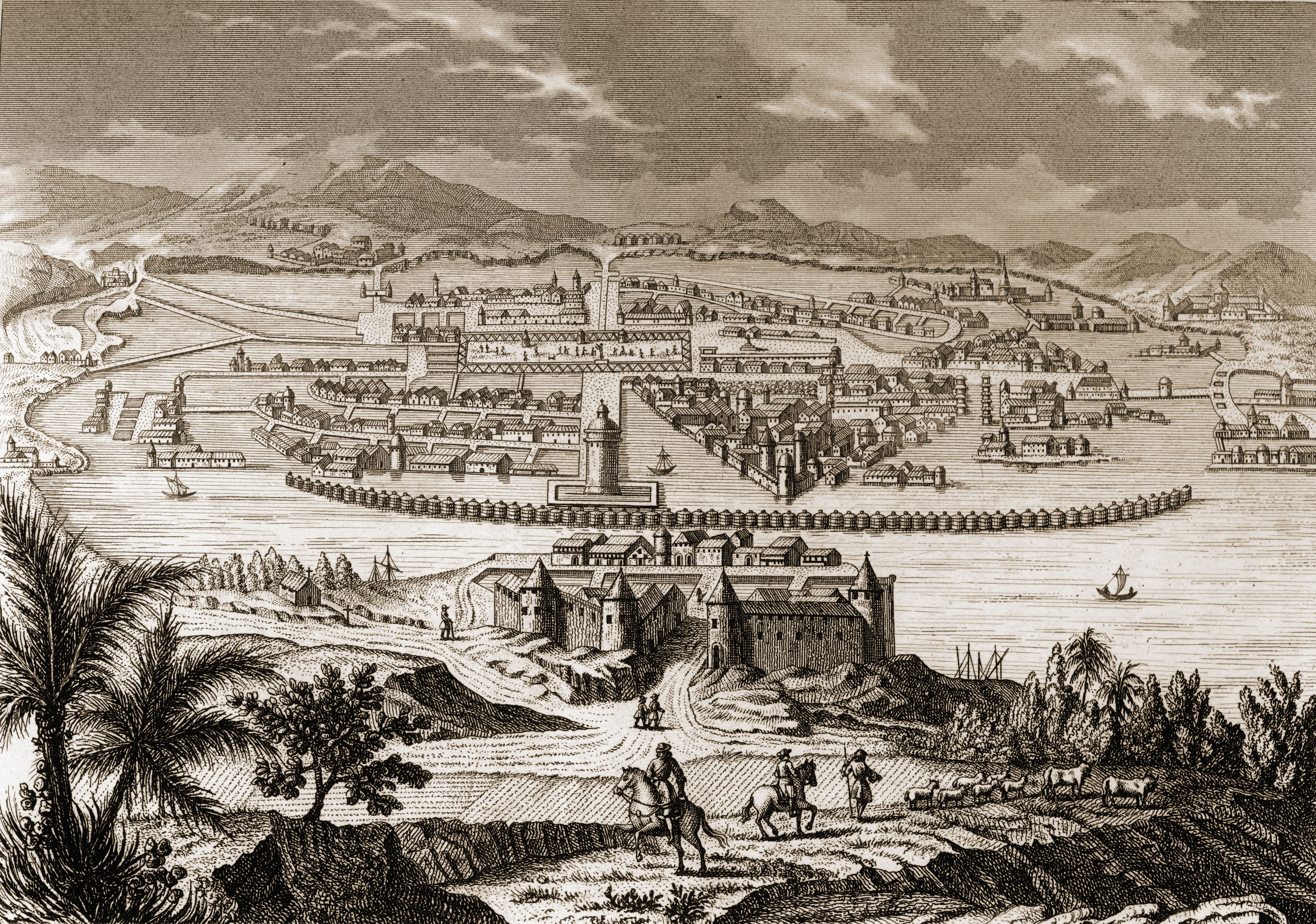
Both men and women wore a coatlike top garment. The men wore a breechcloth under it, and the women wore a wraparound skirt. Poorer people wore cloth made of the fibers of maguey plants, but the others dressed in cotton cloth. Priests and some other leaders often wore feathered headpieces and elaborate jewelry.
Warfare became widespread in Maya areas of Middle America during the 700’s as competition for resources increased. During the 900’s, the Toltec people established an empire in central Mexico, and their influence also grew in Maya lands in the Yucatán Peninsula. The Aztec controlled the Valley of Mexico and the surrounding area from the 1400’s until the Spaniards conquered them in 1521.
A king, chosen from a noble family, ruled the Aztec. He was aided by a council of high-ranking individuals, some of whom were priests. The Aztec waged war for political and economic reasons and also to take captives. They often sacrificed prisoners to the gods.
Tenochtitlan << tay nohch TEE tlahn >>, the Aztec capital, stood on an island in Lake Texcoco, the site of present-day Mexico City. When Hernán Cortés and his Spanish troops arrived in Tenochtitlan in 1519, the city had a population of about 200,000 to 300,000. The people grew much of their food on artificial islands called chinampas that they made by scooping up mud from the lake bottom.
After European contact.
Montezuma II ruled the Aztec when Cortés landed in Middle America. The Spaniards conquered large armies of Indigenous coastal peoples, who had never seen cannons or horses. As Cortés moved inland, he enlarged his army with members of neighboring tribes who hated the Aztec. The Aztec had seized food and goods from these tribes and had sacrificed captives to the gods.
Montezuma did not oppose the advancing Spaniards. Some scholars think he feared Cortés might be the god Quetzalcoatl or his representative. Cortés entered Tenochtitlan and made Montezuma a hostage. The Spaniards treated the Aztec people badly, and the Aztec revolted in 1520. They drove the Spaniards from the city. But the Spaniards reentered Tenochtitlan in 1521 and quickly destroyed it. Thousands of Aztec were killed.
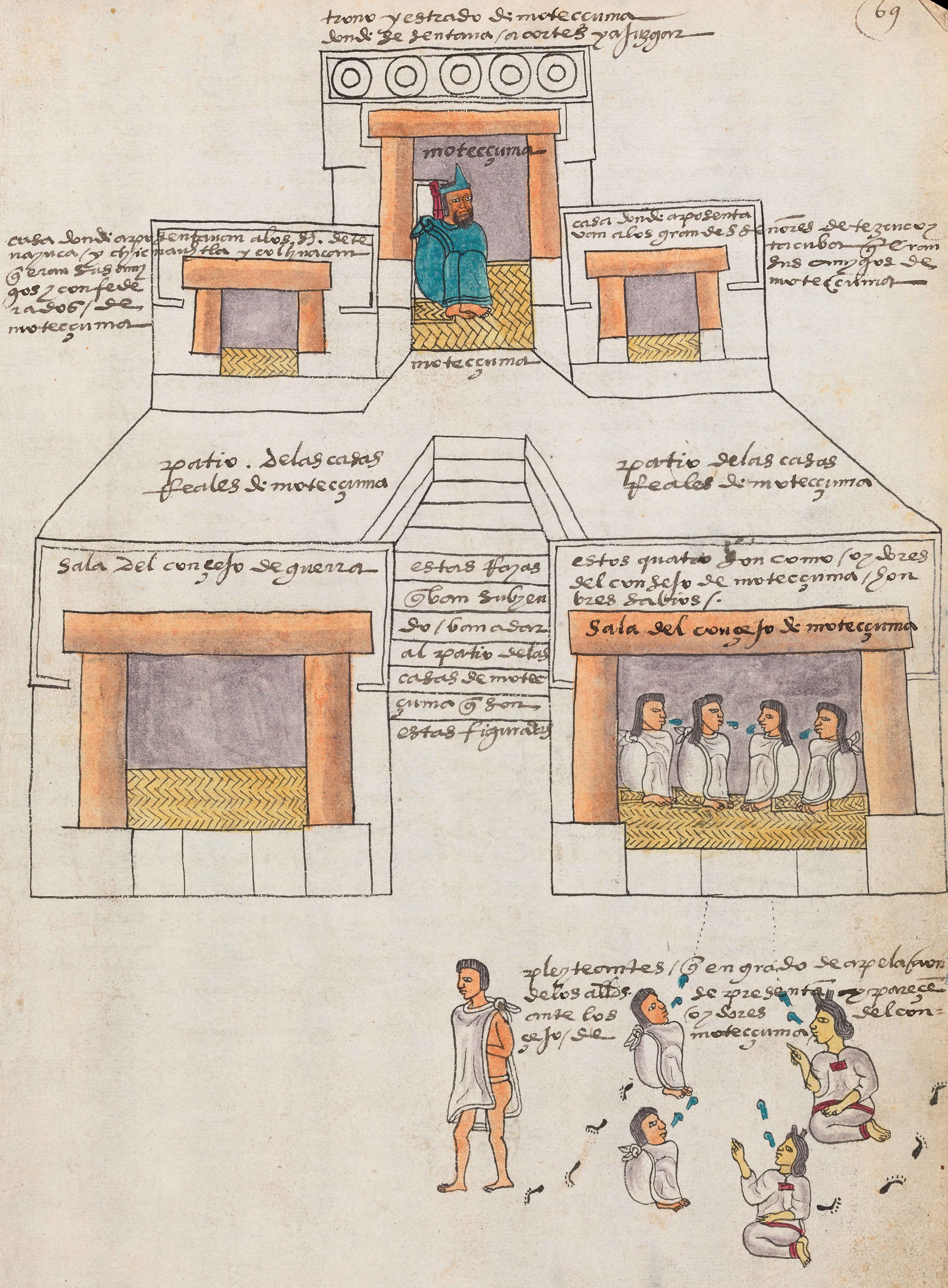
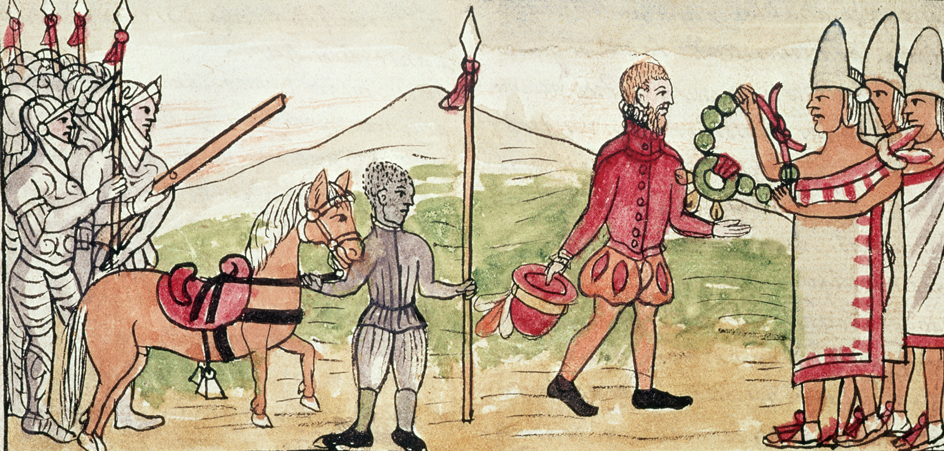
Diseases brought by the Spaniards killed many Indigenous people of Middle America, and the conquerors enslaved many others. Missionaries tried to convert the Indigenous people to Roman Catholicism. Many people adopted the new religion, but they combined it with a number of their old beliefs. In rural areas, life changed little. Agriculture remained the main activity.
Today, Middle America has the largest Indigenous population in the Americas. Indigenous people range from political leaders in the Mexican and Guatemalan governments to people in isolated tribes. Some people of the Maya area still speak a Maya language, but they no longer read the ancient writing.
Peoples of the Caribbean
The Caribbean peoples lived in the southern half of Central America, in the northern parts of what are now Colombia and Venezuela, and on the islands of the Caribbean Sea. Although this region lies in the tropics, sea breezes or high altitudes make the climate pleasant throughout the year.
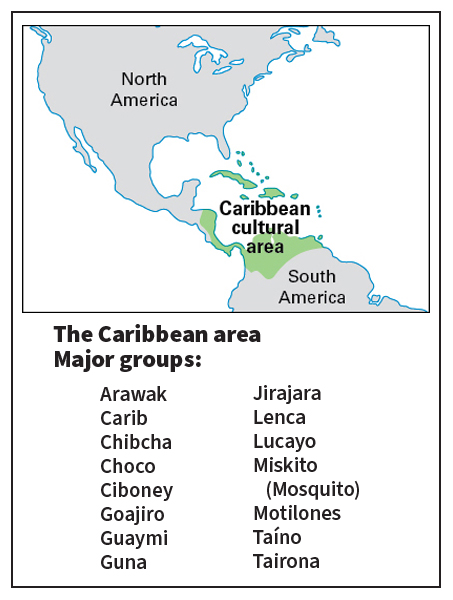
Before European contact.
Important Caribbean tribes included the Arawak of the islands and coastal areas, the Lenca and Guna in Central America, and the Chibcha in Colombia. The majority of Indigenous Caribbean people lived in thatched houses that stood around the center of the community. In the center were the chief’s or king’s dwelling and the temples. A palisade surrounded many towns. The chief was the leader of the town, but sometimes brave warriors were chosen to lead the tribe in war.

Warfare played an important part in Caribbean life. Success in battle led to higher rank for men, and the chief and other leaders had special privileges. The chief, for example, was expected to have several wives, and other members of the tribe cultivated his land. Warfare also enabled tribes to take captives and enslave them.
Agriculture provided most of the food, but much came from the sea and rivers. Both men and women helped raise avocados, beans, cassava, corn, peanuts, peppers, pineapples, and sweet potatoes. Most of the tribes of the Caribbean area brewed a type of beer from corn.
Most of the people wore clothes of cotton cloth, which they wove on looms. The Arawak made their clothing of netting. Caribbean artisans created excellent pottery and shaped gold and copper into a variety of ornaments and tools. Caribbean weapons included spears and spear throwers, slings, clubs, and blowguns. Some tribes also used the bow and arrow.
The Caribbean peoples had elaborate religious beliefs and practices. Many worshiped tribal gods in the form of idols called zemis. The idols were made of such materials as bone, wood, or gold. The people had zemis in their homes, but the chief kept his in a temple. The people often made offerings to the chief’s zemis, which they believed to be particularly powerful. Tobacco—either smoked or inhaled as snuff—was used in religious ceremonies. 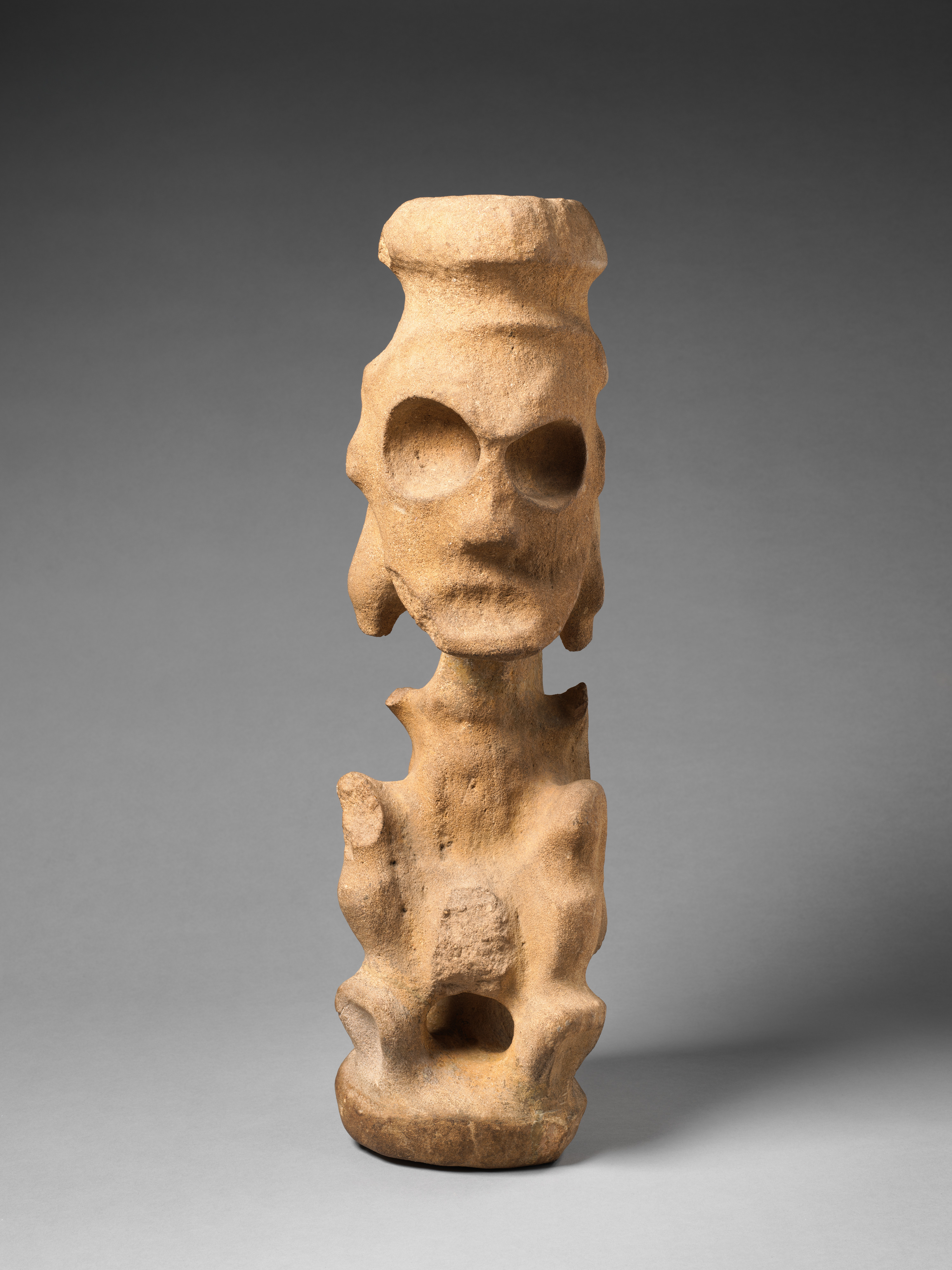
After European contact.
Columbus explored the Caribbean region on his four voyages, and Spanish explorers followed him. Thus, the Caribbean people were the first Indigenous groups to come into permanent contact with Europeans. The diseases brought by the Europeans killed many Caribbean people, and many more died while enslaved. Whole tribes were wiped out, and others fled to remote areas to escape the white people.
Soon, only a few Indigenous groups remained. But even these no longer lived as they had before the Europeans arrived. Food was not so plentiful as it once had been, because the Europeans had driven the original residents onto poor land. Indigenous people no longer made pottery or wove cloth. They used whatever European manufactured goods they could afford. Their religion became a combination of the Roman Catholic faith and their earlier beliefs. Little of the Caribbean peoples’ original way of life remains today.
Peoples of the Andes
The Andean peoples lived in the highlands of the Andes Mountains of South America and in nearby coastal areas. This large region includes southwestern Colombia, central Ecuador, coastal Peru, most of Chile, and parts of western Bolivia and Argentina. More Indigenous people lived in the Andes than in any other region of the Western Hemisphere.
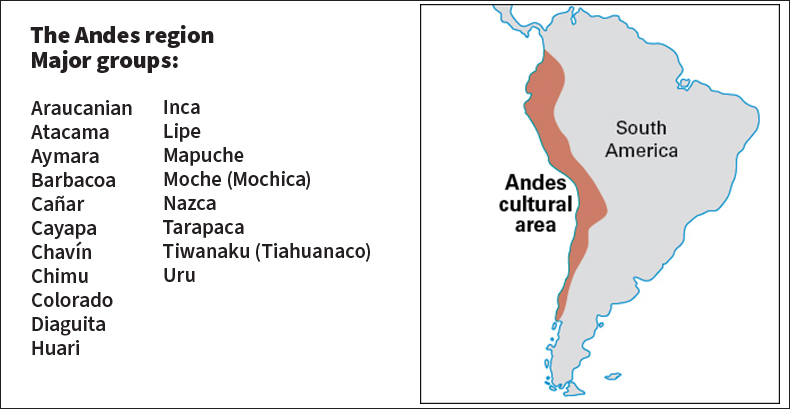
Before European contact.
Human beings settled in the Andes possibly as early as 15,000 years ago. Later, these early peoples tamed llamas, fished, and cultivated some crops, particularly potatoes. By 2800 B.C., cities and large ceremonial centers were being built along the coast of Peru.
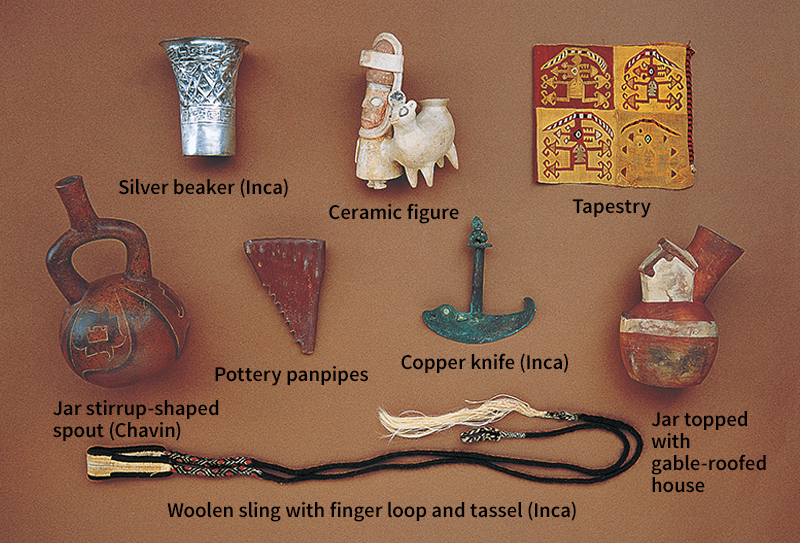
From about 800 to 400 B.C., Chavin de Huantar, in Peru’s north-central highlands, became a great center of religious pilgrimage. The influence of the Chavin civilization spread throughout the Andean world. Later, the Nazca, the Moche, and other cultures developed in Peru. Archaeologists have uncovered spectacular tombs of Moche chiefs in burial mounds near the modern Peruvian town of Chiclayo. The tombs are filled with gold, silver, and other precious objects.
From about A.D. 400 to 900, two powerful Indigenous societies, the Huari and the Tiwanaku (also spelled Tiahuanaco), directly controlled or influenced much of the vast mountainous territory of Peru and Bolivia. They organized large caravans of llamas to trade with other Indigenous groups in distant lands. The Huari and Tiwanaku peoples had contact with each other, and scholars believe the two societies were rivals.
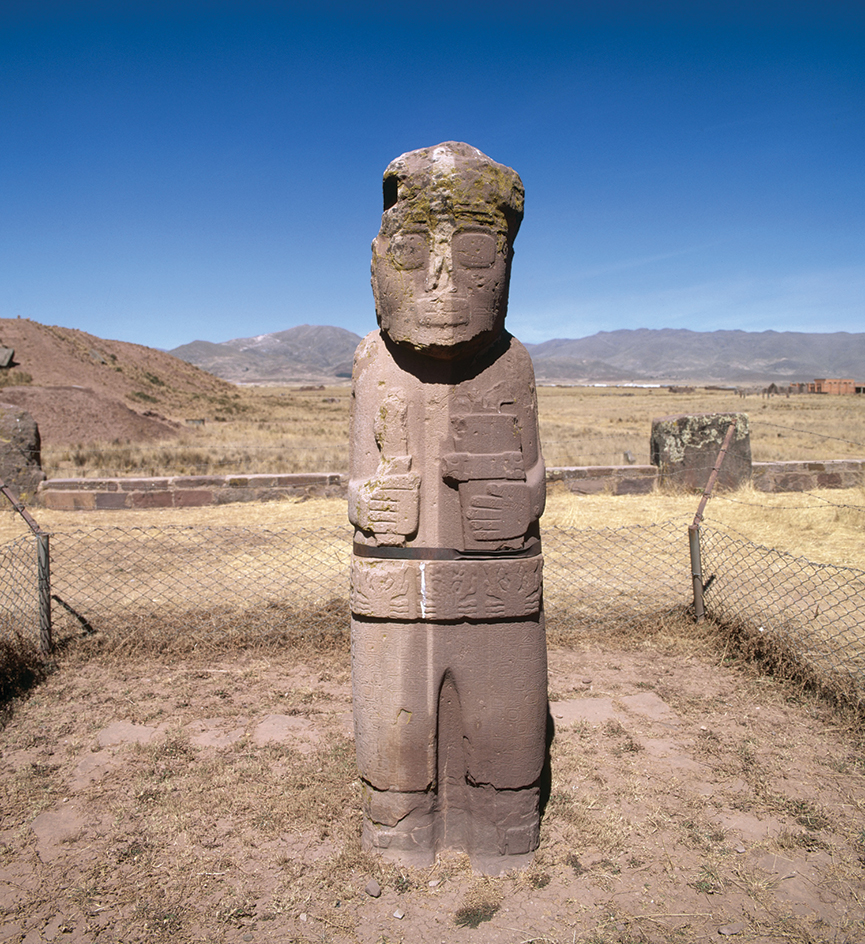
From the late 1400’s to the early 1500’s, the Inca controlled an empire that extended more than 2,500 miles (4,000 kilometers) from southern Colombia to central Chile. The population of the empire numbered between 3 1/2 million and 7 million. The Inca ruled from their capital of Cusco in southern Peru.
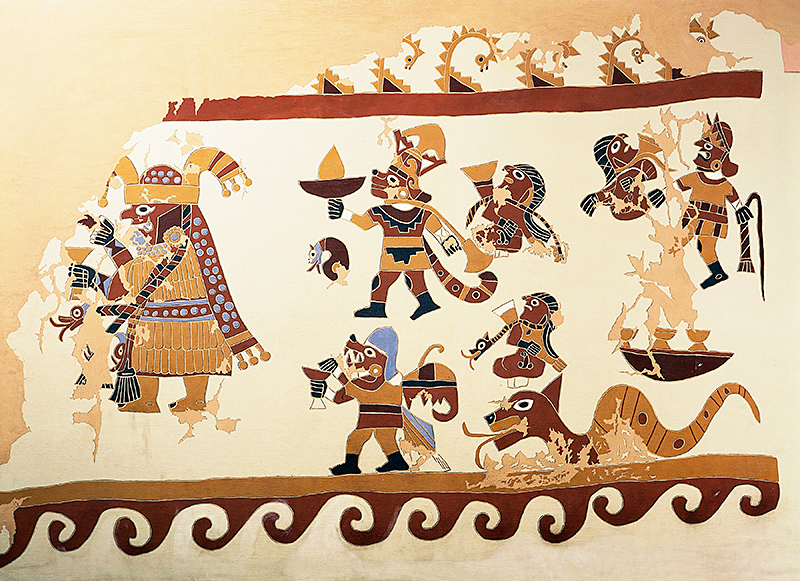
Villages of the Inca empire lay scattered about the countryside, and regional rulers lived in the cities. The regional rulers, in turn, were responsible to the emperor. The Inca believed that their emperor was a god and a descendant of the sun god. They expanded their empire by conquering neighboring tribes. The Inca left many conquered local rulers in charge of their own people. These rulers were forced to learn the Inca language. The conquered peoples raised crops for the Inca, built roads and bridges for them, and served in the Inca army.
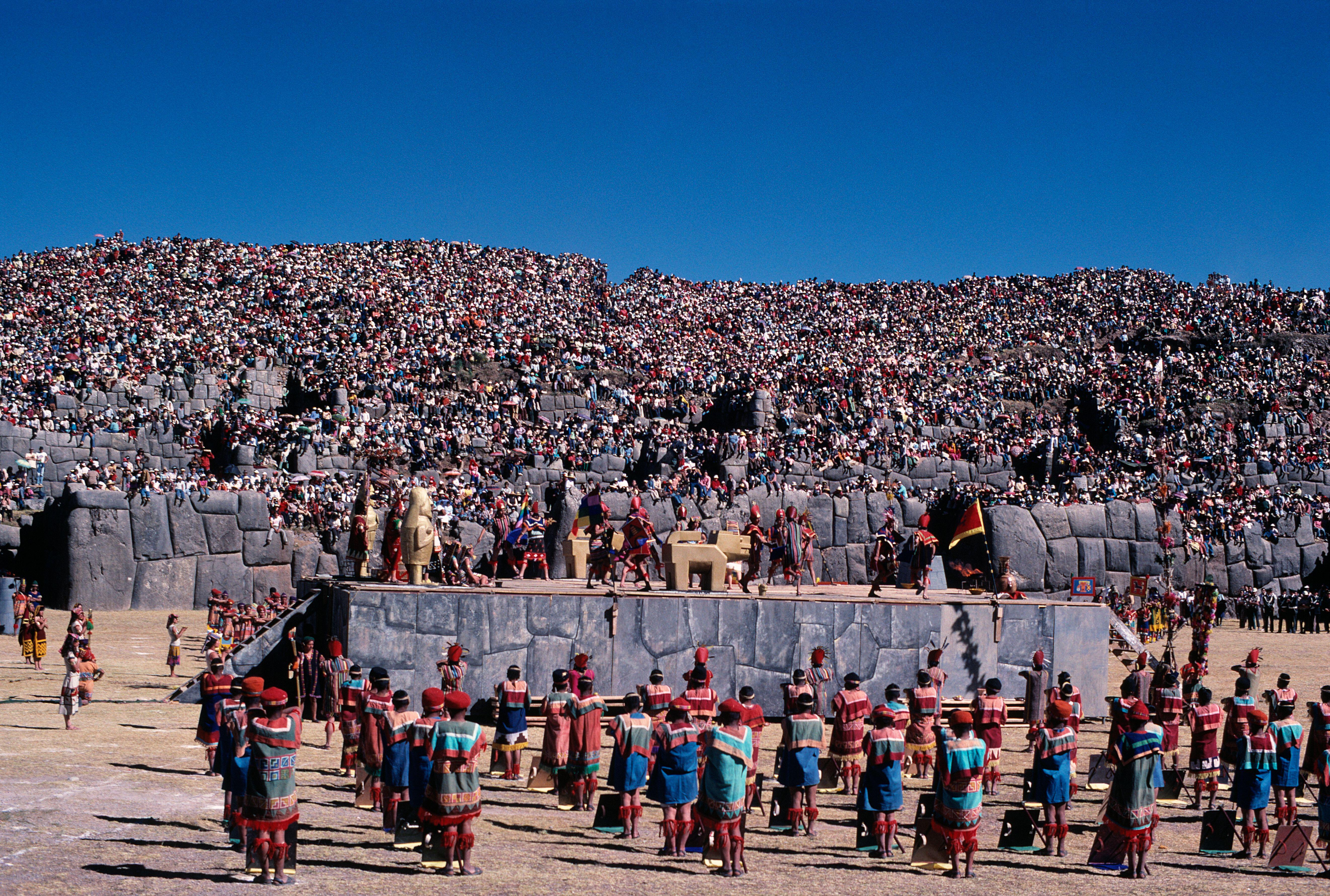
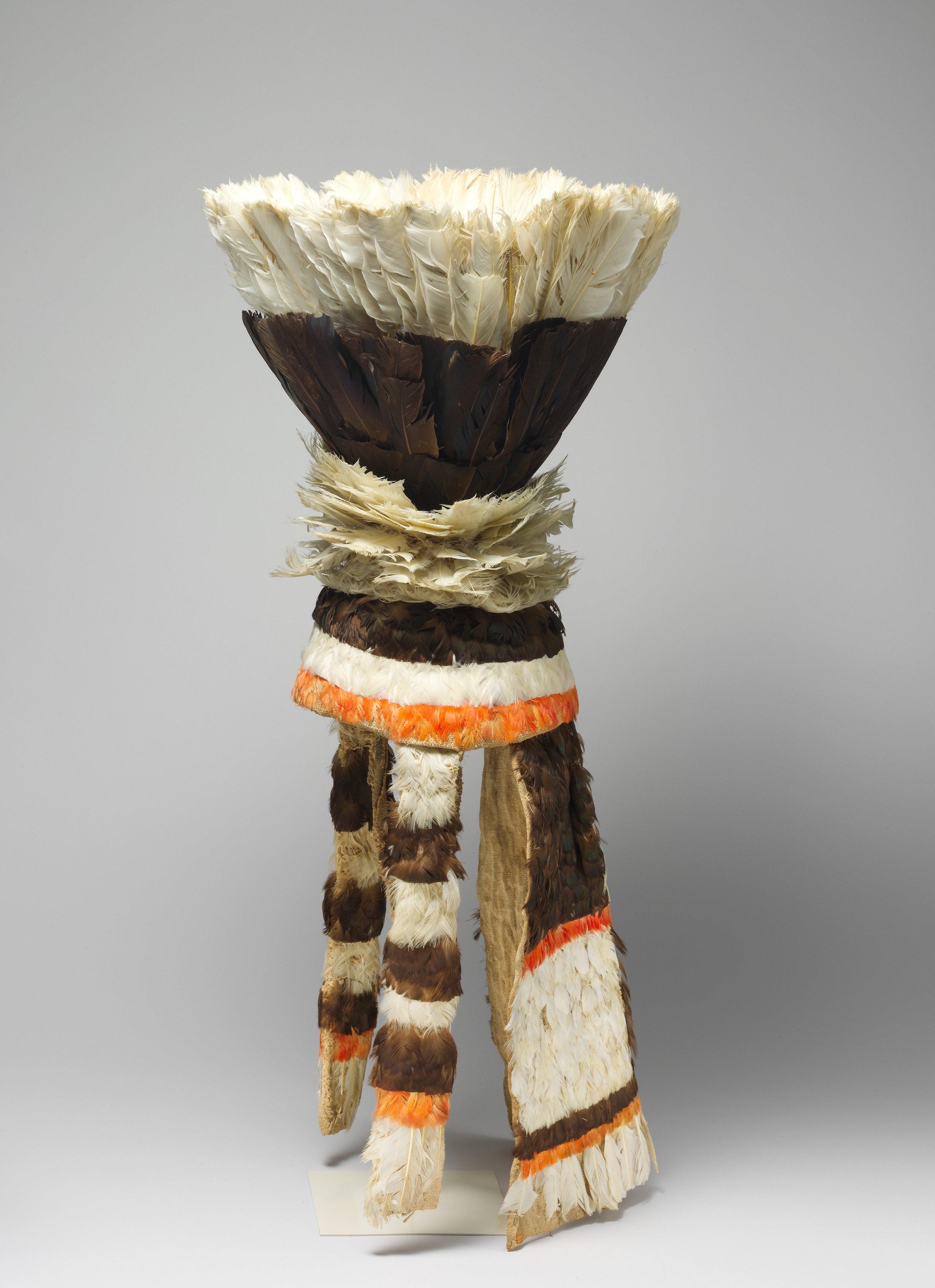
Agriculture flourished in the Andes in spite of the mountainous land. Cultivated plots were terraced on steep hillsides and watered by irrigation systems. The main crops included beans, corn, squash, tomatoes, and white potatoes. Fishing was important along the coast and in the lakes of the region. The peoples of the Andes ate the meat of the llama and the alpaca. They also used these animals as beasts of burden and as sources of wool. The Andean people wove cotton and the wool of the alpaca and llama into skirts, tunics, breechcloths, and capes.
Skilled craftworkers shaped gold, silver, copper, platinum, and bronze into ornaments and tools, primarily for the ruling class. The Inca also produced excellent pottery.
Inca villages had houses made of stone and adobe. In the large cities, huge public buildings were constructed of large stones. The Inca did not use mortar to bind the stones together. However, they carved the stones so carefully that a knife blade could not be inserted between the stones of a building.
The Inca believed in a creator god as well as moon, earth, and sea gods. Their beliefs and ceremonies centered on rain, the sun, and other forces that affected the growing of food. The Inca people kept images of their national gods in temples and held great religious ceremonies there.
After European contact.
The Spanish explorer Francisco Pizarro was the first European to see the Indigenous people of the Andes. In 1532, Pizarro captured the Inca ruler Atahualpa. Rivalry over the throne between Atahualpa and his brother helped Pizarro conquer the Inca empire.
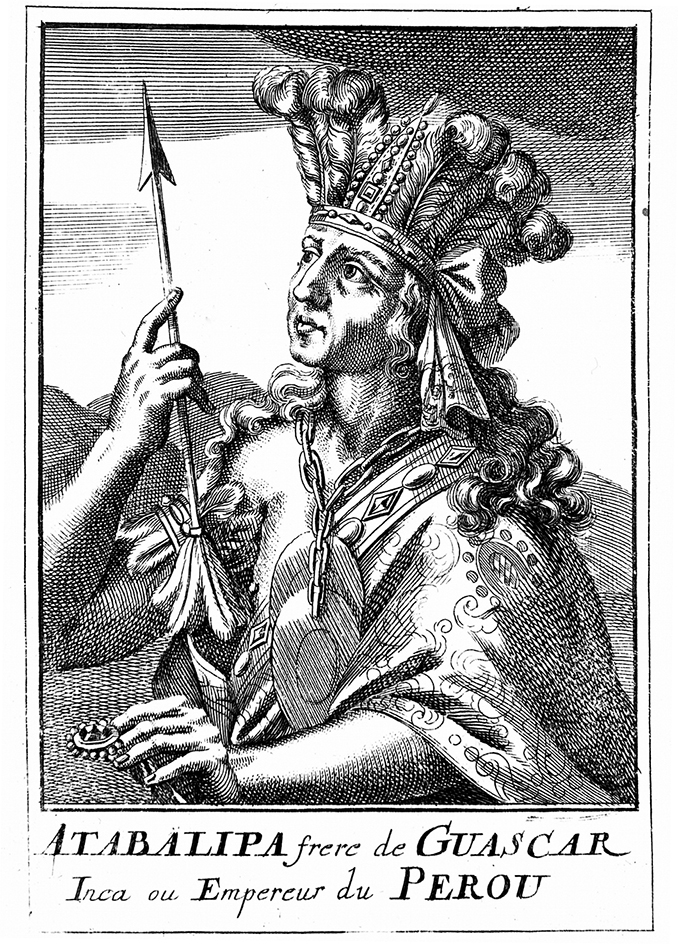
Gold and silver were the main goals of the Spanish conquerors, and they made many farmers work in the mines. Large numbers of Inca died from this forced labor and from diseases brought by the Europeans. The Inca people rebelled several times. The last uprising—led by Tupac Amaru, a descendant of an Inca leader—was crushed in 1782.
Today, the Andean region has the largest Indigenous population in South America. More than 15 million people speak Quechua, which is the Inca language and one of the official languages of Peru.
Peoples of the Tropical Forest
Peoples of the Tropical Forest lived along rivers and in the jungles that cover almost all of what are now Guyana, Suriname, and French Guiana; much of Brazil; southern Colombia and Venezuela; and eastern Bolivia and Peru. Farming was the main source of food in this hot, humid region.
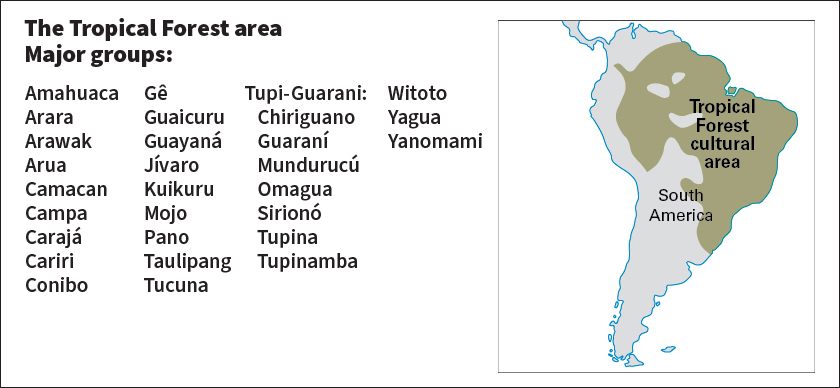
Before European contact.
Most Tropical Forest people lived in small villages of related families. However, some Tropical Forest societies were organized as complex chiefdoms. The people of these societies constructed large ceremonial centers and occupied densely populated villages and towns. The most complex societies in the Tropical Forest region developed along the middle and lower Amazon River in Brazil and in the vast lowlands of eastern Bolivia.
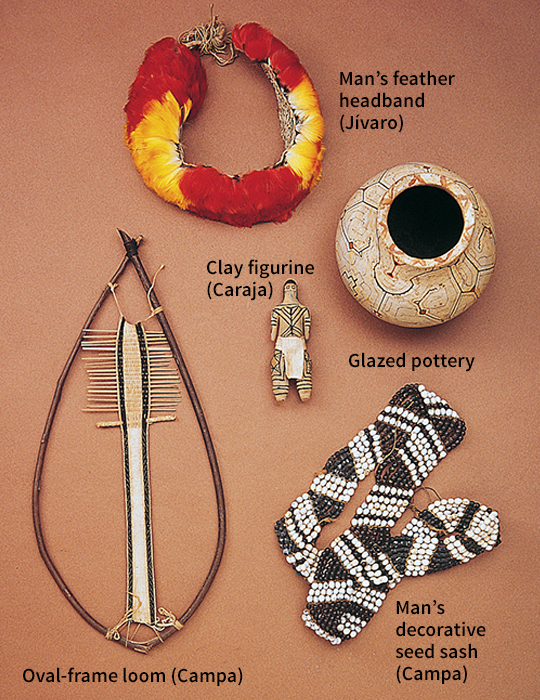
Inhabitants of the small villages of the Tropical Forest farmed by the slash-and-burn method, and cassava, the source of tapioca, was their chief food. Cassava roots contained a poisonous substance that had to be removed. The people grated and squeezed the roots to remove the poison. Then they ground the remains into meal for making bread or porridge. Other crops included beans, corn, squash, sweet potatoes, and tobacco. Small game and fish also provided food.
The Tropical Forest people wore only breechcloths and short, apronlike skirts. But they covered themselves with painted designs and wore jewelry. Their housing was simple, consisting of a pole framework and thatch roof. The sides were left open, and hammocks were often the only furniture. Some tribes built a single large house for the whole village. In other communities, each family had its own house.
Hunters in the jungles used spears, bows and arrows, and blowguns. They fished with nets, hooks, and drugs that stunned fish. Warfare occurred frequently between tribes. The Witoto and Tupinamba were cannibals, and the Jívaro shrunk the heads of captives as trophies.
After European contact.
The people of the Tropical Forest did not have much early contact with the Europeans. The explorers and colonists had little interest in either their land or its resources. Later, many of the region’s Indigenous people went to work on the plantations of the Europeans. This closer contact brought about the usual increased death rate from disease and the gradual decline of Indigenous ways.
Today, groups of Tropical Forest people still live in South America. They have borrowed some items from the European culture, especially weapons and utensils. Some of the people work on the plantations from time to time or grow such crops as sugar cane and bananas. They sell the crops to buy manufactured goods.
Peoples of the Marginal Regions
Peoples of the Marginal Regions barely managed to exist on the poor lands of eastern and southern South America. Most of these people lived on the plains, which had little plant or animal life. Those who lived on the cold, rainy coasts also lacked natural resources.
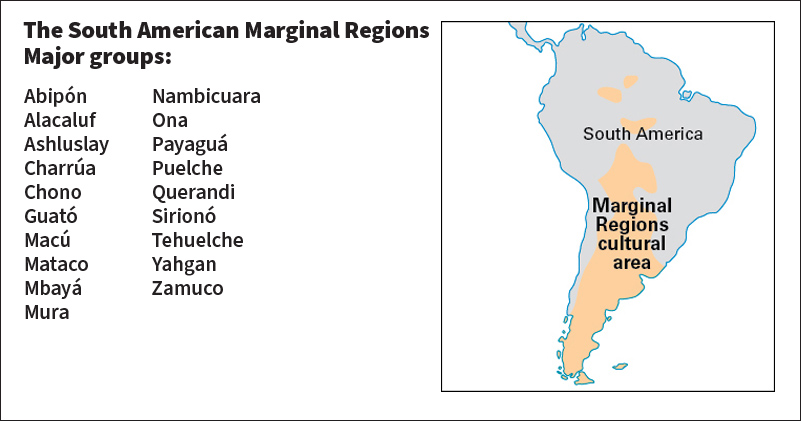
Before European contact.
Only small numbers of people lived in the Marginal Regions. They roamed about in bands of 50 to 150 people searching for food. Most tribes gathered wild seeds and fruit and hunted small game for food. In the northern area, the Gê-speaking tribes also planted sweet potatoes and yams. In the south, the Tehuelche and Ona relied heavily on such large game as the rhea and guanaco. Along the coast, shellfish were an important source of food. A few tribes lived by rivers and fished from dugout canoes.
The Marginal Regions people had only simple tools. The hunters used a device called a bola, which consisted of stone or clay balls attached to the ends of a rope. When thrown at a running animal, the balls of the bola wind the ropes around the animal’s legs and make it fall to the ground. The hunters also used bows and arrows, and spears and spear throwers. The people fished with nets, harpoons, spears, and bows and arrows. Most of the tribes did not make pottery. As a result, few families had cooking pots. Most food was roasted directly over the fire.
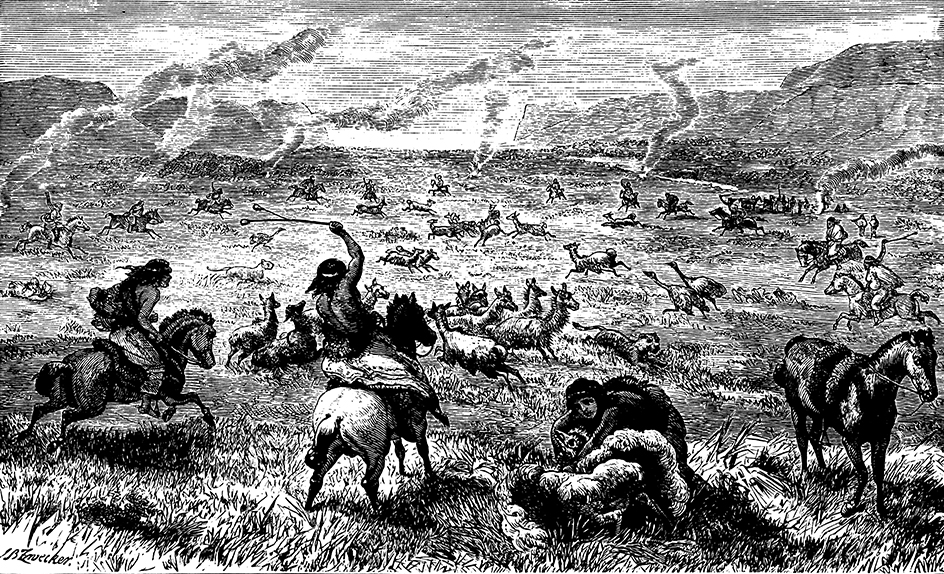
Most people of the Marginal Regions went naked or wore only brief skin garments, even in cold areas. They decorated their bodies with paint, tattoos, feathers, and ear, nose, and lip ornaments. Some tribes did not build houses of any kind. Others lived in caves or in shelters of branches and brush. Other houses were simple lean-to or pole structures covered with mats or skins.
After European contact.
The Europeans had little interest in the Marginal Regions. But enough contact between European and Indigenous people took place to spread disease and change Indigenous ways of life.
After the white people brought horses to the plains, some rhea and guanaco hunters adopted a new way of life. These hunters became cowboys, called gauchos in South America. But mostly, the peoples of the Marginal Regions either died out or became part of the general population of the country in which they lived.
The destruction of Indigenous America
The arrival of Europeans in the Americas marked the beginning of the end of the way of life that many Indigenous peoples had known for centuries. Waves of European explorers, fur traders, missionaries, and settlers swept across the New World. Many settlers thought they were superior to Indigenous people and tried to force them to adopt European ways. Missionaries tried to persuade Indigenous groups to abandon their traditional religions and convert to Christianity.
Land became a major issue between the Europeans and Indigenous groups. The settlers wanted the land for farming, for grazing cattle, and for mining. They believed in the ownership of land. Most Indigenous Americans, on the other hand, generally considered themselves caretakers of the land. They believed that they did not own the land individually and therefore had no right to sell it or give it away. Consequently, when Indigenous people “sold” land, they might believe they were only agreeing to let the Europeans use it. The Indigenous people expected to keep hunting or farming there. When the settlers tried to keep Indigenous people off what the settlers now considered their property, fighting broke out. Through the years, more and more people were forced off their land as more and more newcomers arrived.
In Canada.
During the 1500’s, early French explorers claimed eastern Canada for France. The French were interested mainly in establishing trade with Indigenous people, and the two groups had relatively good relations. Some French traders married Indigenous women. Their descendants—that is, people of mixed French and Indigenous ancestry—became known as Métis.
During the 1600’s, English colonists began to move into eastern Canada. They claimed the land for England, and conflicts broke out between the English and the French. Between 1689 and 1763, the French and English fought four wars for control of North America. During these wars, some tribes sided with the French and others with the English. The wars ended with British victories, and as a result, Indigenous American tribes came under British control.
The British government set aside lands for Indigenous groups. In the 1800’s, it assigned groups of Indigenous people to reserves. The British Canadians and Indigenous people generally lived separately, but differences still arose between them. After settlers nearly killed off the buffalo on the Canadian plains, many people were left without their chief source of food and clothing. The death of the buffalo and disputes over land claims helped lead to two Métis rebellions. They were the Red River Rebellion (1869-1870) and the North West Rebellion (1885), which is sometimes called the Louis Riel Rebellion.
In 1867, the United Kingdom passed the British North America Act (now called the Constitution Act of 1867), which created the Dominion of Canada. The new government of Canada continued the earlier policy of confining Indigenous people to reserves. The superintendent general of Indian affairs was placed in charge of the reserves and of government dealings with Indigenous groups. Through the years, superintendents negotiated a number of treaties for western lands.
The Canadian government focused on assimilating (integrating) Indigenous people into mainstream Canadian society. Parliament passed legislation calling for elected tribal governments to replace traditional hereditary leadership. Other laws allowed the government to order Indigenous children to be sent to boarding schools, where they could be taught white customs away from the influence of their families. Laws of the late 1800’s banned certain Indigenous religious practices, including the sun dance.
The Indian Act of 1876 summarized laws concerning who could legally be considered an Indigenous person. People who met the legal definition were known as status Indians. They did not have to pay taxes on reserve property and had certain other privileges. But they could not vote in provincial and federal elections and were denied many other civil rights held by Canadian citizens.
The Indian Act also furthered the government’s policy of enfranchisement. This policy involved the voluntary rejection by male status Indians of their tribal identity. In choosing to become enfranchised, Indigenous men gained the right to vote and other privileges held by other Canadians. On the other hand, the so-called enfranchised Indians lost their legal and treaty rights as Indigenous people as well as their right to live on a reserve. An Indigenous woman became enfranchised if she married a non-Indigenous man. Many Indigenous people opposed enfranchisement, seeing it as a threat to their traditional way of life and their tribal identity. Through the years, relatively few Indigenous people chose to become enfranchised.
In Latin America.
Some scholars estimate that from 15 million to 80 million people lived in Latin America when European people arrived. The Spanish and Portuguese conquerors soon spread over the land, searching for gold, silver, precious stones, and other riches. Most Caribbean peoples did little to oppose them, and the Europeans quickly overcame the Indigenous groups in the highland areas of Central and South America. Hernán Cortés conquered the Aztec in Mexico between 1519 and 1521. In Peru, Francisco Pizarro overturned the Inca empire in the early 1530’s.
Other Spanish explorers led expeditions into other areas of Latin America and pushed all the way to the southern tip of South America. Most won relatively easy victories against Indigenous groups. Some peoples, including the Maya of Yucatán and the Mapuche of Chile, fought back. Large numbers of Indigenous people in Latin America were killed in warfare or died of diseases carried by Europeans. By 1600, most Indigenous societies of Latin America had yielded to European control.
During the early 1500’s, Spain established the encomienda system in Latin America. Under this system, the Spanish king granted colonists the right to collect payments from Indigenous people living on certain large tracts of land. The Spanish landowners forced the people to farm the land or work in mines. Eventually, the colonists claimed ownership of the land. Thousands of Indigenous people died from overwork and harsh treatment. Some of them escaped by fleeing to remote inland areas.
Spanish threats to Indigenous peoples’ ways of life were not limited to forcing them to work for the colonists’ profit. The Spaniards also weakened traditional tribal bonds by resettling individual members of tribes so that they would have little contact with one another. In some cases, they were moved onto congregaciones, specially designed villages where they could be taught Christianity and European customs and manners.
During their rule in Latin America, the Spaniards created a class structure based upon race. In general, the Spaniards themselves—white people—constituted the highest class. Mestizos (people of Indigenous and Spanish descent) and people of Black African and Spanish ancestry formed the next class. The lowest class was made up of Indigenous people and enslaved Black people.
In the United States.
Most of the early English settlers who came to what is now the United States wanted to start new lives and make new homes for their families. At first, the British and colonial governments tried to deal with the Indigenous groups through negotiation and treaties. The settlers and the Indigenous people had fairly friendly relations. But as Indigenous people sought to protect their land from the claims of increasing numbers of newcomers, fighting broke out between the two groups.
After the Thirteen Colonies declared their independence from Britain, the government of the new United States became responsible for dealing with Indigenous peoples. In 1778, the United States and the Delaware people signed a treaty—the first between the new nation and a Native American tribe. Nearly 400 other treaties followed. In these pacts, tribes typically agreed to keep peace with the settlers and to recognize the jurisdiction of the U.S. government. Each tribe gave up much of its territory and kept only a part for itself. The federal government promised a cash payment and protection in return for the land it obtained from the tribe. In most cases, the government also agreed to supply Indigenous people with livestock, manufactured goods, and medicine.
Under the Constitution of the United States, treaties with Native American tribes were as legally binding as agreements with other nations. But many of the treaties were broken as increasing numbers of settlers entered lands reserved for Indigenous people.
The United States government saw the need for a special agency to deal with trade, negotiations, and other matters involving Indigenous people. In 1824, it established the Office of Indian Affairs (now the Bureau of Indian Affairs) and placed it under the control of the War Department. In 1849, the office became part of the Department of the Interior.
Indian removal.
In 1830, Congress passed the Indian Removal Act. This act was designed to free more eastern land for white settlement. It allowed the president to move Native American tribes in the east to land west of the Mississippi River. The land in the West became known as the Indian Territory. This huge reservation spread across what are now Oklahoma and parts of Kansas and Nebraska.

United States military patrols supervised Native American groups during the westward journey. According to some estimates, the U.S. government had moved more than 70,000 Native Americans across the Mississippi by 1840. Thousands of Cherokee, Chickasaw, Choctaw, and other Native Americans died on the journey westward.
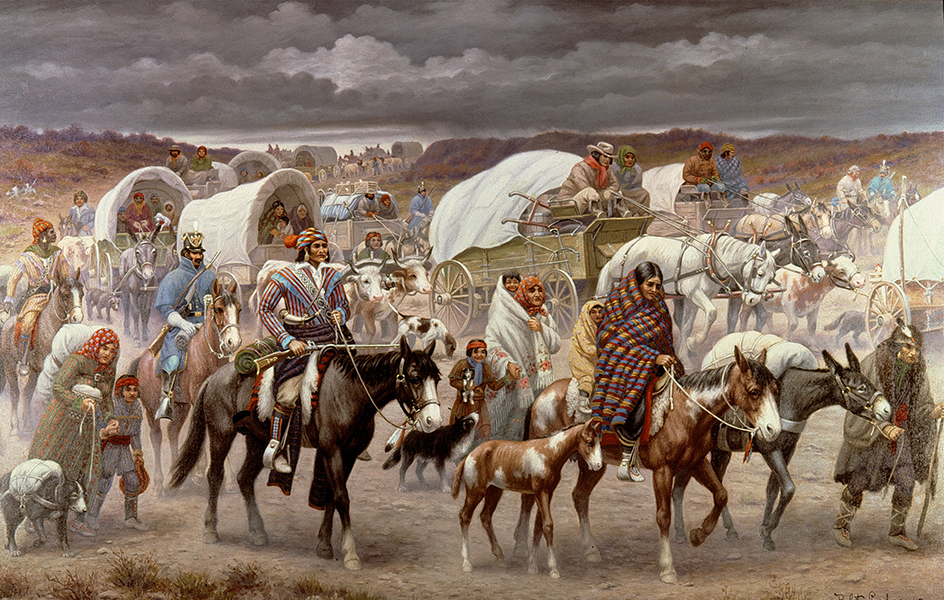
Treaties with the United States guaranteed the lands of the Indian Territory to the Indigenous peoples who had moved from the East. Eventually, however, settlers wanted that land as well, and the territory was reduced. Meanwhile, settlers were pushing into other Native American lands in the West all the way to the Pacific Ocean. The discovery of gold in California in 1848 also brought prospectors who killed the game on which many Western tribes depended. Native Americans fought to keep their lands but were finally defeated. The U.S. government placed the various tribes on isolated reservations, mainly in the West.
New policies.
In 1871, Congress concluded that the tribes were no longer separate, independent governments. This action freed the United States from the need to make treaties with Indigenous peoples. Then, in 1887, Congress passed the General Allotment Act, also called the Dawes Act, to break up tribal lands into small property units. In general, each eligible head of a Native American household received a parcel of 160 acres (65 hectares). Most single Native Americans received 40 or 80 acres (16 or 32 hectares). Land that remained after all eligible Native Americans had received their shares was sold to white people, thereby freeing more land for white settlement.
Through the Dawes Act, the government hoped to encourage Indigenous people to become farmers. The government also hoped to assimilate them into non-Indigenous society. But many Indigenous people had no knowledge of farming, and others had no interest in it. Also, much of the land allotted to Indigenous groups was unsuitable for growing crops. As a result, many people sold their lands and lived off the money they received. When that money ran out, these people had no means of support. Some white people settled illegally on Indigenous lands, and the government had difficulty evicting the intruders. In addition, many Indigenous people were cheated out of their land by corrupt land speculators.
Indigenous Americans in the 1900’s
In Canada.
In the early 1900’s, the Indigenous people of Canada continued to lose land to settlers and to lack equal rights. In 1951, Parliament passed another Indian Act, which primarily restated previous policy. In 1985, the act was amended so that Indigenous women would no longer automatically forfeit their Indigenous status if they married non-Indigenous men.
In 1966, Parliament established the Department of Indian Affairs and Northern Development (DIAND). The department was designed to supervise and promote economic and political development of Indigenous lands. It was also supposed to administer the Indian Act with federal funds and programs. Through the years, DIAND’s role expanded to include the supervision of such matters as Indigenous treaty claims, environmental protection, and management of natural resources. DIAND’s responsibilities later were overseen by Crown-Indigenous Relations and Northern Affairs Canada.
Since the late 1960’s, several national organizations have worked to promote First Nations, Inuit, and Métis land claims and civil rights. They have sought to develop new political relationships with the Canadian and provincial governments. These groups include the Assembly of First Nations, the Inuit Tapiriit Kanatami (formerly the Inuit Tapirisat of Canada), the Métis National Council, and the Congress of Aboriginal Peoples (formerly the Native Council of Canada).
In Latin America,
much of the political and economic power lay in the hands of the large landowners. During the early to mid-1900’s, Indigenous Latin American peoples engaged in protests and armed uprisings to demand social, political, economic, and land reform. In Mexico, for example, many people joined mestizo leader Emiliano Zapata in fighting the government in the early 1900’s. Indigenous people also took part in reform movements in Bolivia, Chile, Peru, and other countries. These movements succeeded in breaking up some large estates and dividing the land among Indigenous groups. Despite such successes, however, most Indigenous people continued to live in poverty and to lack political rights.
During the early years of the European colonization of Latin America, some Indigenous people had retreated to remote inland areas. There they largely kept their old ways of life and had little contact with the Europeans. But as the countries of Latin America expanded during the 1900’s, settlers started moving into areas that white people had previously not wanted. They cleared the land for farms, dammed rivers for hydroelectric power plants, and cut down the rain forest for lumber. All these actions threatened Indigenous lands and culture.
In the United States,
the federal policy of land allotment to individual Native Americans remained in effect during the early 1900’s. In general, the allotment policy and other government programs aimed at assimilating Native Americans into the U.S. mainstream. For example, many Native American children were sent to boarding schools away from their homes where they were not allowed to practice traditional customs or speak Indigenous languages. The Bureau of Indian Affairs (BIA) also banned certain religious ceremonies.
Citizenship.
Before the 1920’s, members of certain tribes had acquired U.S. citizenship through treaties. Others received it by procedures established in the Dawes Act and its amendments. In 1924, Congress passed the Indian Citizenship Act, which gave citizenship to every Indigenous person born within the territorial limits of the United States. Indigenous people who live on reservations pay most federal and state taxes, but they pay no taxes on reservation lands and property or on income earned from them. Indigenous people outside reservations pay the same taxes as other citizens do. All Native Americans have full voting rights.
The Indian Reorganization Act of 1934.
By 1900, the Native American population in the United States, which may have been between 10 million and 15 million before contact with the Europeans, had declined to a low of about 240,000. Most Indigenous people lived on reservations by the early 1900’s, and many were poverty-stricken and in poor health. From 1926 to 1928, statistician Lewis Meriam directed a national study of these conditions. The results of the study, known as the Meriam Report, strongly recommended the end of allotment as a way of improving living conditions for Native Americans. The report called for a new policy that would reemphasize tribal communities and tribal governments.
In response to the Meriam Report, Congress passed the Indian Reorganization Act of 1934. This legislation restored tribal ownership of unallotted reservation lands and prohibited further allotments. It set up a credit fund for economic development. It also encouraged reservation residents to take a more active role in managing their affairs. The legislation provided for limited self-government through tribal councils elected by the adults of a tribe and overseen by the BIA. These councils direct many of the tribe’s activities and represent it in dealings with local, state, and federal governments.
In 1944, Indigenous leaders founded the National Congress of American Indians to provide a strong Indigenous voice on Native American affairs. This group became the most important national all-Indigenous political organization in the United States.
During World War II (1939-1945), about 25,000 Native Americans served in the military and over 50,000 worked in war industries. After the war, many Native Americans discovered that they no longer fit into their traditional communities. In 1952, the federal government created a relocation program to help Native Americans relocate to cities and adjust to city life.
The termination policy.
In 1953, Congress passed a resolution that called for ending federal support and protection of certain Indigenous tribes. The policy, called termination, was designed to absorb Native Americans into the broader U.S. culture. In most cases, however, termination took place too quickly and with too little preparation for independence. Also, Native Americans faced discrimination within the mainstream culture. Eventually, opposition to the termination policy caused the government to abandon it. Many of the tribes that had been “terminated” under the policy then campaigned to regain their official tribal status.
The push for Indigenous rights.
During the 1960’s and 1970’s, some Indigenous groups began to urge members to be more forceful in seeking economic and political equality. In 1968, the American Indian Movement (AIM) was founded to work for equal rights and better living conditions for Native Americans. AIM held a number of protests and take-overs. In 1972, for example, AIM and other Indigenous-rights groups took over the BIA building in Washington, D.C. The protesters’ demands included a review of U.S. treaty violations and the establishment of improved educational and economic programs.
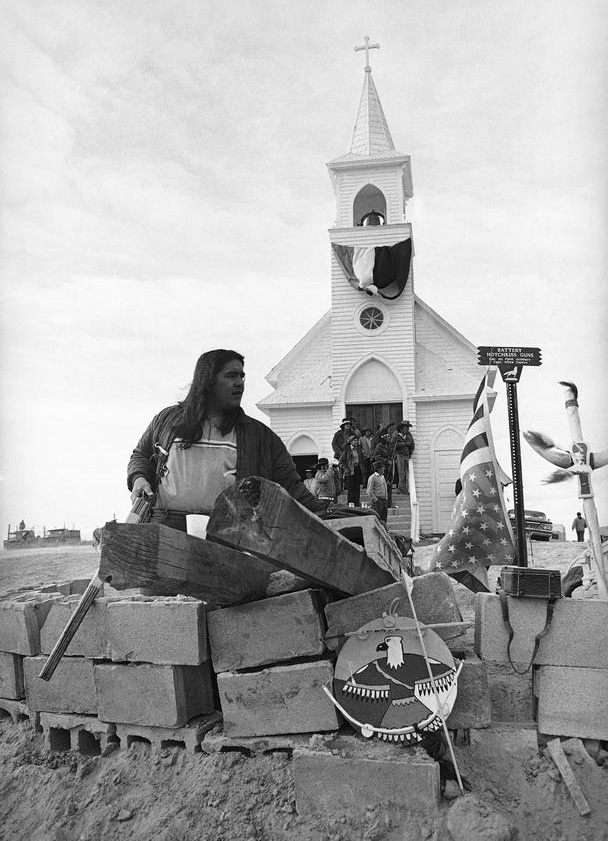
Several other national Indigenous groups were formed during the 1960’s and 1970’s. They included the Native American Rights Fund, which furnishes legal aid to protect Indigenous lands and resources; the National Indian Education Association, which works to provide better education for Native American students; and the Council of Energy Resource Tribes, which promotes good management of oil and other energy resources.
The United States government addressed some Native American concerns through legislation, executive orders, and court decisions. In 1970, for example, Congress passed a law returning Blue Lake in New Mexico to the Taos Pueblo people. In 1971, Congress passed the Alaska Native Claims Settlement Act, which gave money to the state’s Indigenous peoples and settled land claims, reserving about 40 million acres (16 million hectares) for these peoples. President Richard M. Nixon issued an executive order for the return of Mount Adams and other lands to the Yakama of Washington in 1972.
In 1978, Congress approved a land settlement for the Narragansett tribe of Rhode Island. The tribe received 900 acres (360 hectares) taken from their ancestors and funds to purchase a remaining 900 acres (360 hectares) from private owners.
In 1980, the administration of President Jimmy Carter negotiated a settlement with the Penobscot, Passamaquoddy, and Maliseet (also called Wolastoqiyik), who had sued to recover nearly two-thirds of Maine. The tribes agreed to drop their lawsuit in exchange for an $81 1/2-million settlement. Two-thirds of the money would be used to purchase a “permanent land base” for the tribes.
In 1980, the Supreme Court of the United States ordered the federal government to pay about $105 million to eight Sioux tribes. The money was payment for lands in South Dakota that the government seized illegally in 1877. The tribes refused the settlement and sought the return of part of the Black Hills in South Dakota as well as a cash payment.
Indigenous Americans today
About 45 million Indigenous people live in Latin America. Millions more have some Indigenous ancestry. More than half the people in a number of Latin American countries, including Bolivia, Ecuador, Guatemala, Mexico, and Peru, are Indigenous or have mixed ancestry. About 550,000 Canadians are registered as Indigenous by the Crown-Indigenous Relations and Northern Affairs Canada.
Nearly 4 million people of primarily Indigenous heritage live in the United States. The largest of the more than 570 tribes include the Cherokee, Choctaw, Lakota, Navajo, and Ojibwe (Chippewa). About a third of the Indigenous people in the United States live on reservations, traditional tribal lands, and other designated areas. Most make their homes in urban areas.
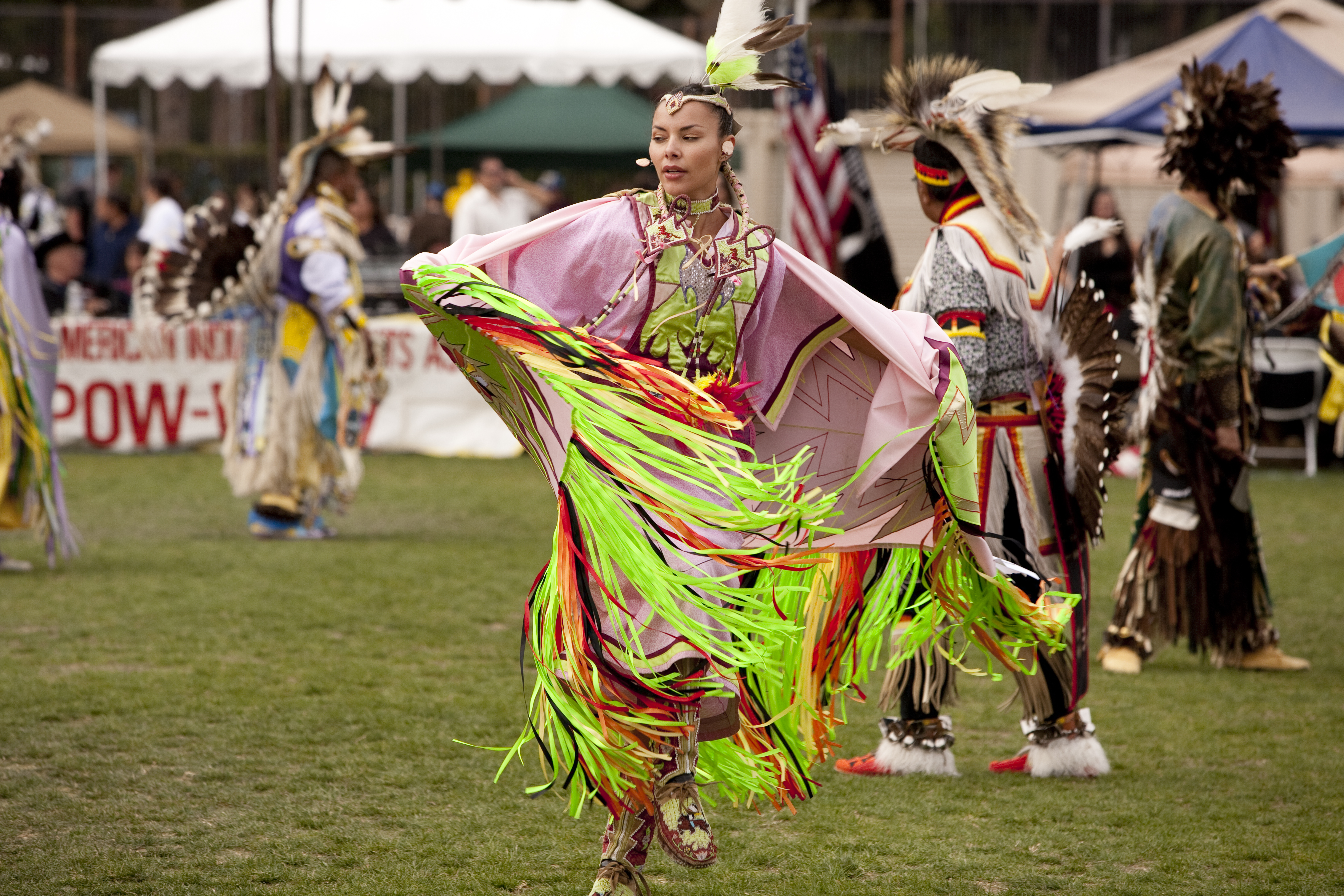
The preservation of Indigenous culture.
Tribal culture remains relatively strong on reservations, where many residents continue to practice ancient traditions. Nevertheless, many Indigenous Americans worry that assimilation into the mainstream society will lead to a loss of Indigenous identity and traditional ways. They point, for example, to the decline in the number of people who speak Indigenous languages. When Europeans first arrived in North America, at least 300 languages were spoken by Indigenous groups in what is now the United States and Canada. Today, fewer than 200 languages are still spoken, and many of them are used little or only by a few older members of a tribe. Only about 40 of the languages are spoken by people of all ages, including children.
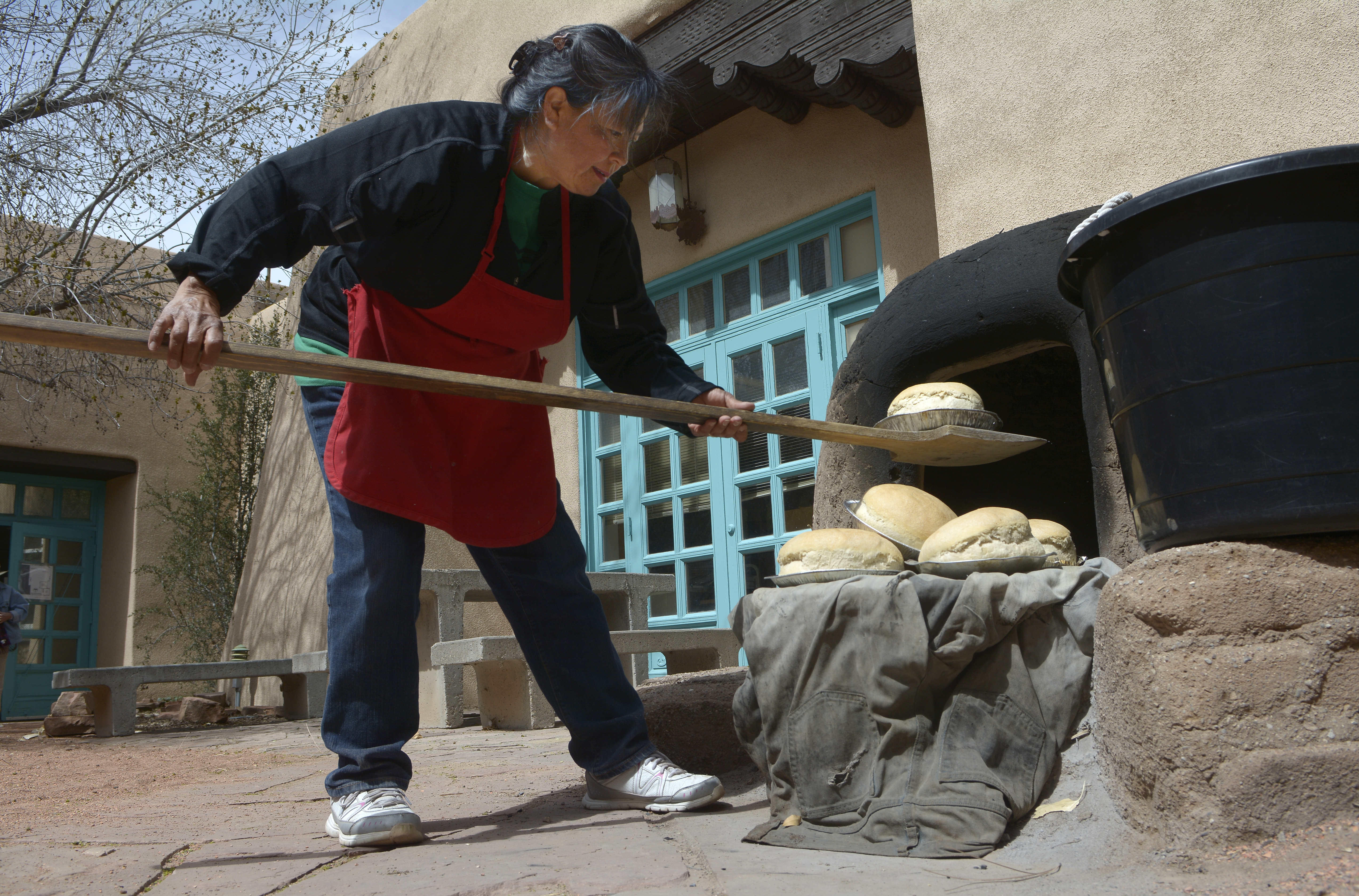
The movement of Indigenous people from reservations to urban areas has also had a major impact on the social structure of Indigenous communities. A large number of Indigenous people no longer depend on the community, as they once did, for help and support. Instead, they see themselves as individuals rather than as members of a community, and they have become more self-reliant. In addition, the small nuclear family—consisting of a father, a mother, and their children—has frequently replaced the larger network of extended families and clans as the major social unit.
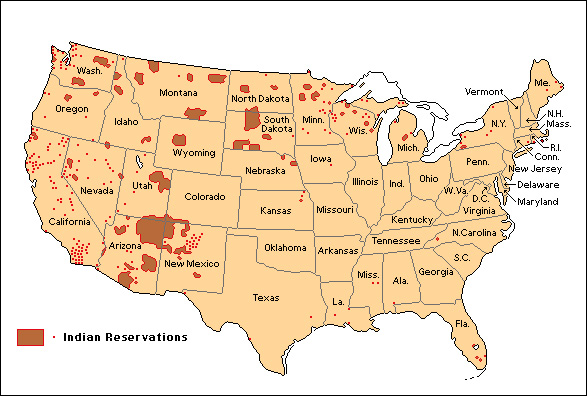
Social and economic progress
for Indigenous people has been made since the mid-1900’s. Gains in education, in particular, have provided Native Americans with better economic opportunities. In the 1960’s, Indigenous people in the United States, for example, averaged about 8 1/2 years of formal education. Today, the majority of young Indigenous people graduate from high school, and about 9 percent of all Indigenous people 25 years of age and older have a college degree. The number of Indigenous Americans who have entered law, medicine, and other professional fields has also increased. Since the 1980’s, a middle class of Indigenous professionals has emerged.
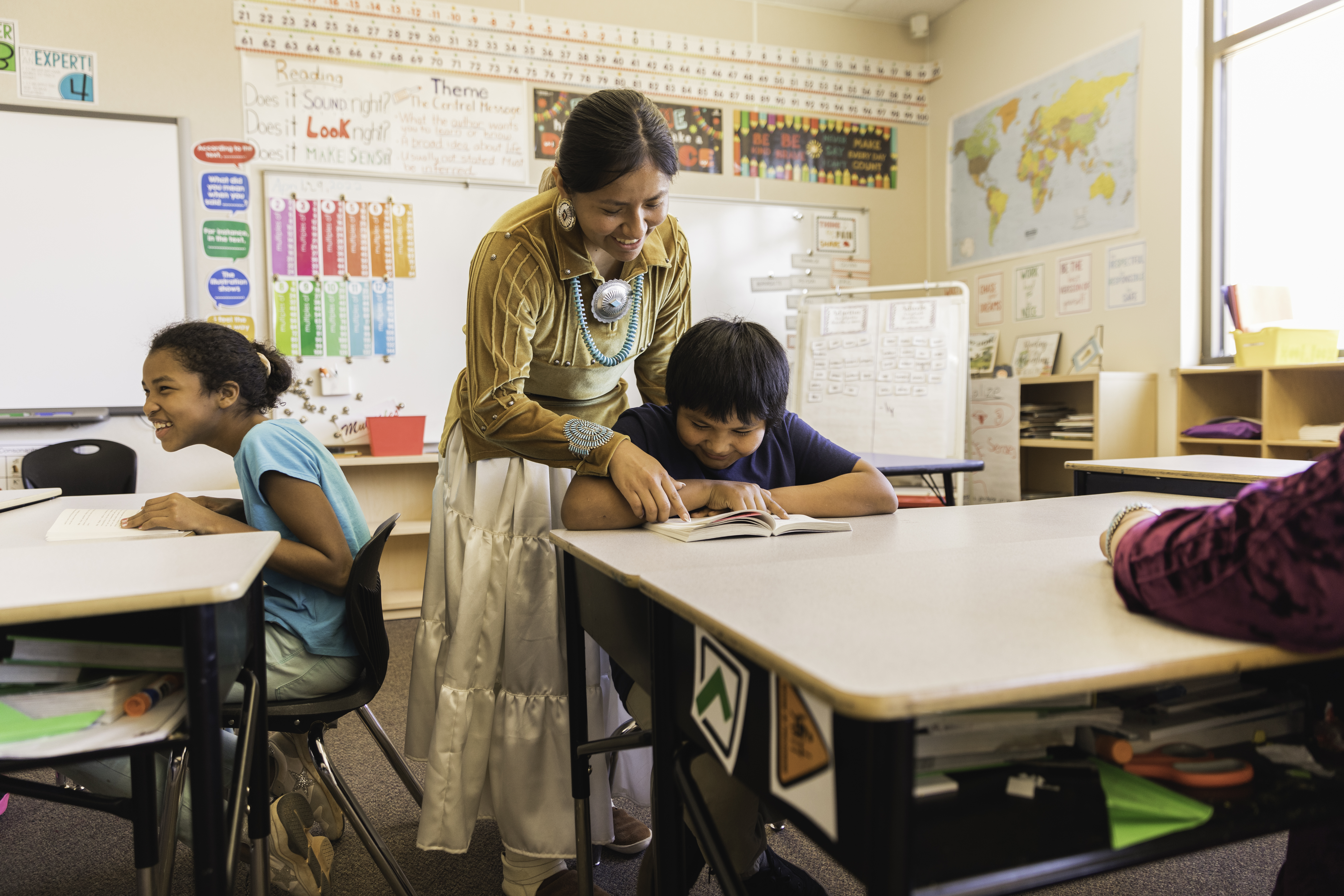
The economic situation of Indigenous people has improved for other reasons as well. During the mid-1970’s, federal funding aided tribes in starting their own companies. In addition, some tribes invested money won from land claim settlements into economic development. Today, a number of tribes operate successful industries. For example, the Navajo make electronic parts for missiles; the Choctaw manufacture parts for automobiles; and the Cherokee produce a variety of horticultural products.
In the late 1900’s, gambling casinos became an important source of revenue for many tribes. In 1979, the Florida Seminole demonstrated the tribe’s sovereignty by opening a high-stakes bingo hall not permitted by Florida state law. The Indian Gaming Regulatory Act, passed in 1988, provided for oversight of Native American casinos and established approved types of legal gambling on reservations. Such gambling operations provided many jobs for tribal members and aided other businesses, such as tourism and craftwork.
Some tribes get money by leasing rights to or taxing the production of oil, natural gas, and other minerals on their reservations. The Council of Energy Resource Tribes works to protect tribal interests in the use of natural resources on reservations. The lands of the more than 40 tribes in the United States that belong to the council are rich in coal, uranium, and other fuels.
In spite of the social and economic advances of Indigenous people, many problems remain. Unemployment on reservations in the United States averages 40 to 60 percent, and the average income per Indigenous family is significantly lower than the national average. Most Indigenous people in the work force hold low-paying, unskilled jobs. Alcoholism and depression are also serious problems in Indigenous communities. Suicide, homicide, and infant mortality rates are higher, and life expectancy is lower, among Native Americans than among the population of the United States as a whole. In 2019, the U.S. government began an initiative to reduce the frequency of murder and missing persons cases among Indigenous people. In both Canada and the United States, Indigenous women in particular have faced high rates of domestic violence, sexual assault, and murder.
Indigenous Americans often struggle to balance their traditional regard for the environment with their need for economic development. For example, tribes whose lands are rich in mineral resources face the question of how much mining can be done on their land without permanently damaging it.
Achievements in the arts.
A number of Indigenous American writers have won widespread acclaim for their works. In 1969, N. Scott Momaday, a writer of Kiowa and Cherokee ancestry, became the first Indigenous American to win the Pulitzer Prize in literature. He was honored for his novel House Made of Dawn. Other Indigenous American authors of note include Sherman Alexie, of Spokane and Coeur d’Alene ancestry; Michael Dorris, who was Modoc; Louise Erdrich, a member of the Turtle Mountain Band of Chippewa and the 2021 Pulitzer Prize winner for her novel The Night Watchman; Natalie Diaz, an Akimel O’odham and the 2021 Pulitzer Prize winner in poetry; Joy Harjo, a Muscogee and U.S. poet laureate; Leslie Marmon Silko of the Laguna Pueblo; and James Welch, who was of Blackfeet and Gros Ventre descent.
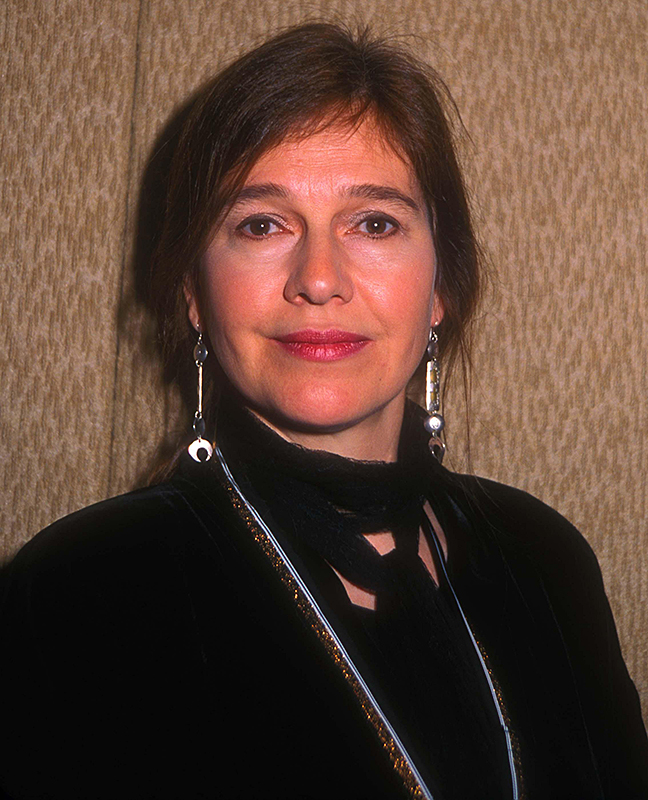
Maria Martinez, a Pueblo woman, revived pottery making as a fine art among the Pueblo of the Southwest in the 1900’s. A large number of people also prize such traditional craftwork as jewelry, finely woven rugs and blankets, and baskets. Indigenous groups also hold gatherings called powwows each year in a number of cities, including Chicago, Denver, and Los Angeles. Modern powwows are more festive versions of the traditional tribal meetings held to discuss problems. They feature traditional dancing, singing, and displays of arts and crafts.
Political gains.
Native Americans have had little representation in United States politics. There are some notable exceptions, however. Charles Curtis, whose mother was part Kaw (Kansa), became a U.S. senator and served as vice president of the United States under President Herbert Hoover. Robert Latham Owen, Jr., whose mother was part Cherokee, represented Oklahoma in the U.S. Senate from 1907 to 1925. Benjamin Reifel, a Lakota, served as a United States congressman from South Dakota from 1961 to 1971. In 1977, Forrest Gerard of the Blackfeet tribe took the newly created office of assistant secretary of the interior for Indian affairs. In 1993, Ben Nighthorse Campbell, a Northern Cheyenne from Colorado, became the first Native American to hold a U.S. Senate seat since Charles Curtis left the Senate in 1929. Also in 1993, President Bill Clinton appointed Ada E. Deer, a Menominee, to become the first woman assistant secretary for Indian affairs. Deb Haaland, a member of the Laguna Pueblo, became a U.S. congresswoman representing New Mexico in 2019. Haaland became secretary of the interior under President Joe Biden in 2021.
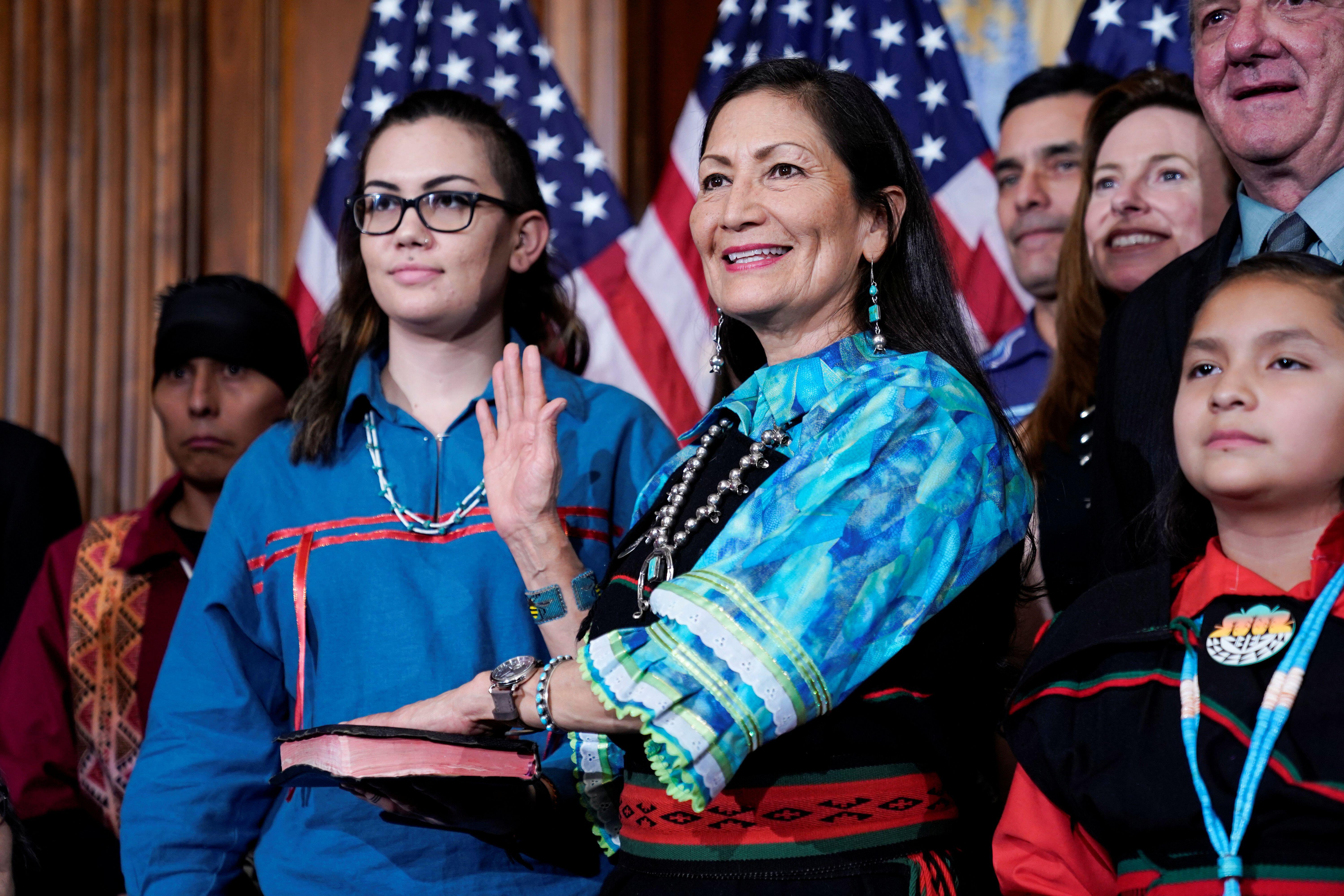
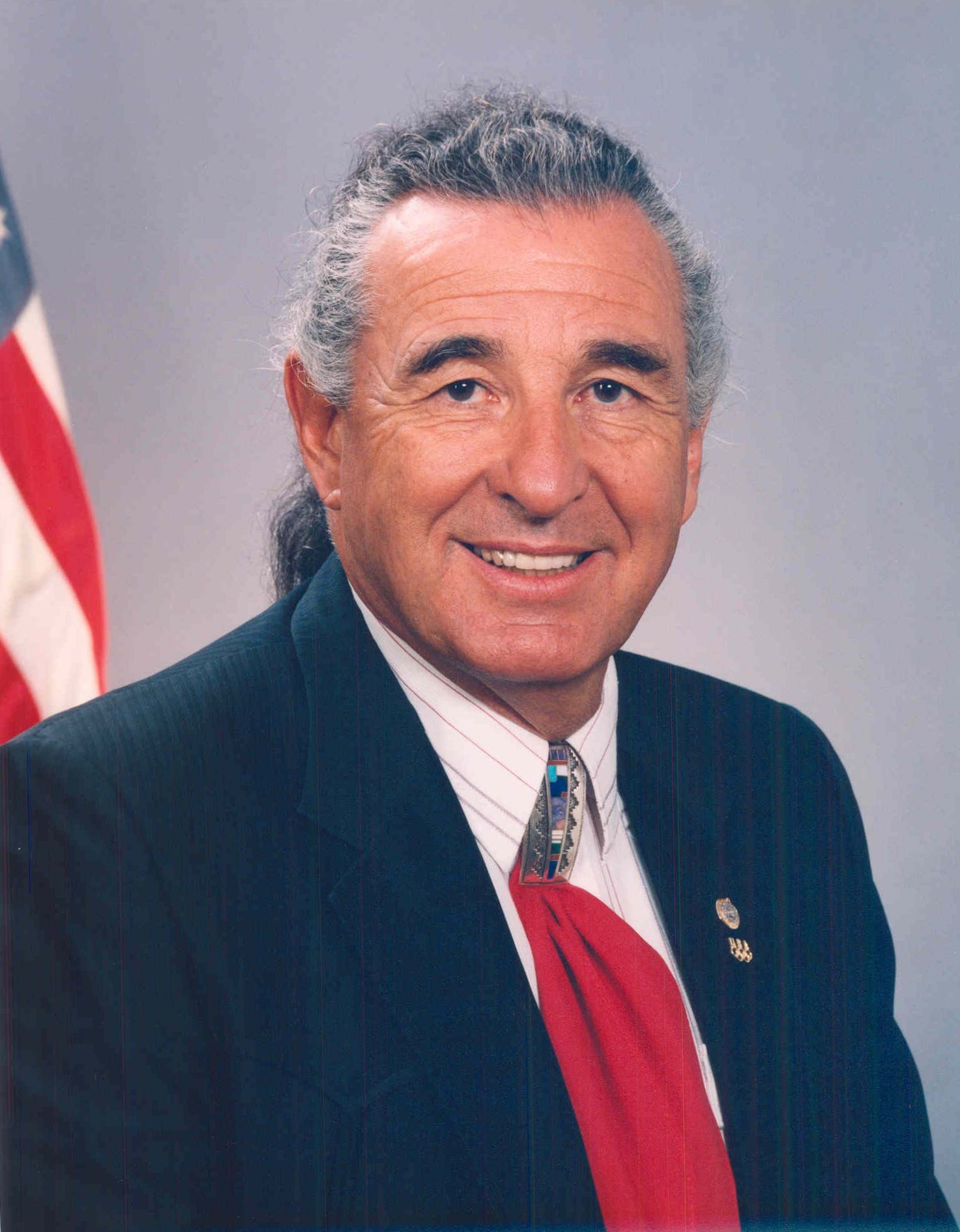
Despite the shortage of political leaders, Native Americans have lobbied successfully to have Congress enact some favorable legislation. In 1975, Congress passed the Indian Self-Determination and Education Assistance Act. This act allowed tribes to assume administrative control over federally funded programs for Native Americans. As a result, tribes could take over from the federal government management of their own community development, education, health, housing, and law enforcement programs.
The government has also expanded its recognition of the cultural identity of Indigenous tribes. A congressional resolution known as the American Indian Religious Freedom Act of 1978, for example, recognized the importance of Native American religions. The act declared that Native Americans should have the same right to the free exercise of religion as other citizens have under the Constitution.
Current issues
facing the various Indigenous peoples of North and South America are similar. Indigenous people continue to work to improve their economic, social, and political position and to protect the lands and rights guaranteed to them by treaty. They also seek respect for their cultural heritage.
In Canada,
First Nations people have continued their push for self-government and their efforts to protect their land. In 1990, for example, armed Mohawks in Quebec became involved in a long stand-off with police and Canadian armed forces. The dispute erupted over plans to expand a city-owned golf course onto what the Mohawk considered their ancestral burial grounds. The Canadian government eventually offered to turn the disputed land over to the Mohawk.
In 1991, the government proposed a plan to revise the Canadian constitution. Largely because of the efforts of First Nation, Inuit, and Métis organizations, the plan included a provision for self-government for Canada’s Indigenous peoples.
In 1992, voters in the Northwest Territories agreed on boundaries for a self-governing homeland for the Inuit in the eastern part of the territories. In 1993, the Canadian government passed legislation to create the new Inuit-controlled territory, called Nunavut. Nunavut came into existence on April 1, 1999.
In 2000, the Canadian government approved a treaty with the Nisga’a people of British Columbia, giving them land and the power of self-government. In 2003, the Canadian government signed the Tlicho Agreement. This pact provided for the transfer of ownership of about 15,000 square miles (39,000 square kilometers) of land in the Northwest Territories to the Tlicho (formerly Dogrib). It also provided for a Tlicho government that would function in cooperation with the territorial and federal governments. The agreement was ratified in 2005.
Also in 2003, Canada’s Supreme Court ruled that the Métis (people of mixed Indigenous and European ancestry) are entitled to the same hunting rights as Indigenous peoples with unmixed ancestry. The Constitution Act of 1982 had recognized the Métis as Indigenous people, but the Métis had not enjoyed the same rights as Canada’s other Indigenous groups. The court ruling opened the way for the Métis to pursue other special rights enjoyed by Indigenous peoples. These rights include health care benefits and freedom from certain taxes.
In Latin America,
many countries have tried to improve the welfare of Indigenous people. However, disputes have arisen between Indigenous groups and the governments of several Latin American countries. Government leaders frequently complain that the Indigenous people lack respect for national policies. The Indigenous people charge that the governments allow their lands to be damaged by agriculture, industry, or mining. In some cases, the disputes have erupted into violent clashes. The most serious conflicts have occurred in Guatemala. Thousands of Indigenous people died there in the 1980’s and 1990’s, and thousands of others fled to refugee camps in Mexico. Rigoberta Menchú, a Maya woman, won the 1992 Nobel Peace Prize for her efforts to gain equal rights for Guatemala’s Indigenous people.
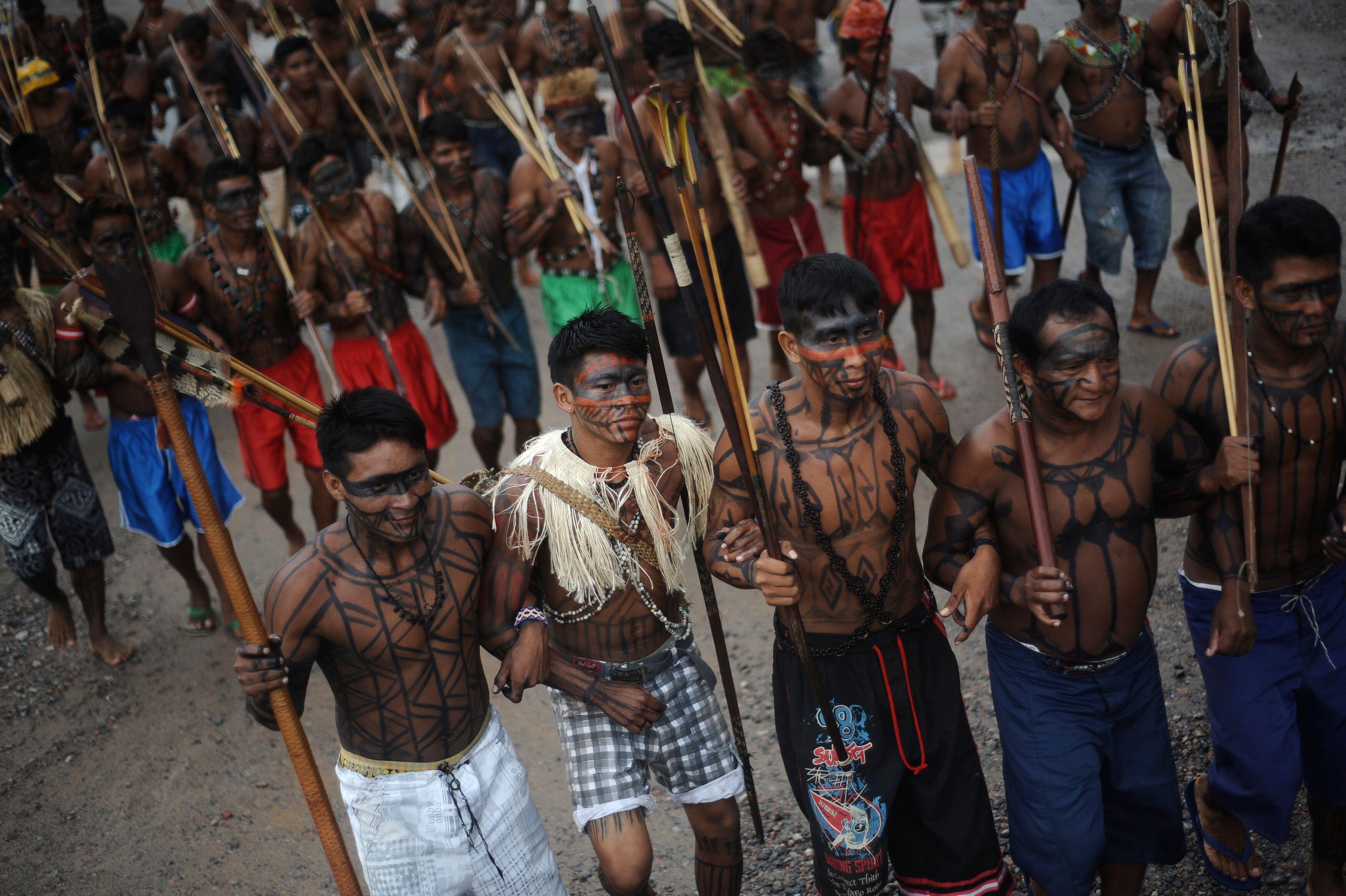
Beginning in 1987, gold prospectors poured into the Amazon rain forest of northwestern Brazil. This region was inhabited by the Yanomami, one of the last Indigenous groups whose culture remained relatively unchanged by contact with Westerners. Like the early Spanish explorers, the prospectors brought with them a variety of deadly diseases against which the Yanomami had no immunity. More than 1,000 Yanomami died. In addition, the miners began destroying the rain forest, where the Yanomami hunt and gather food. They also polluted the rivers and streams where the Yanomami fish. In the 1990’s, the Brazilian government made efforts to drive the prospectors out of the region. The miners soon returned, however.
In 1994, armed Indigenous rebels from the Zapatista Army of National Liberation seized and briefly held several towns in the Mexican state of Chiapas. The rebels, calling themselves Zapatistas after the mestizo leader Emiliano Zapata, demanded economic and political reform. They accused the Mexican government of ignoring the Indigenous people and called for economic aid and land reform. Government troops quickly drove the rebels from the towns. The Zapatistas retreated to jungle areas of Chiapas, and the government declared a cease-fire. Since then, the Zapatistas have continued to campaign against the poverty and discrimination faced by the Indigenous people of Mexico.
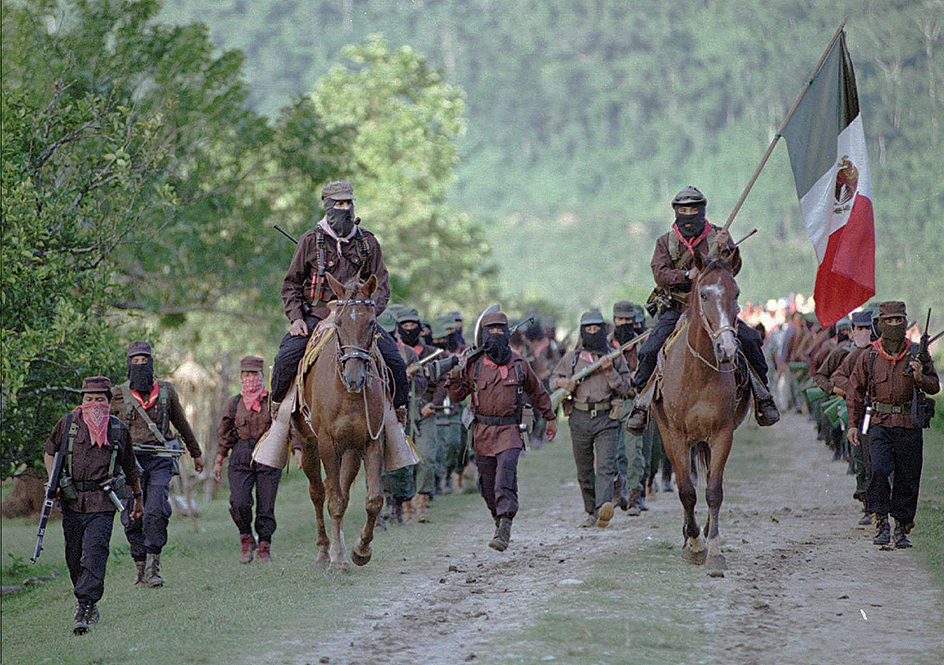
In the United States,
Native Americans continue to work for self-determination—that is, the right to control their own land and their own affairs without interference from the BIA or other federal agencies. Tribes are seeking to guard their hunting and fishing rights. They are working to control mining and similar operations on their lands. They are trying to protect their lands and waters from pollution. Many tribes are also going to court to regain lost lands or to receive payment for them.
Another goal of Native Americans is to be viewed as living people, and not according to preconceived or oversimplified beliefs. For example, many people object to the use of Native American names and mascots for sports teams. They say the use of such names and mascots is racist and promotes notions of Indigenous people as “warlike.” During games, sports fans have painted their faces and sung what they consider to be Native American songs or chants. These practices, say some people, insult Indigenous people and their religions. Native Americans paint their faces in a certain way for religious ceremonies and use songs in religious rituals. In the 2020’s, some sports teams changed their names and mascots after years of pressure from activists.
Many Native Americans have called for the return to tribes of Indigenous skeletal remains and artifacts currently kept in museums. They argue that the remains of their ancestors deserve a proper burial and should not be considered specimens for research or public display. They maintain that many of the artifacts are sacred and belong with Native Americans who will show them the appropriate reverence and respect.
To address the issue of the ownership of Indigenous remains and artifacts, Congress passed the Native American Graves Protection and Repatriation Act (NAGPRA) of 1990. This act requires institutions receiving federal money to return human remains and any artifacts found with them to the tribes that want them. However, the tribes must prove that they have a valid claim to the remains and artifacts.
Beginning in 2020, the worldwide spread of the COVID-19 respiratory disease became a major concern to Native American communities. In the Navajo Nation, for example, infection and death rates ranked among the highest in the United States. The prevalence of chronic health conditions and lack of modern infrastructure in many Native American communities contributed to the spread and deadliness of the disease. Many Native Americans also live in multi-generational households, where elderly or ill family members may be more vulnerable to infection.
In October 2021, President Joe Biden became the first U.S. president to formally recognize Indigenous Peoples’ Day. The day, which coincides with the Columbus Day federal holiday honoring Italian explorer Christopher Columbus, recognizes the people and cultures that thrived in the Americas before the arrival of Europeans.
